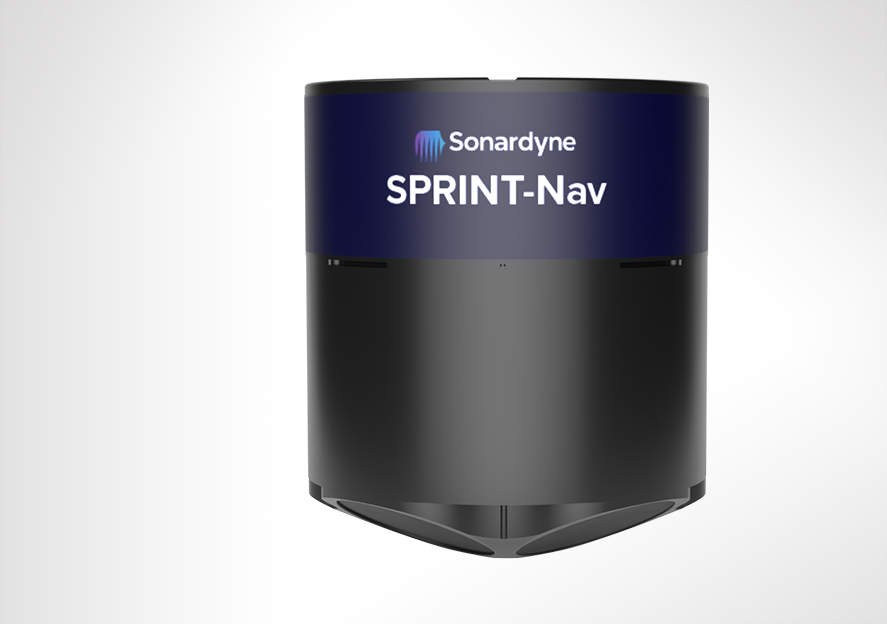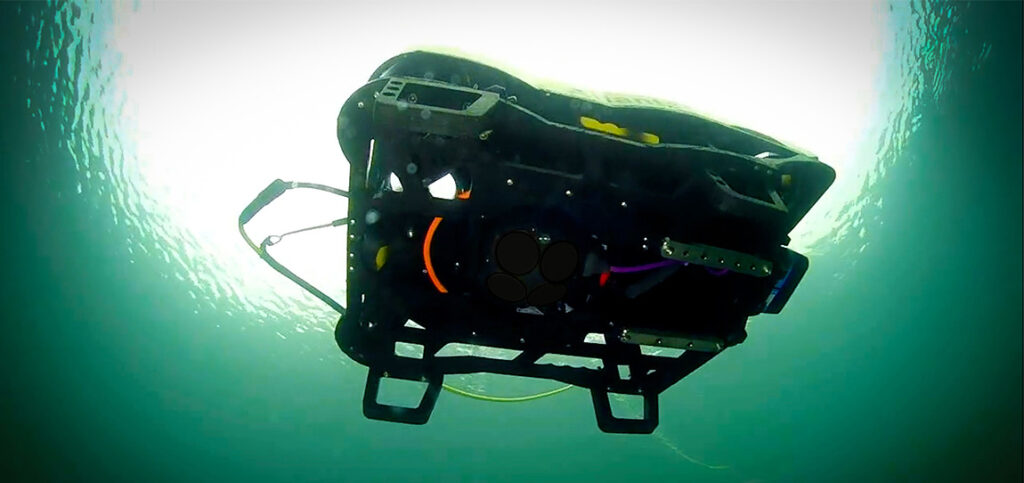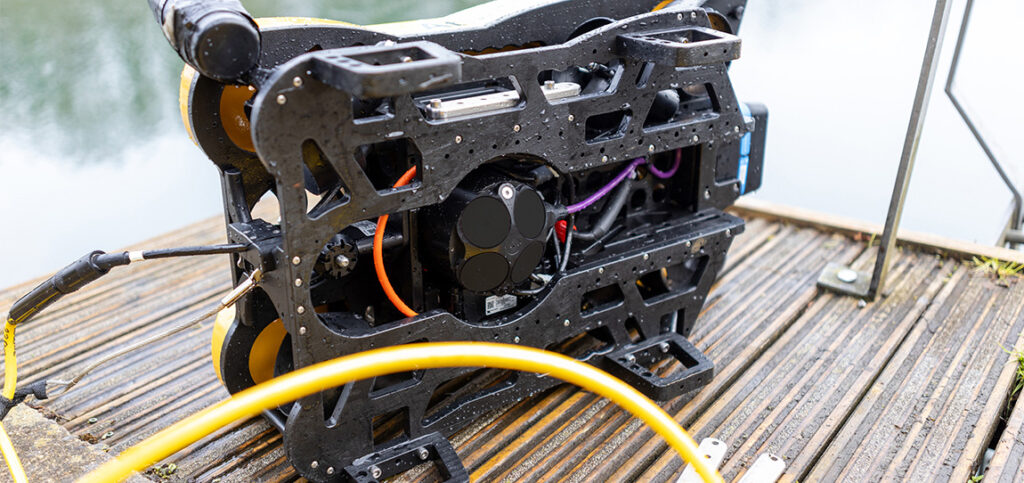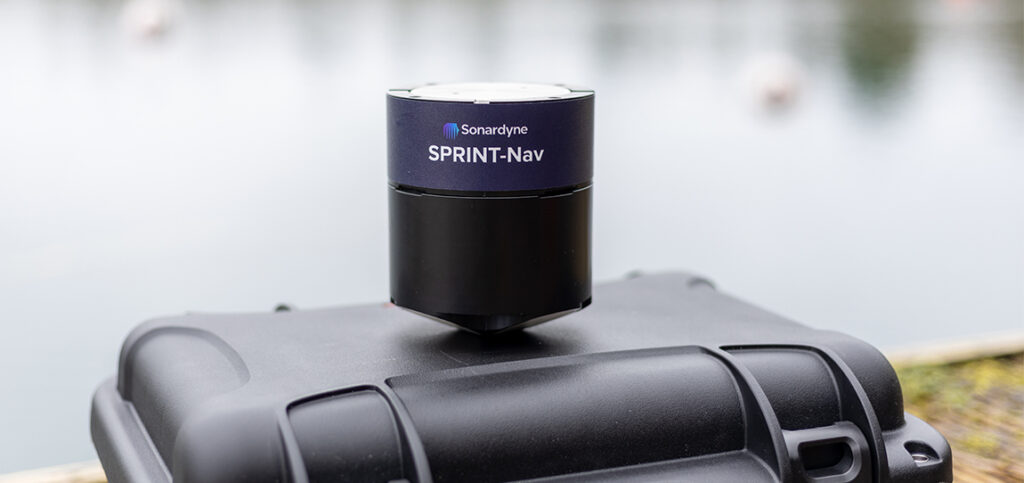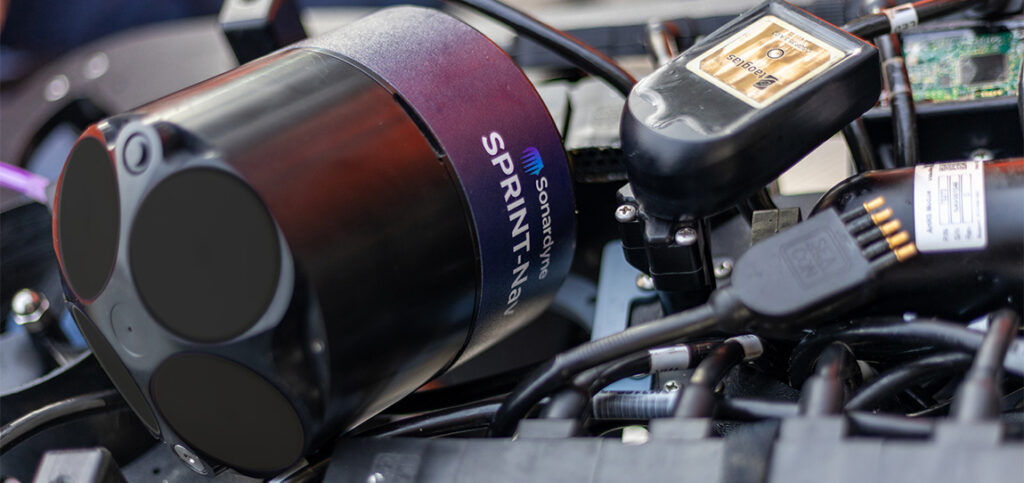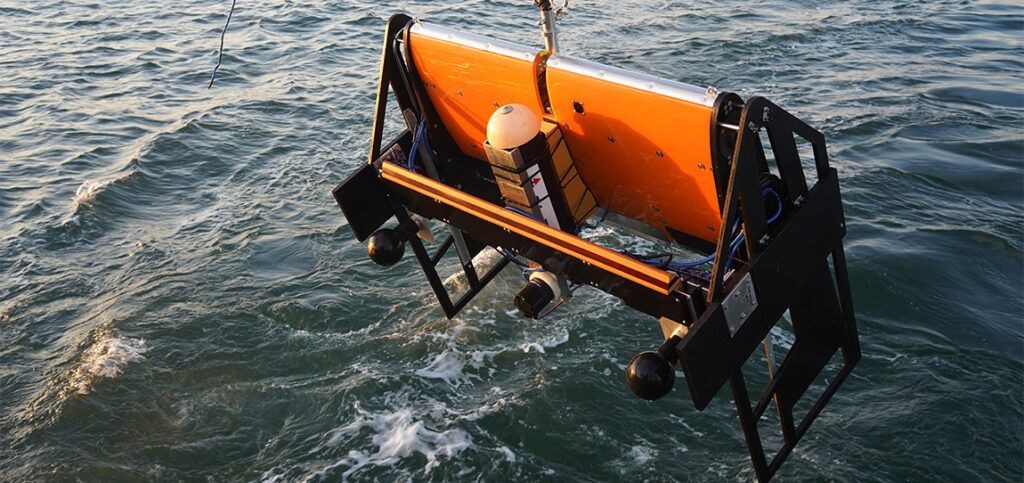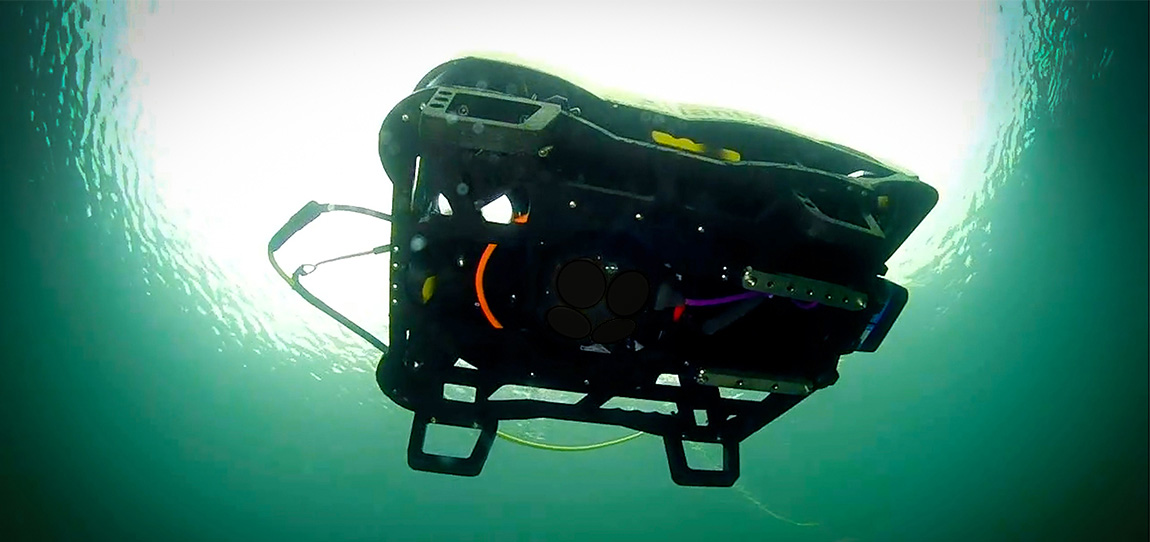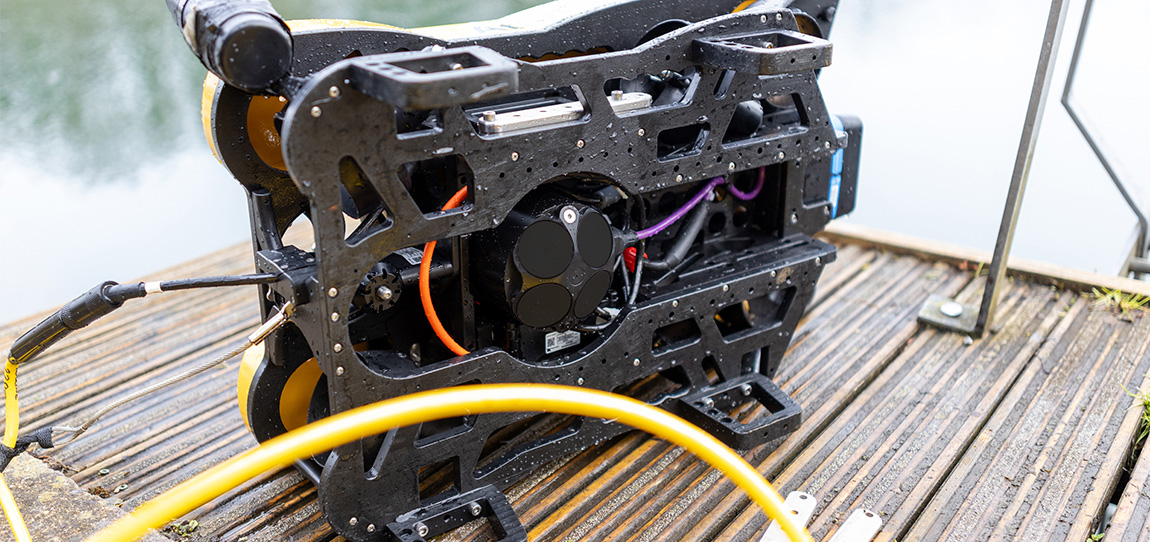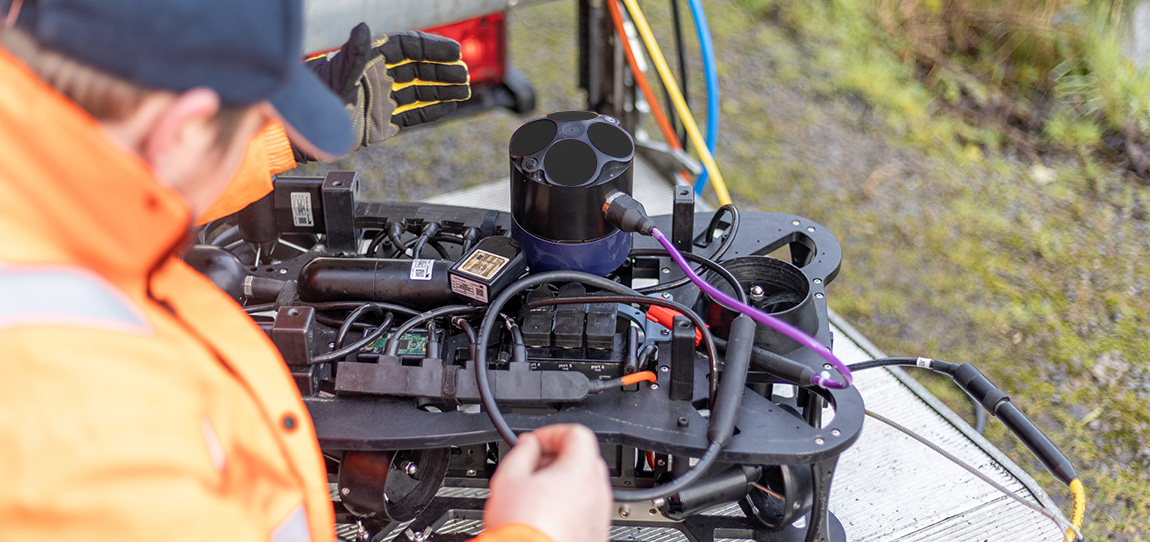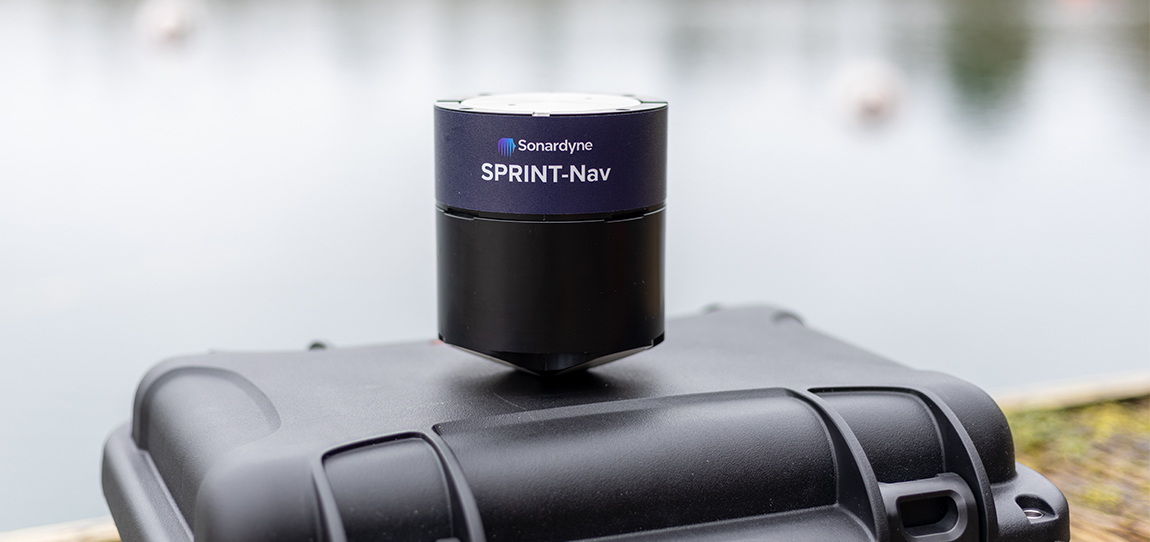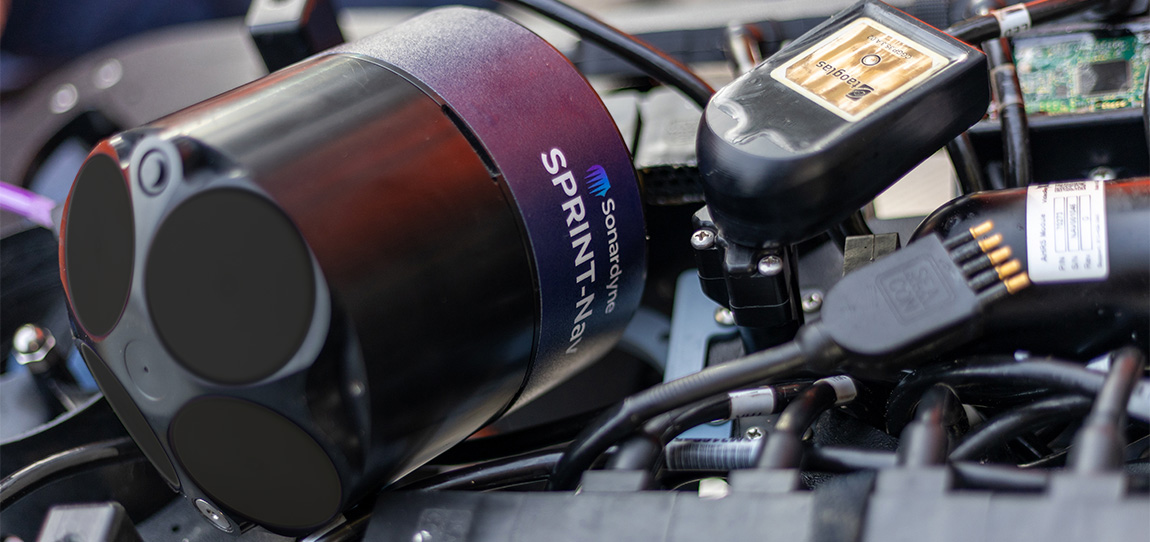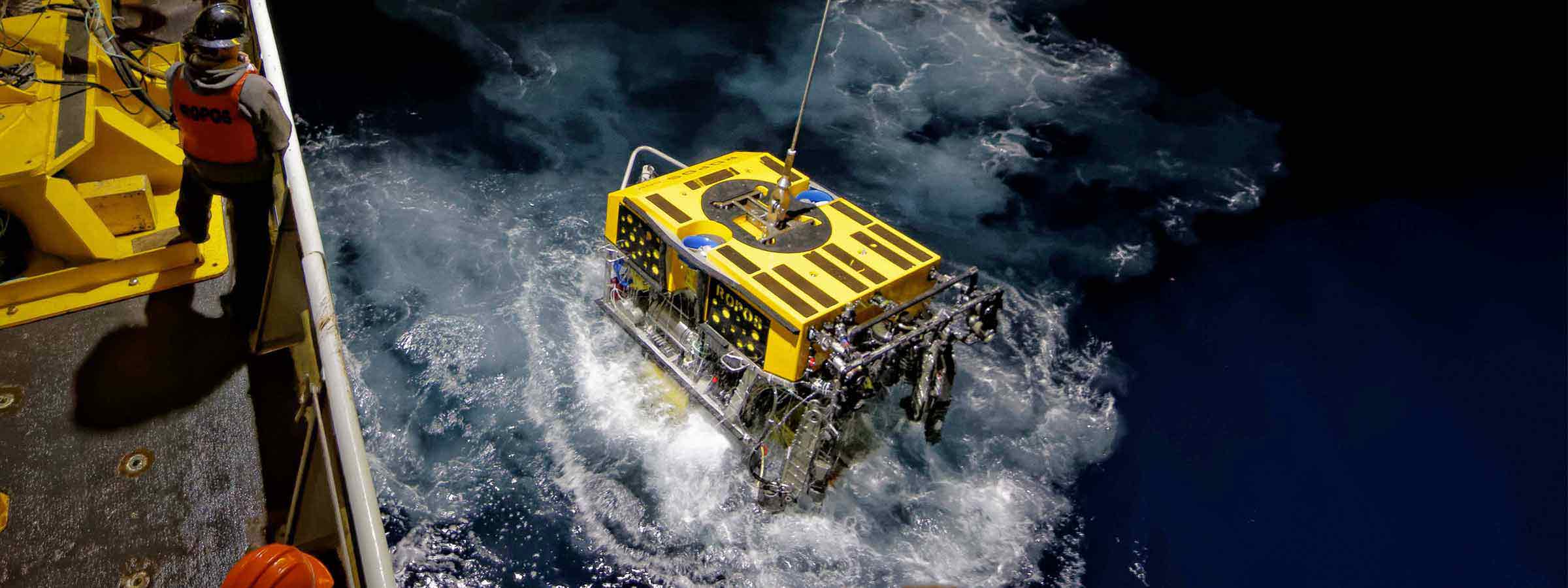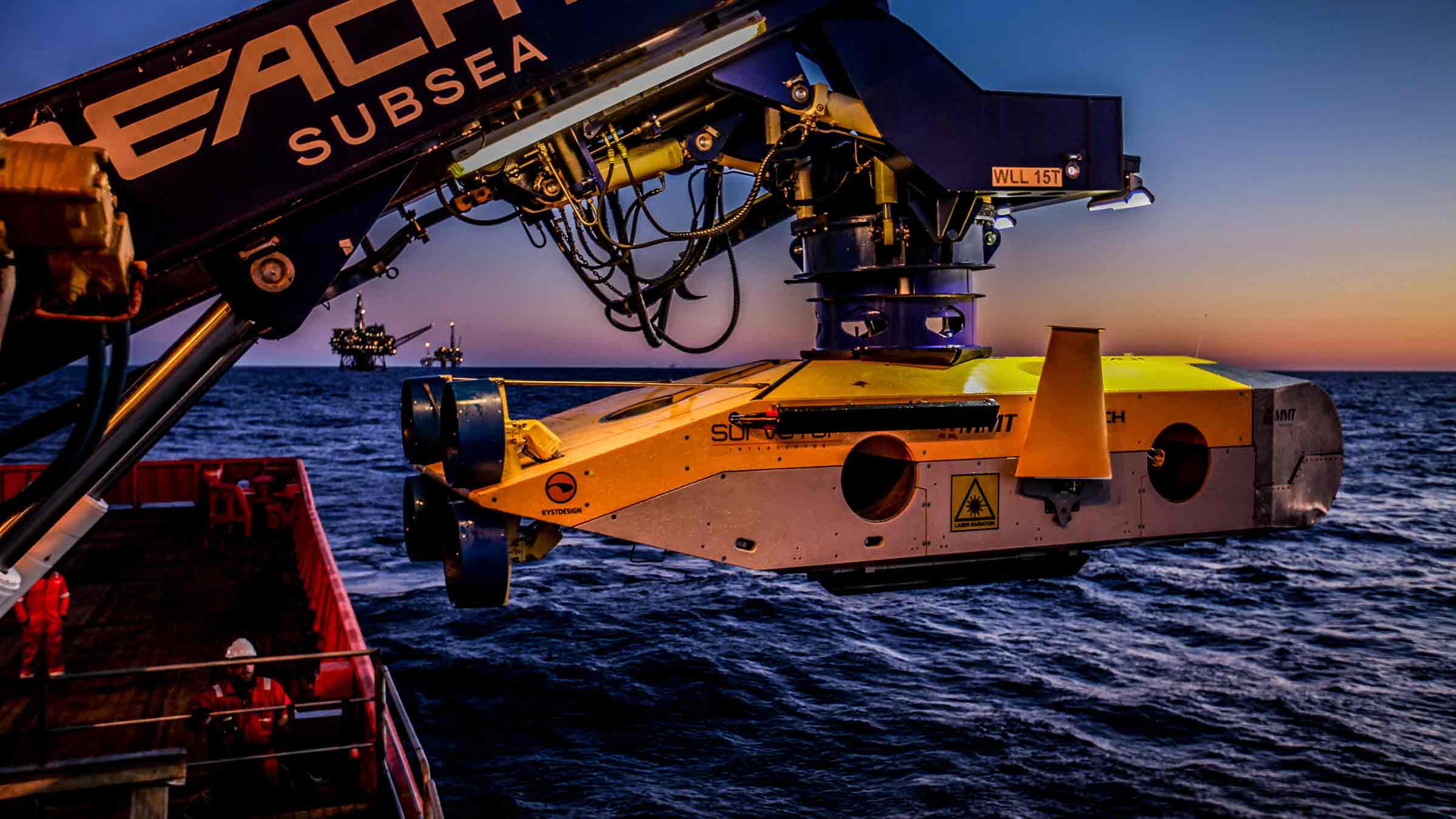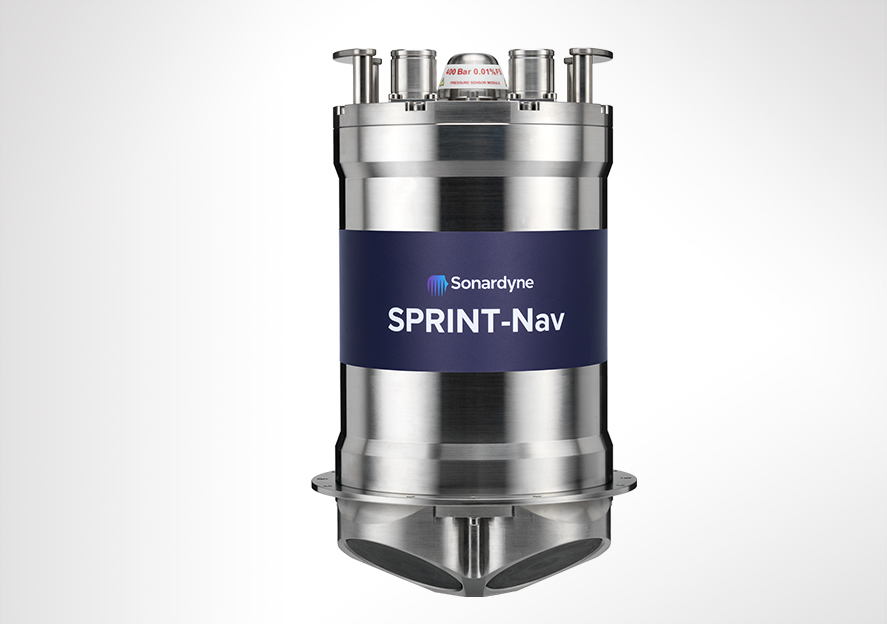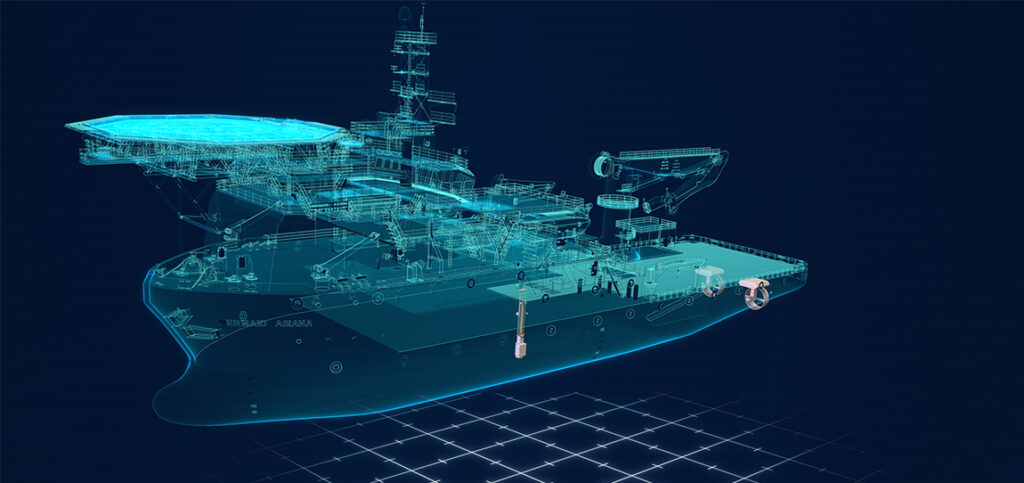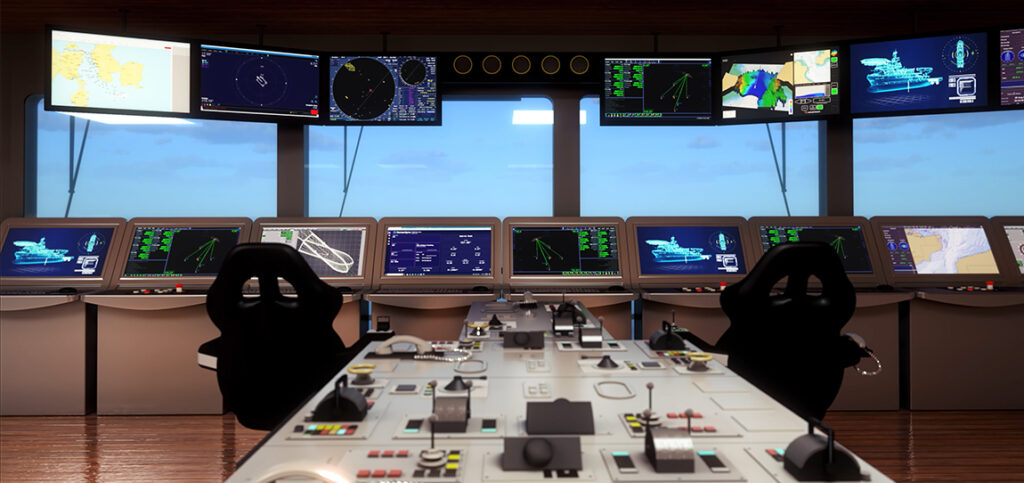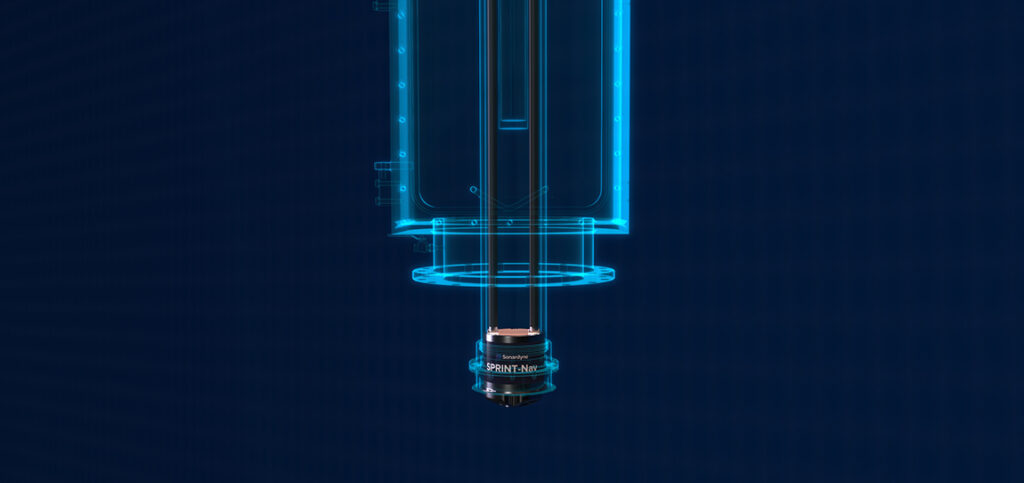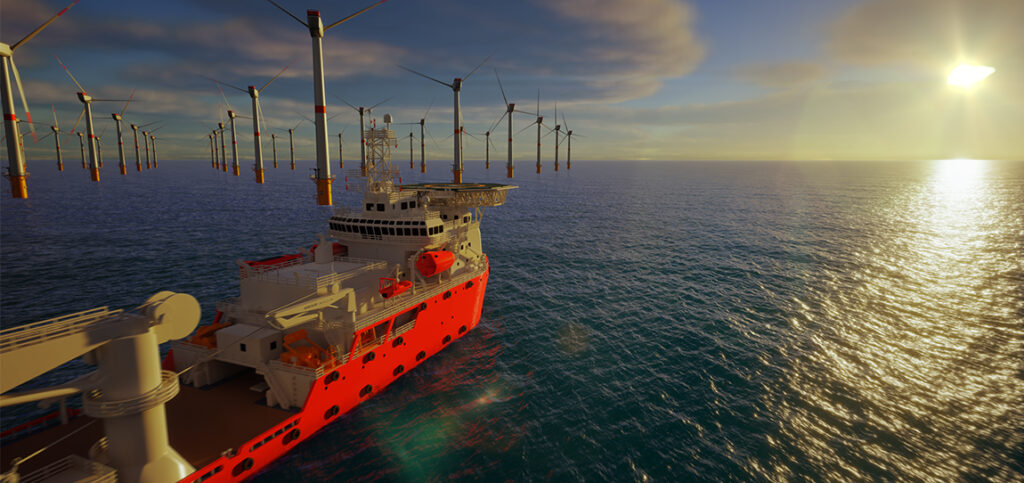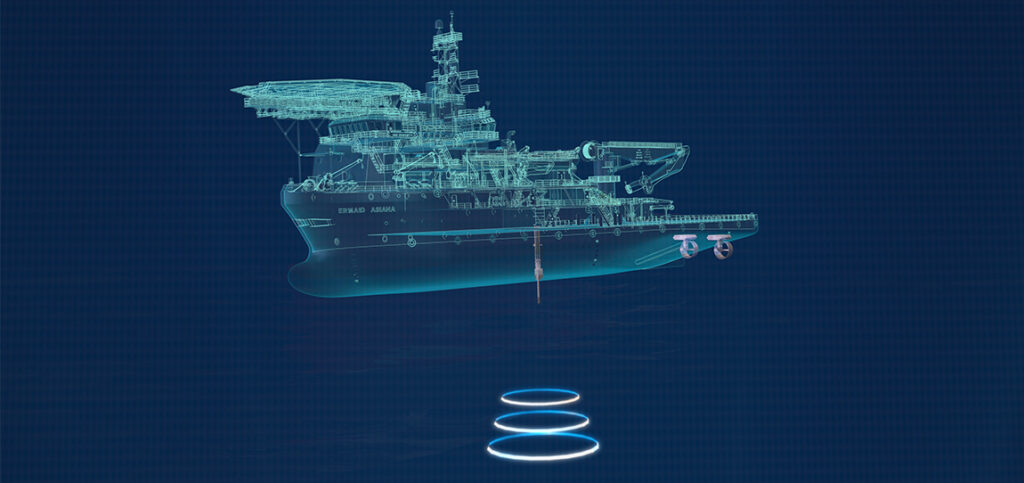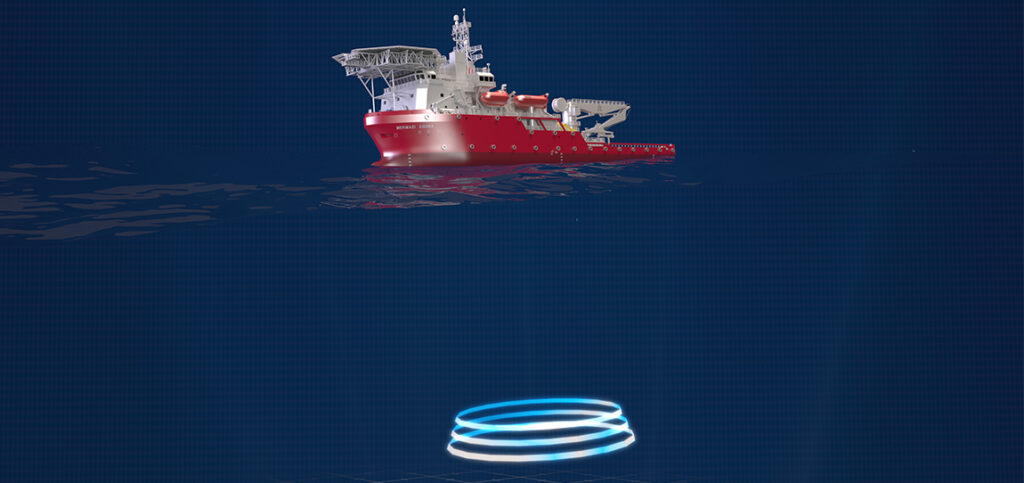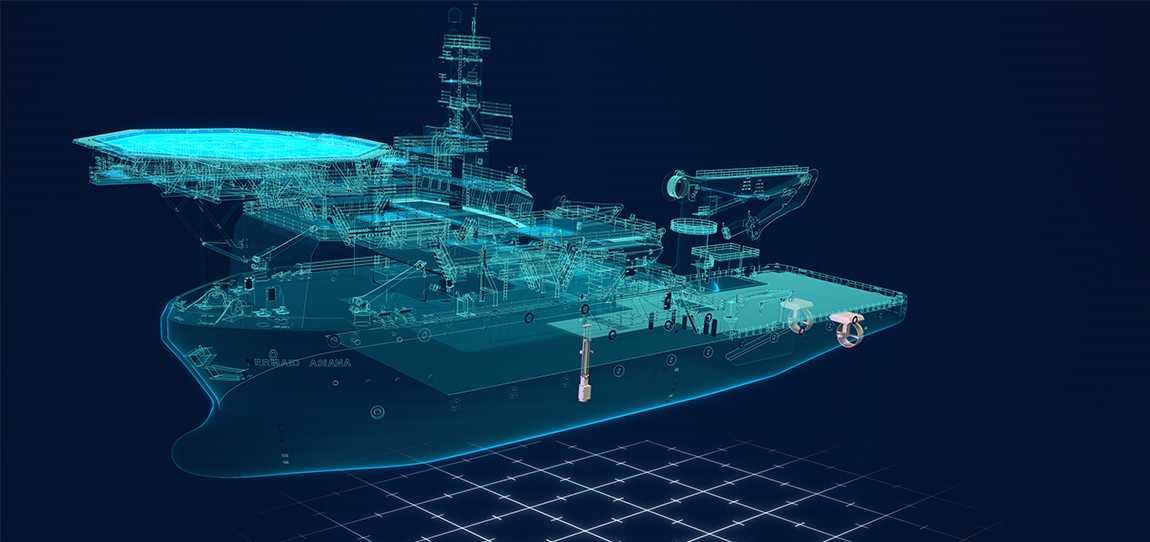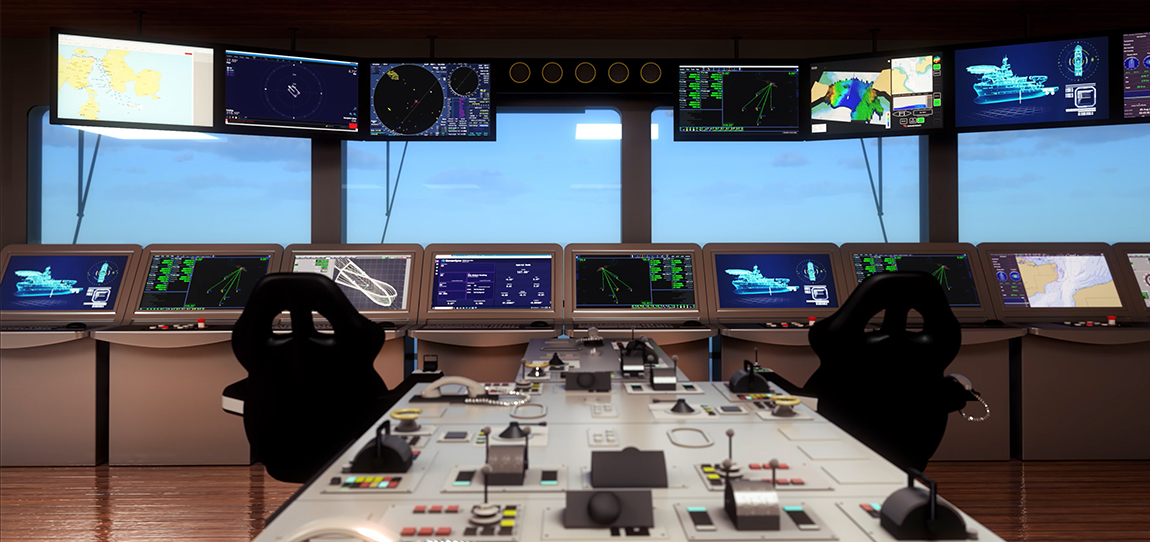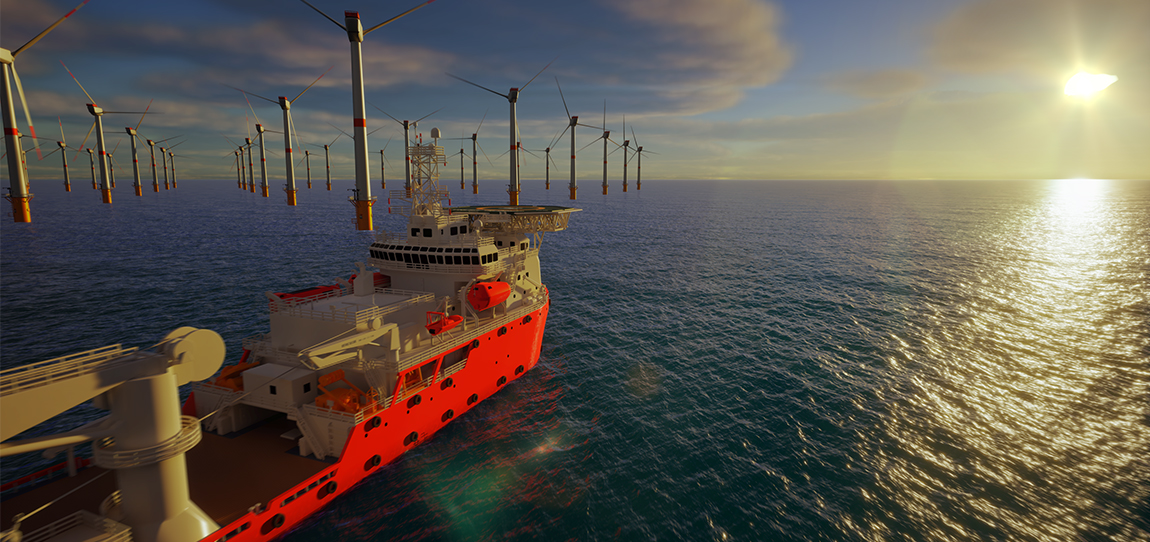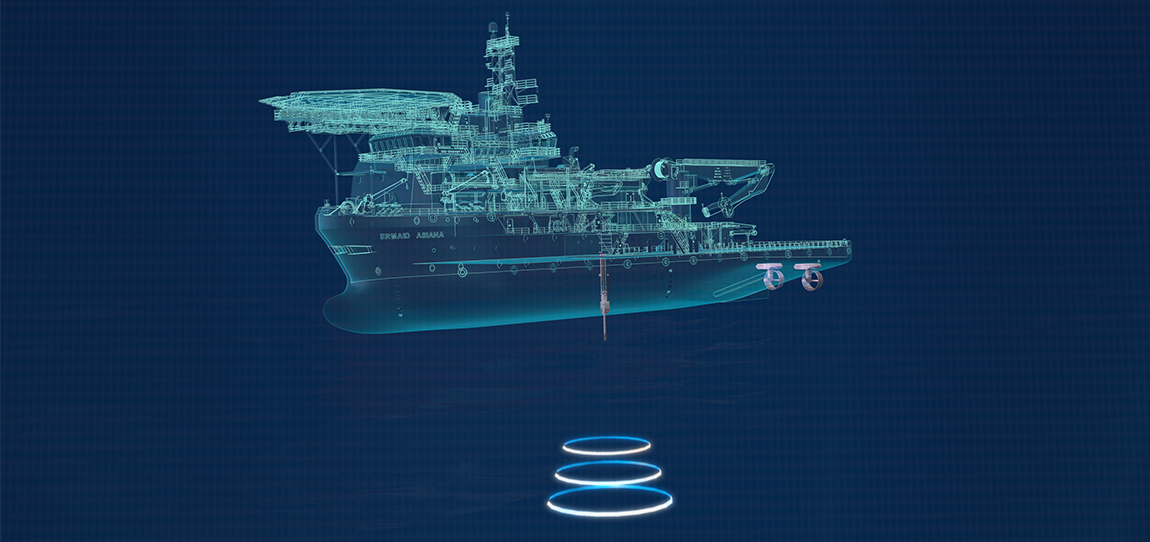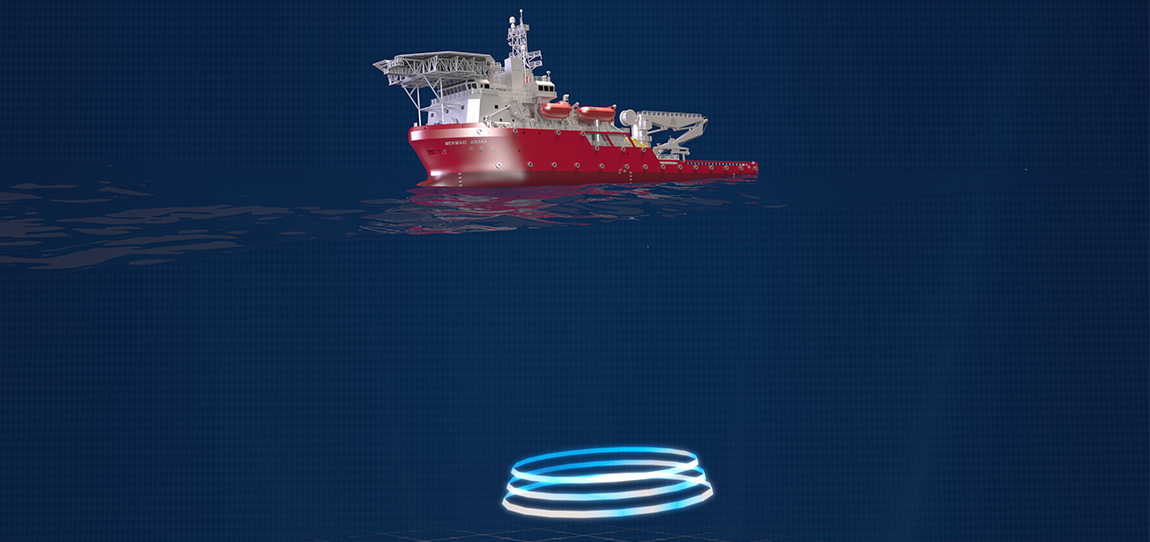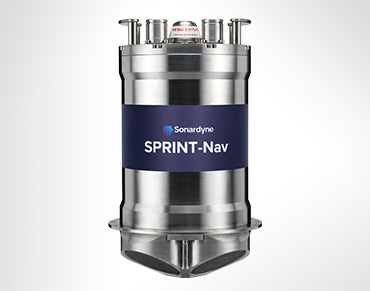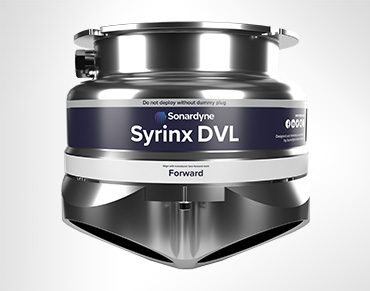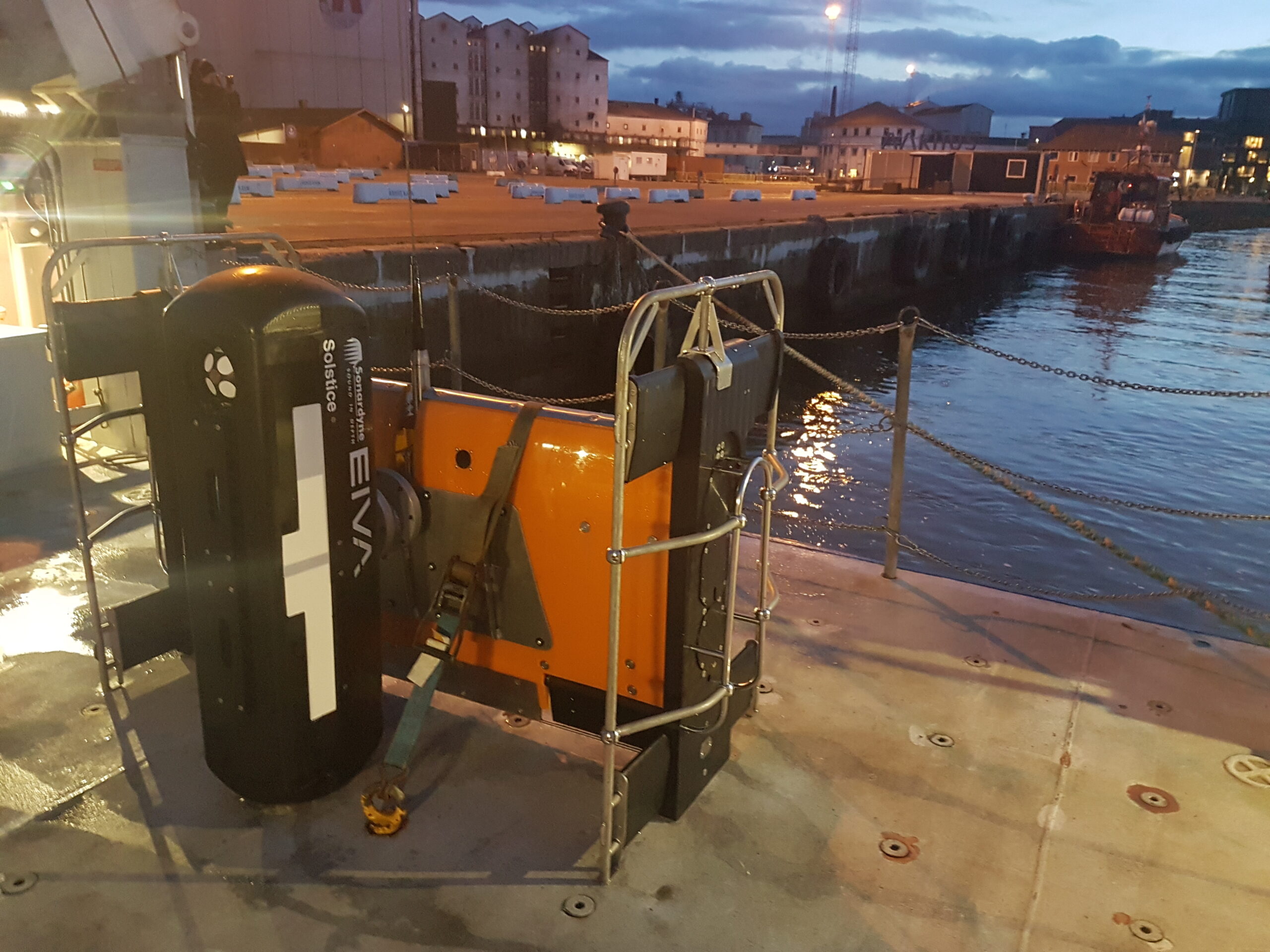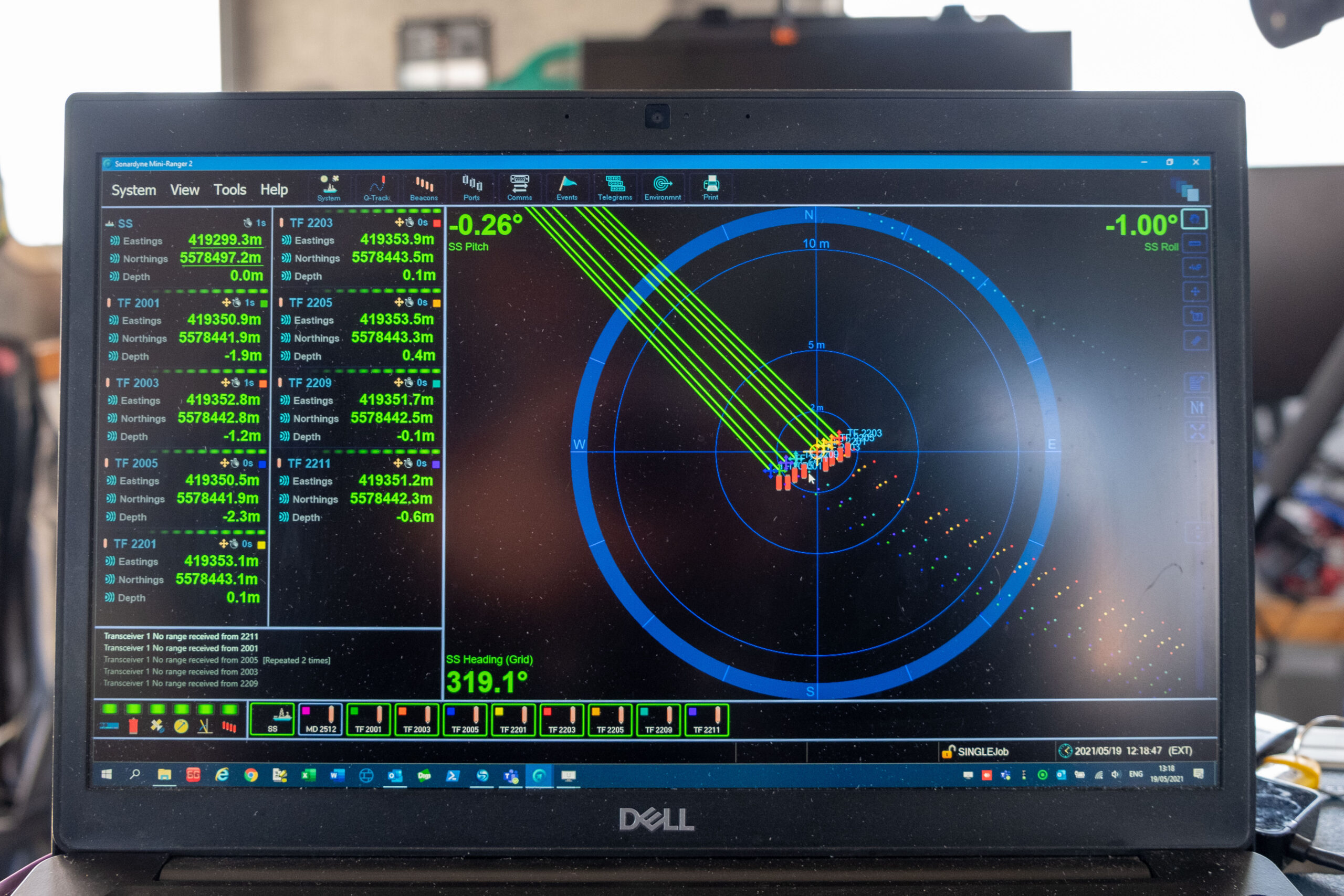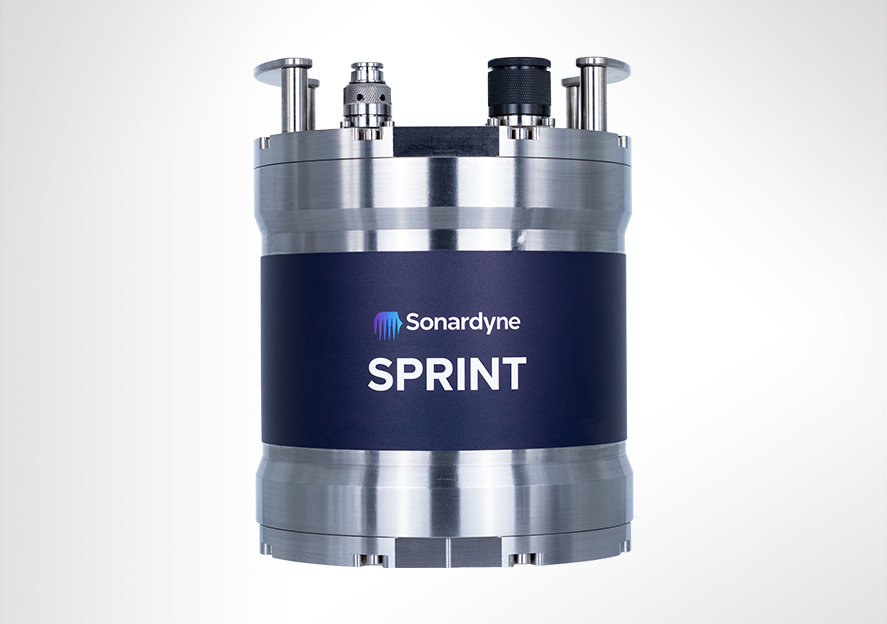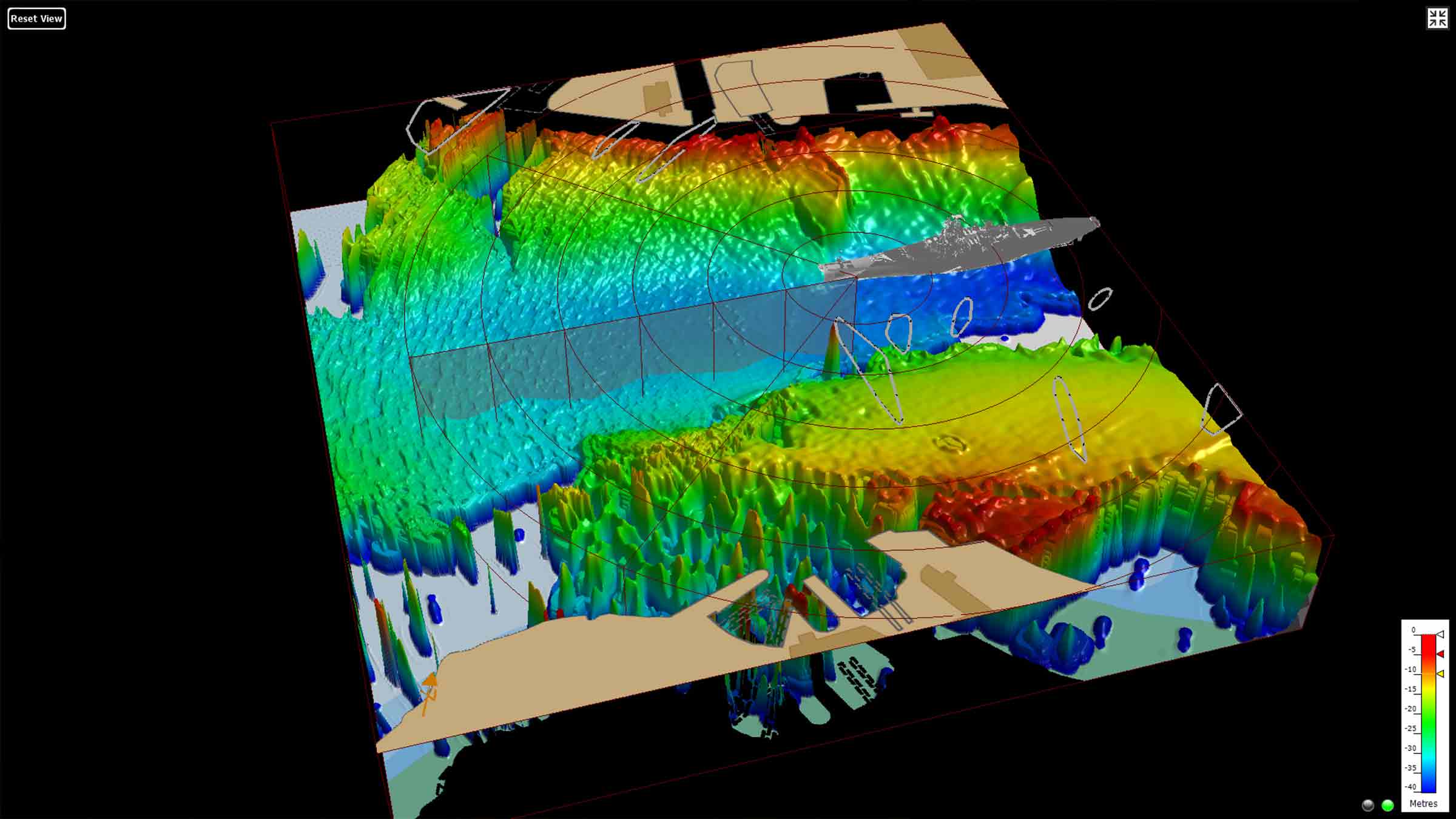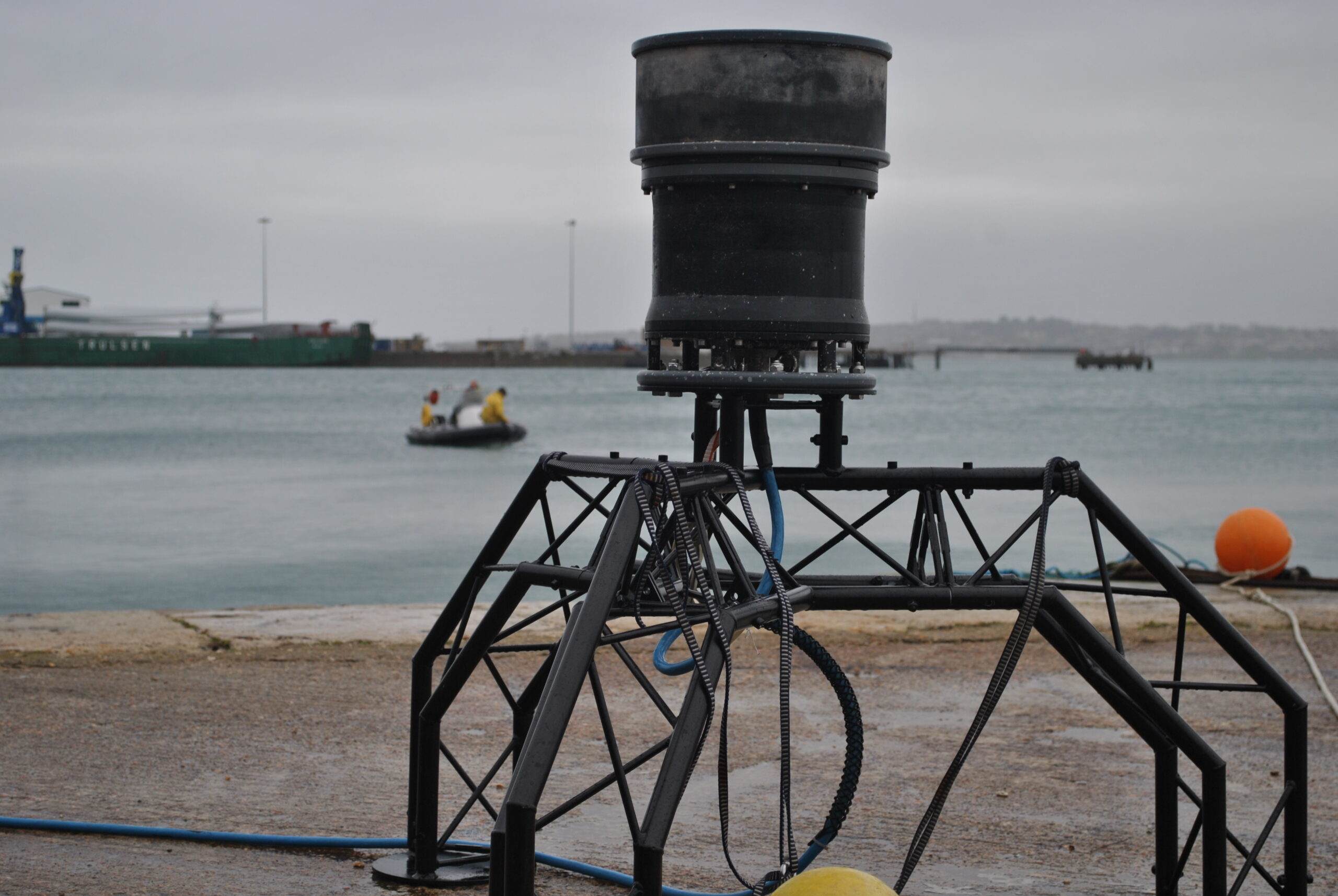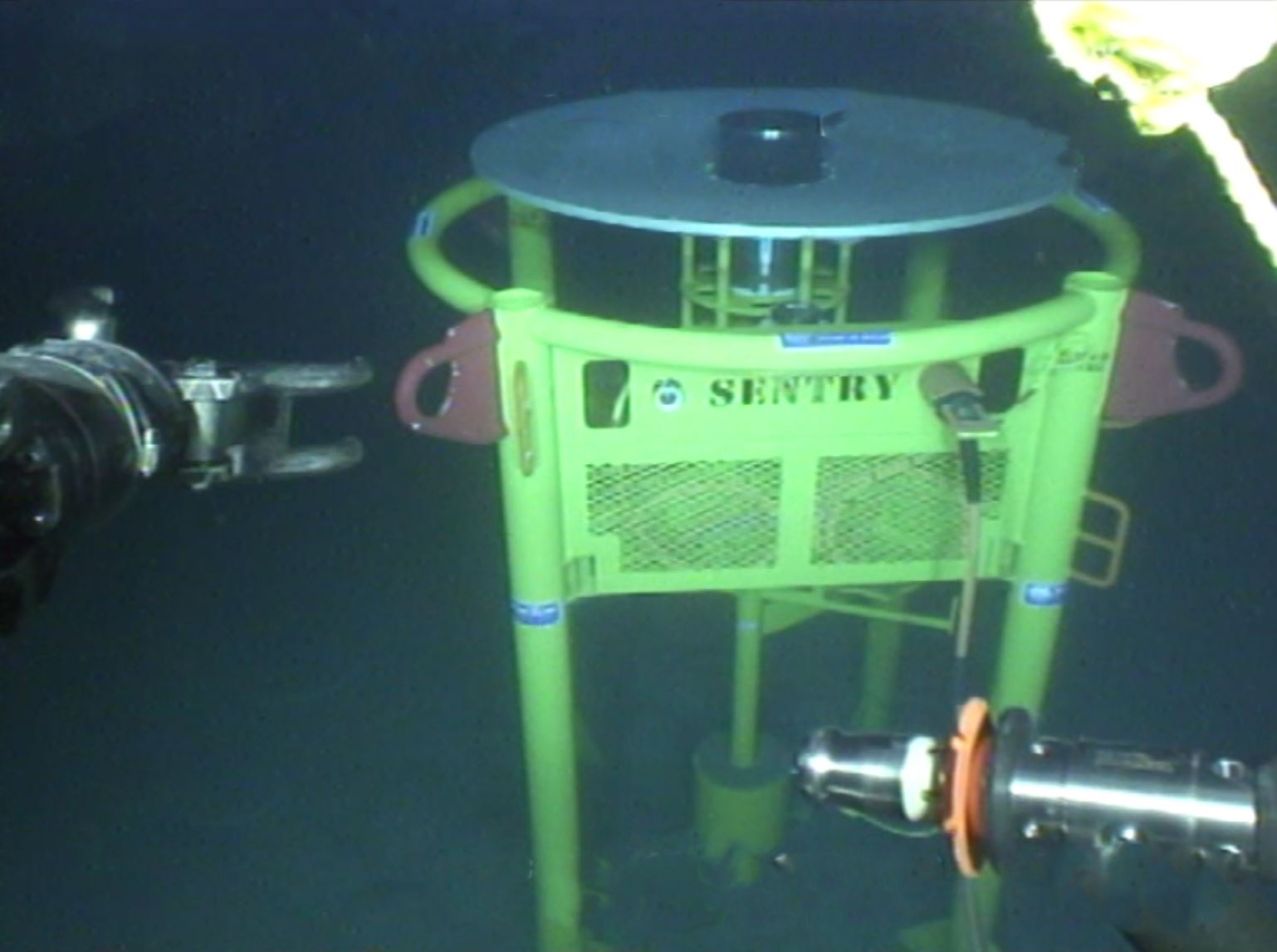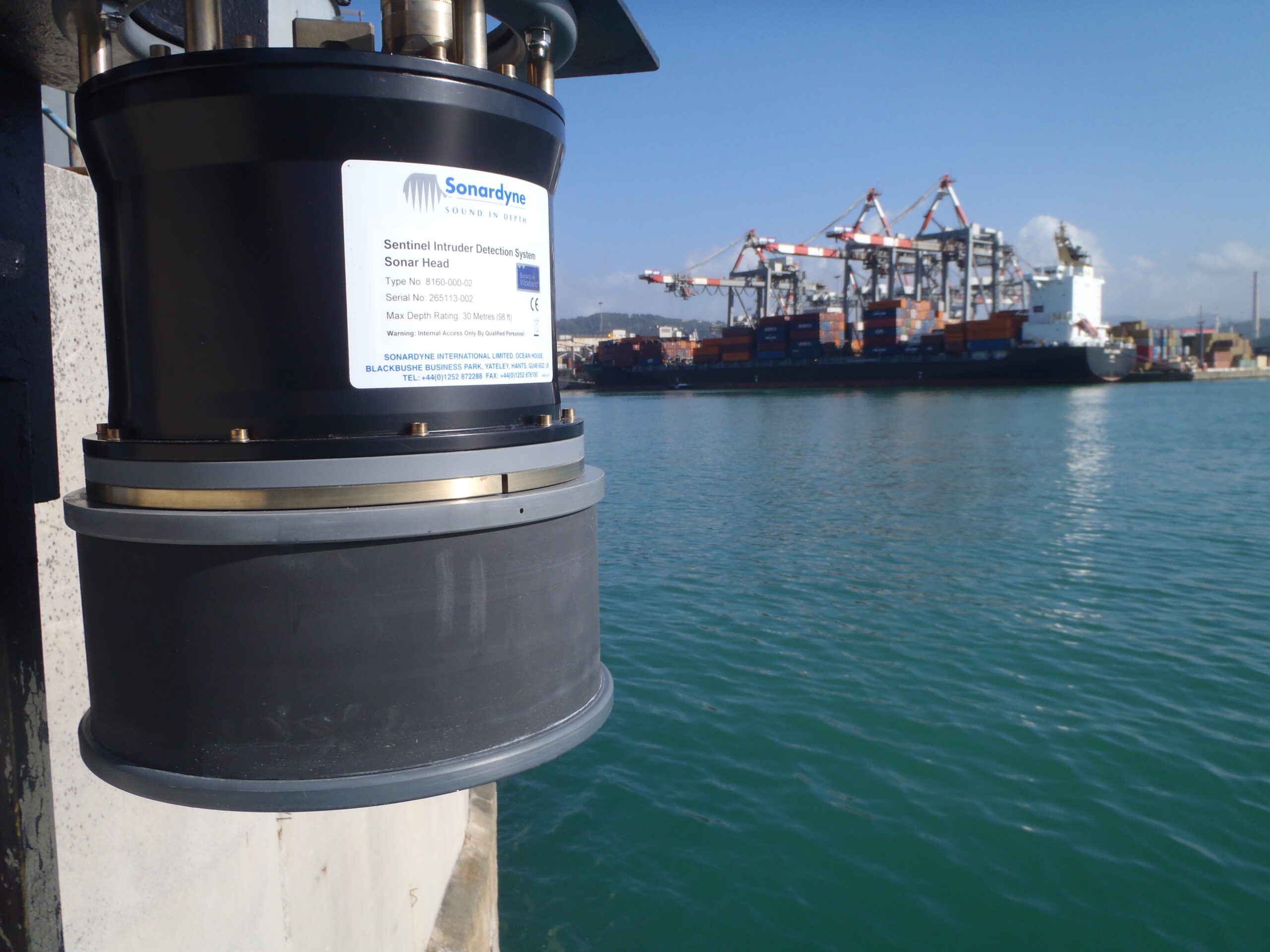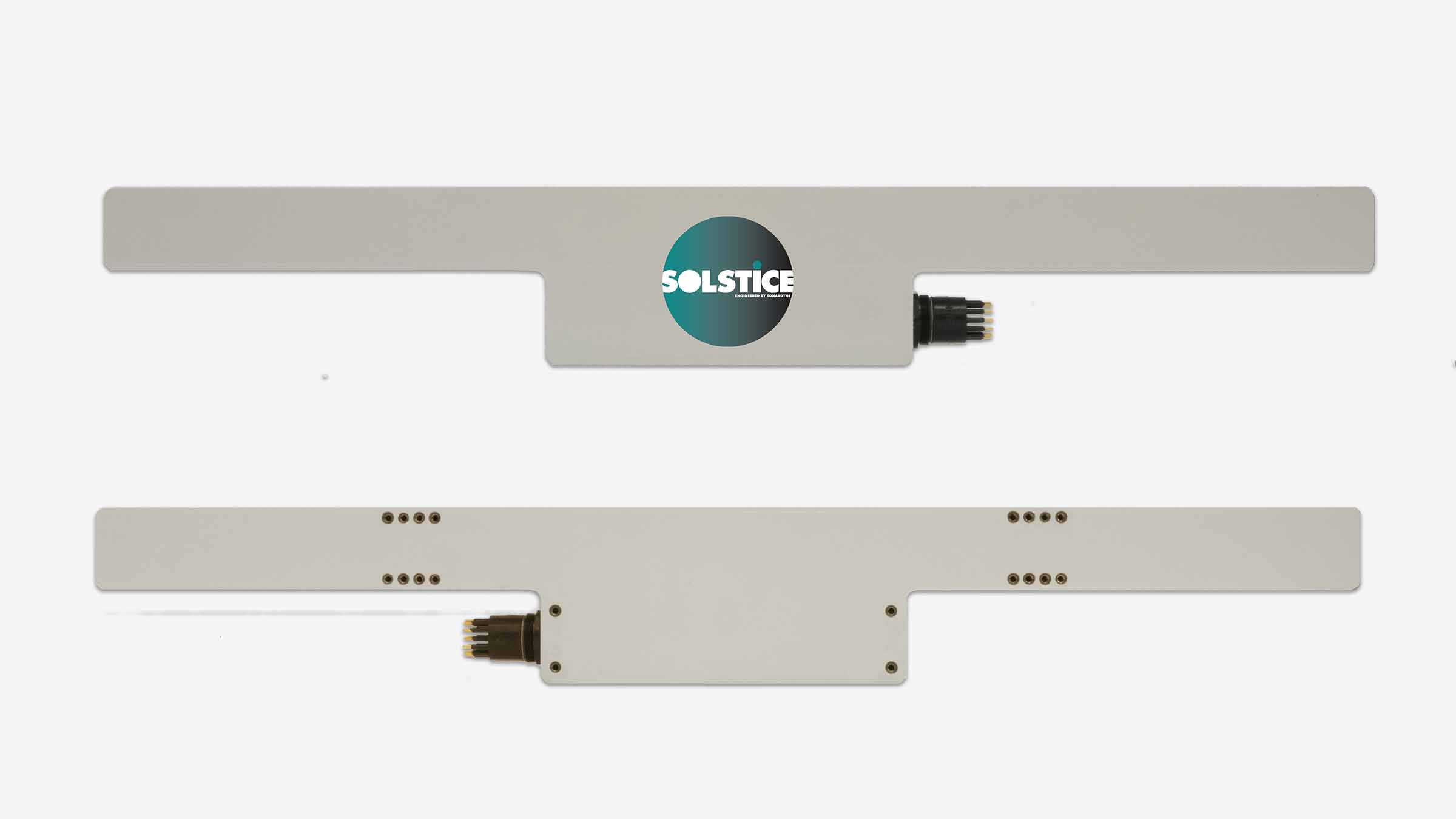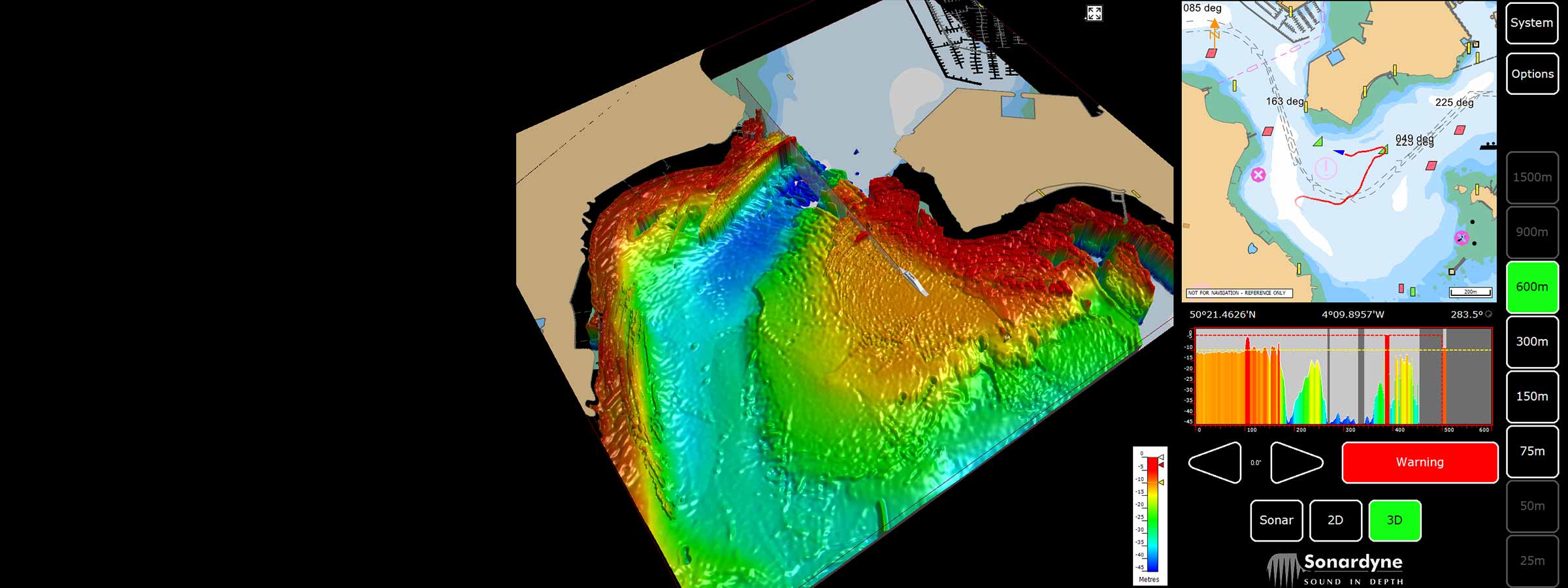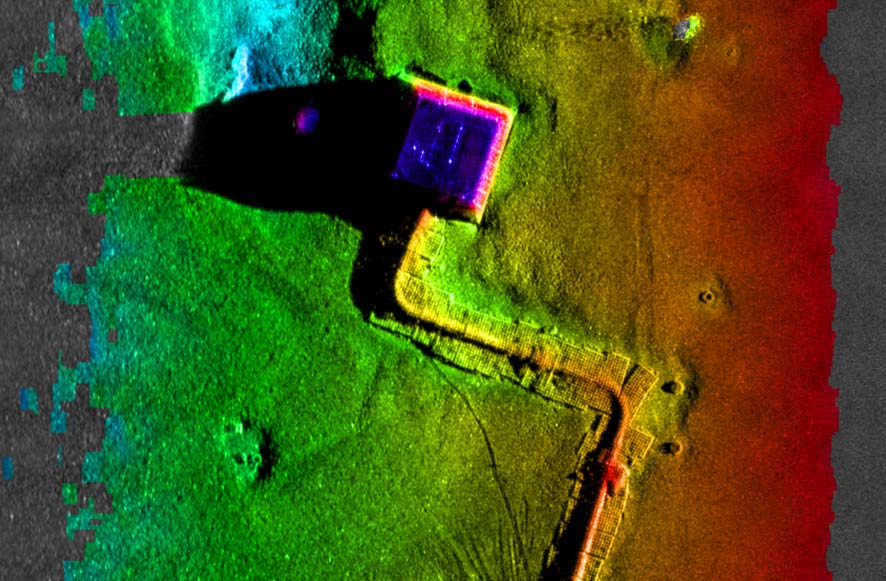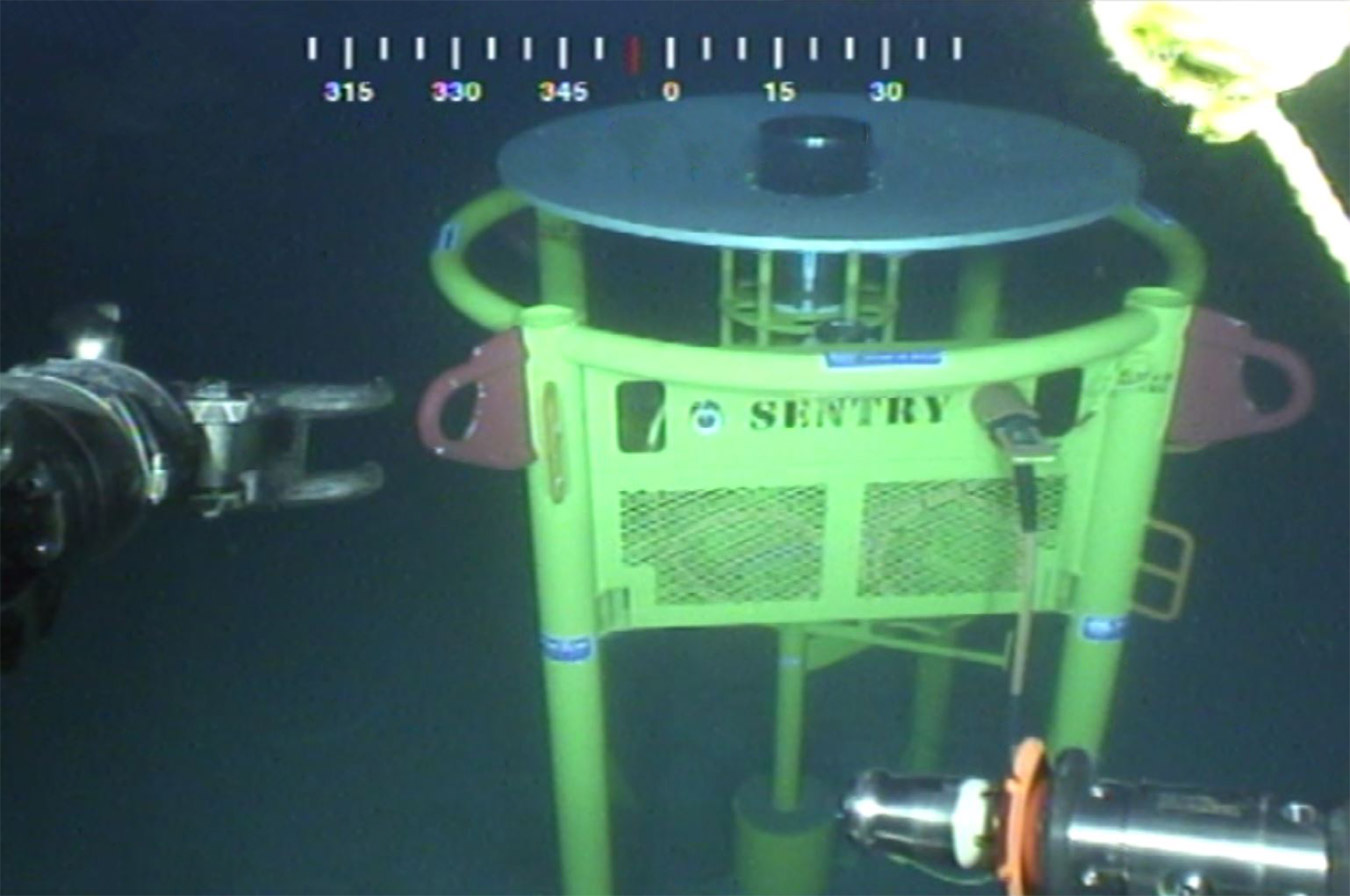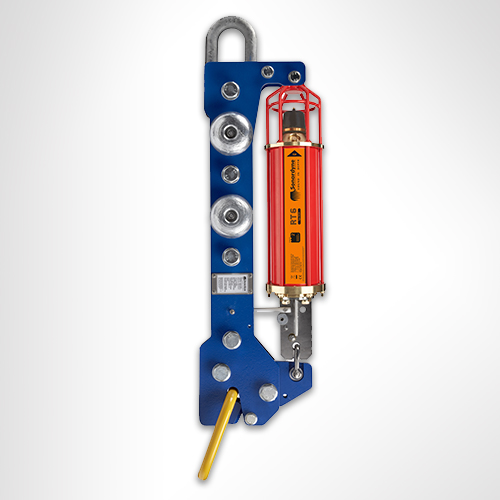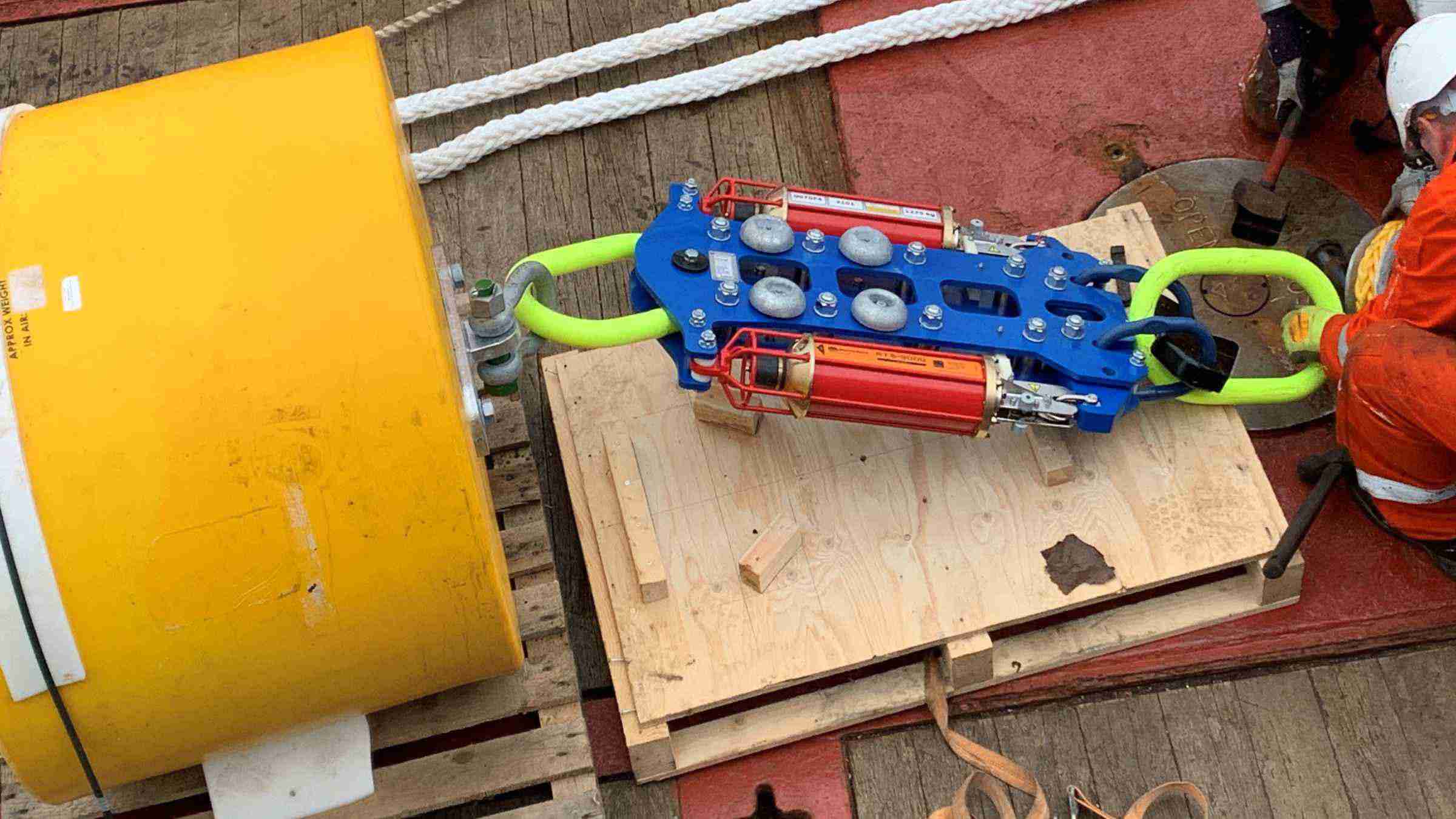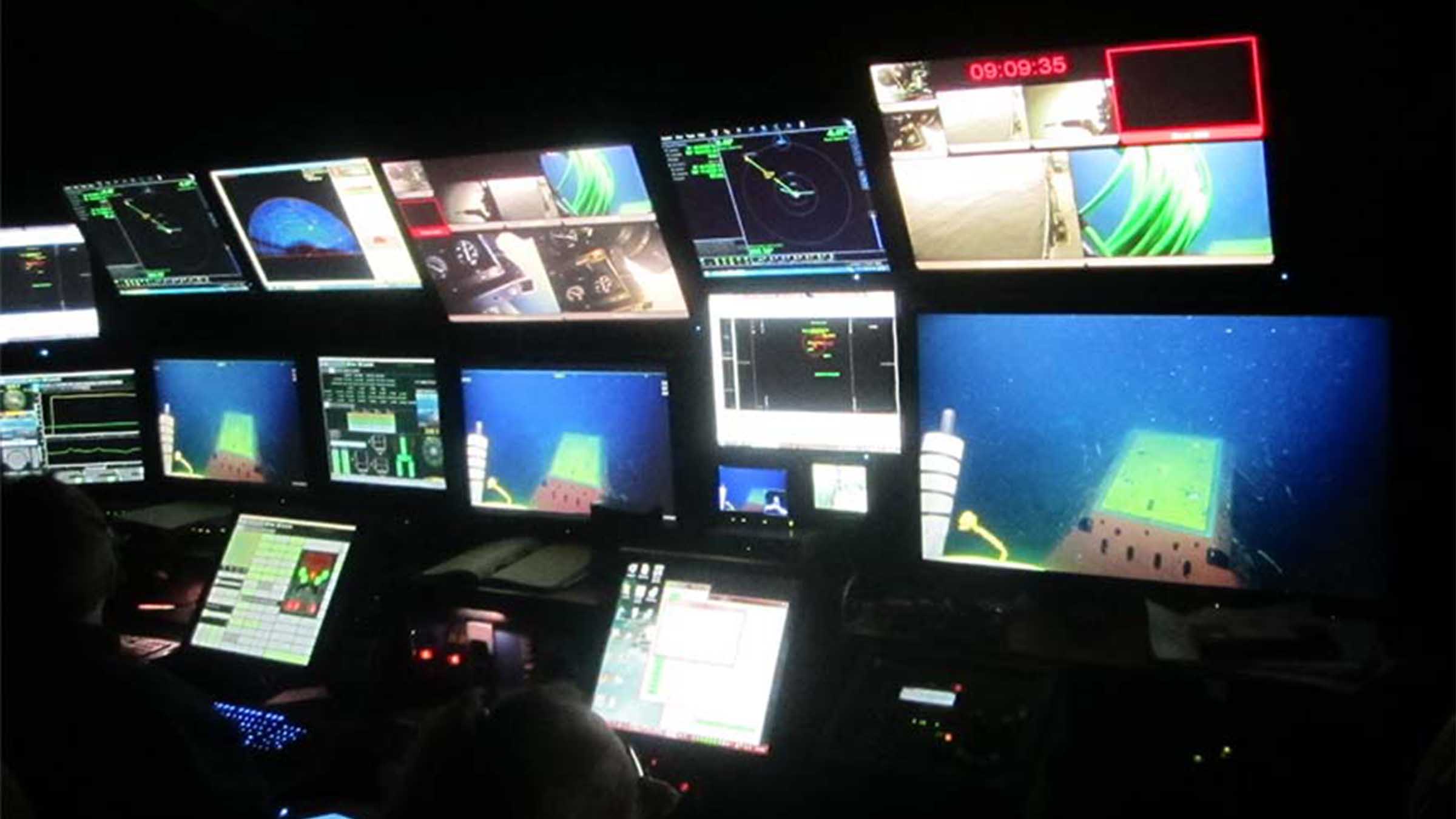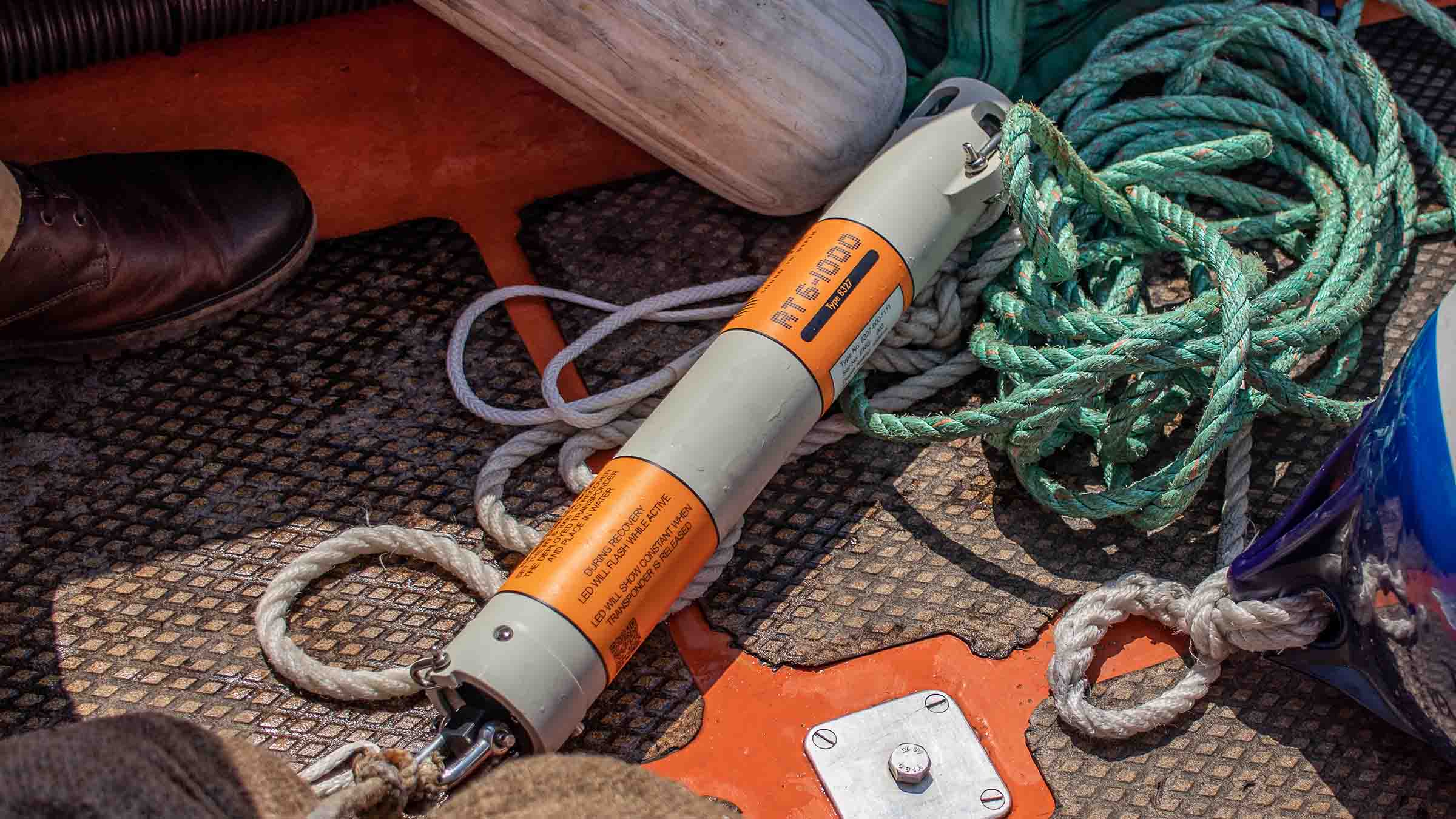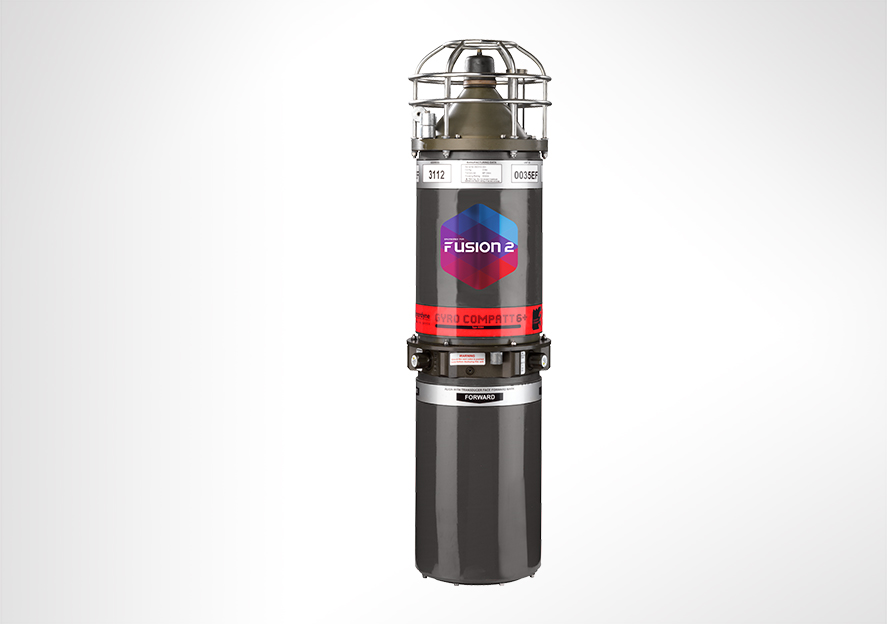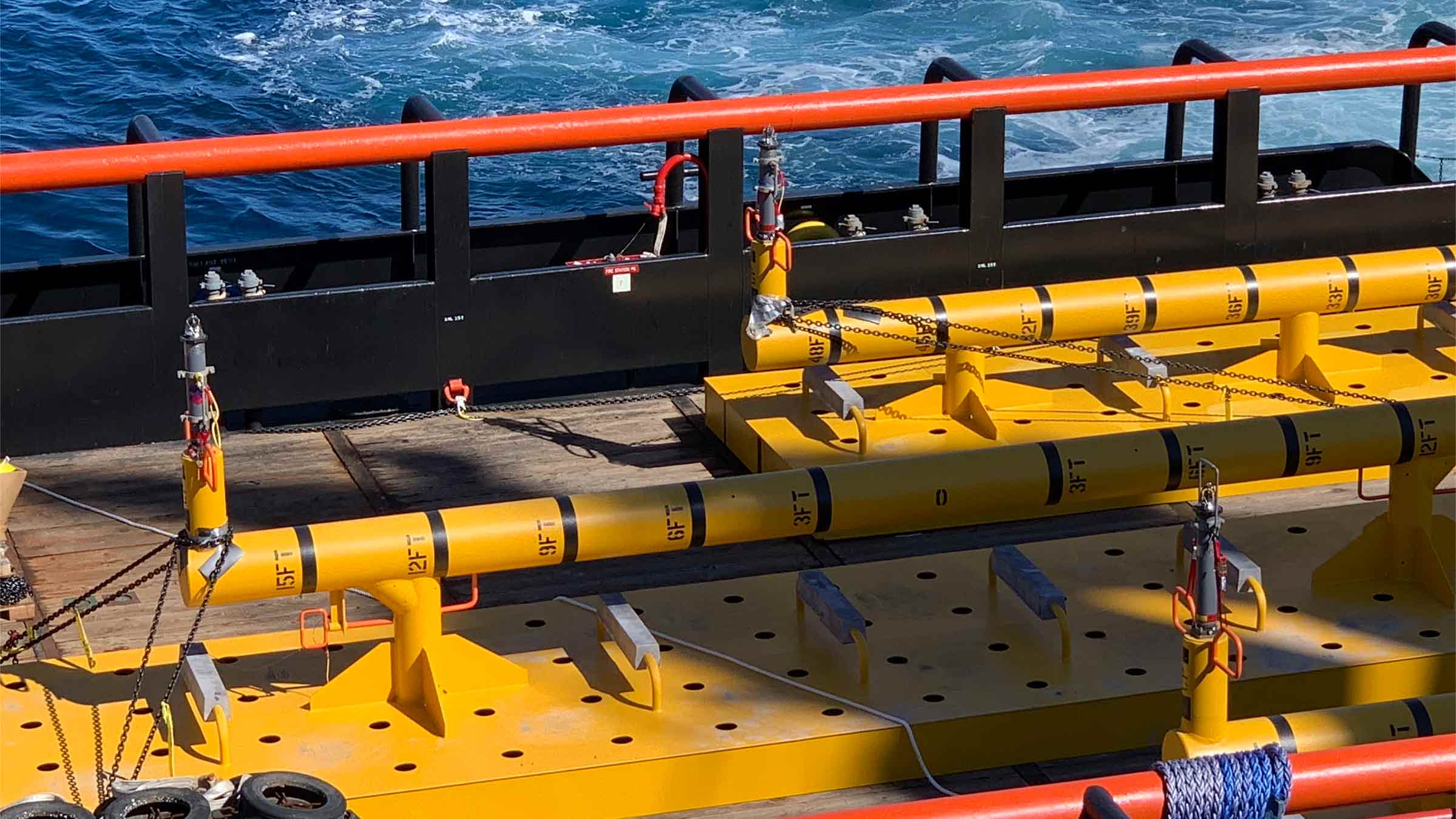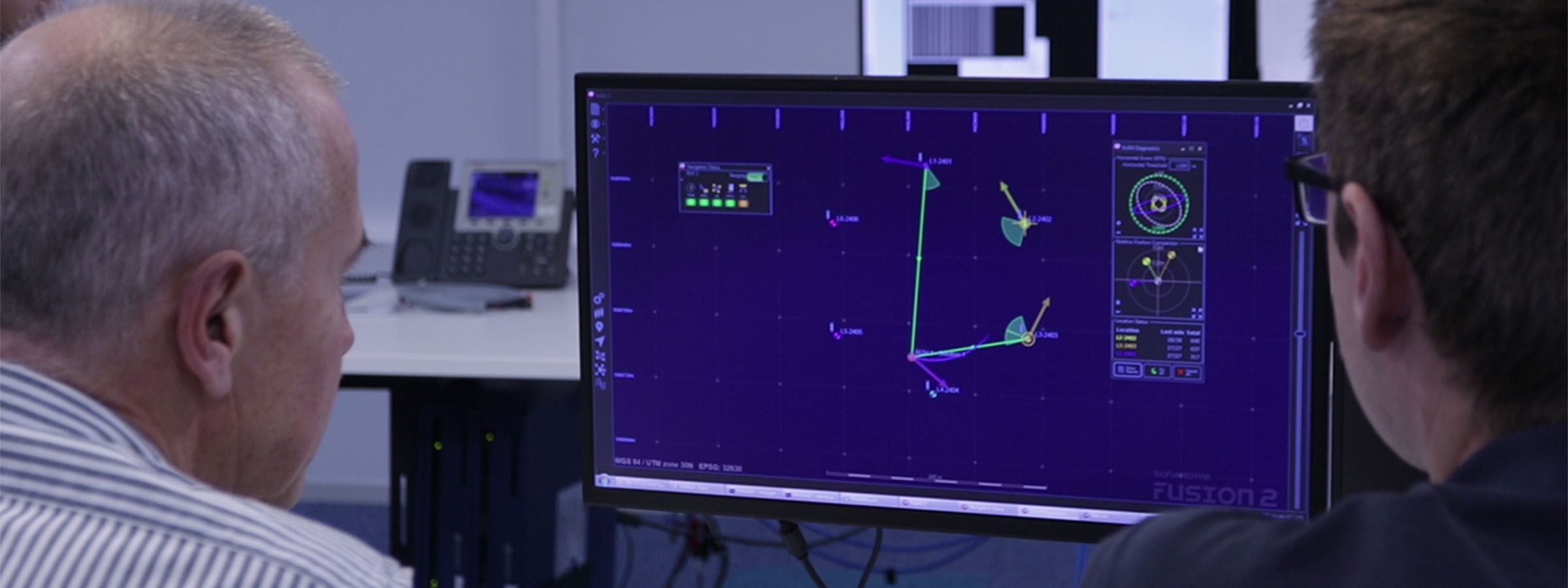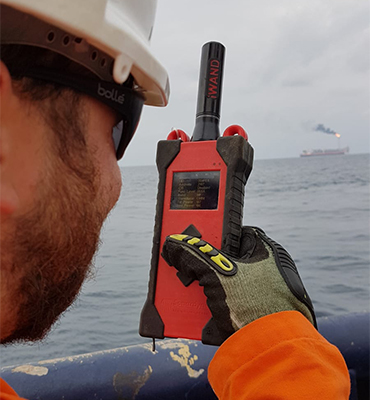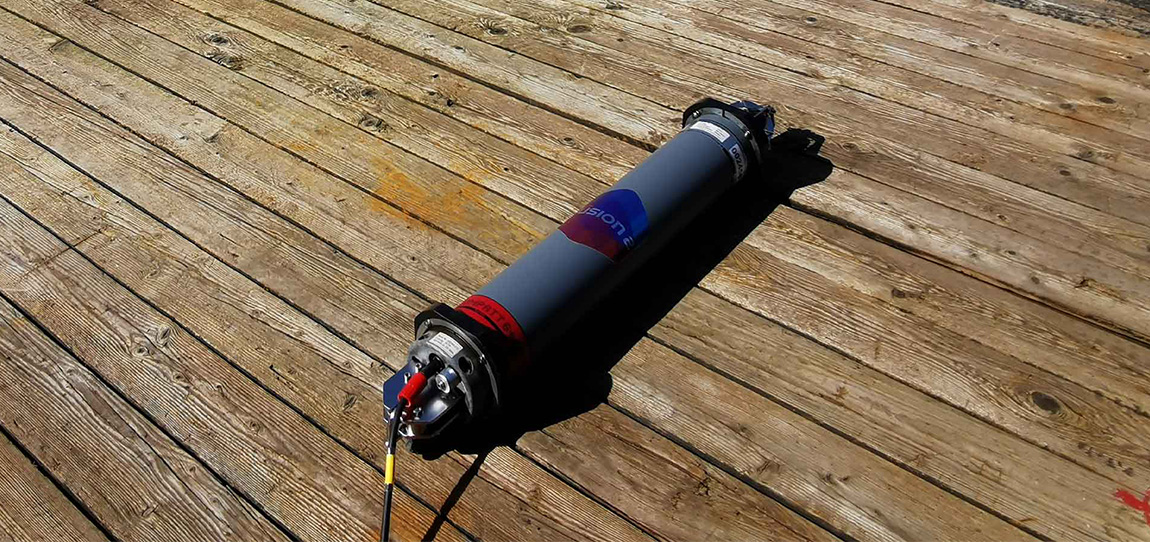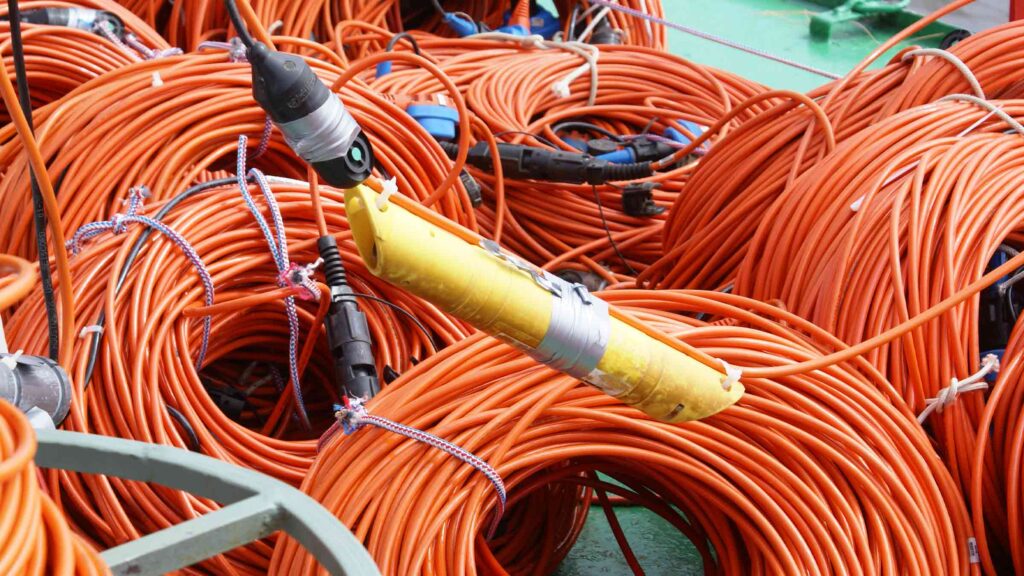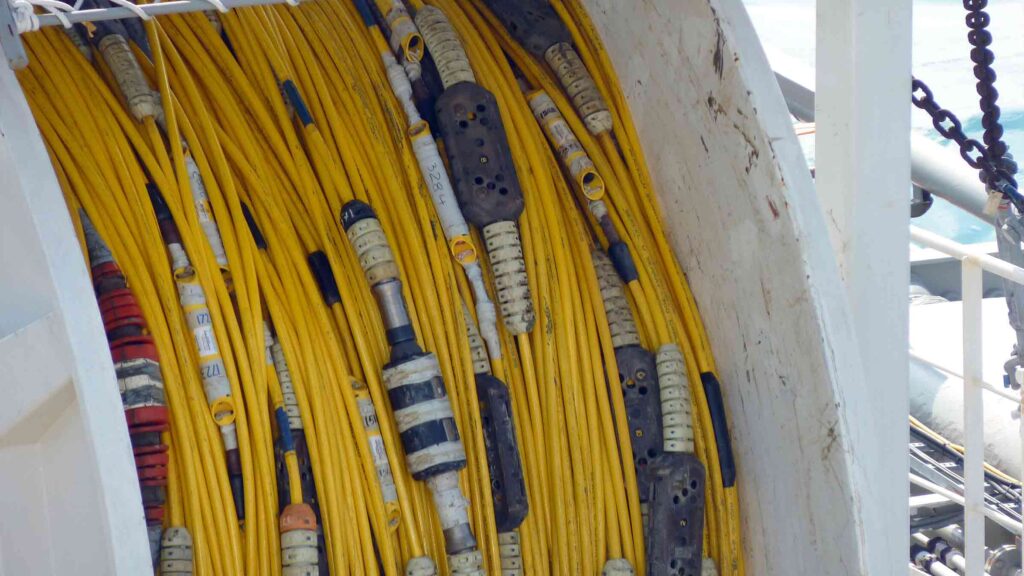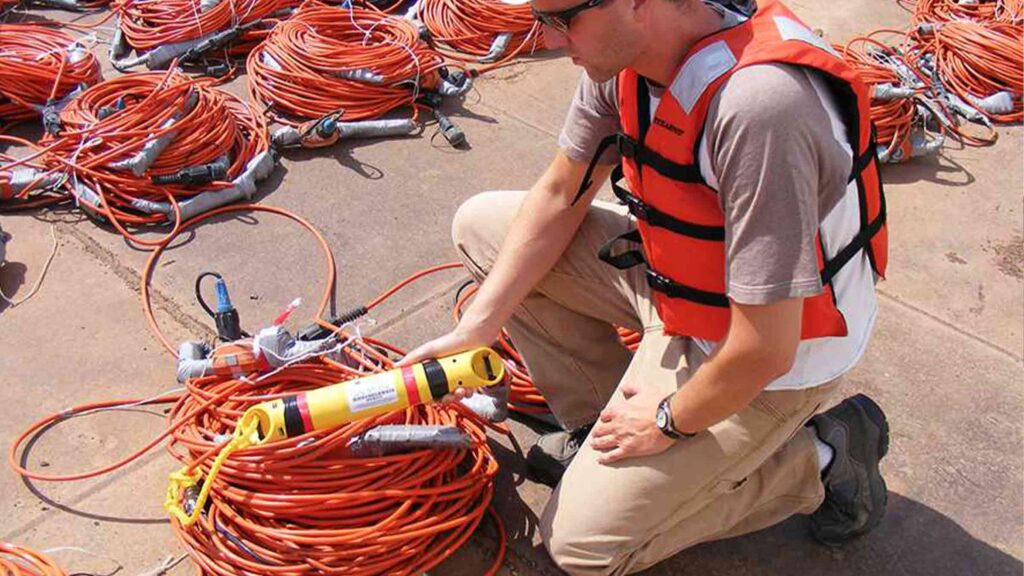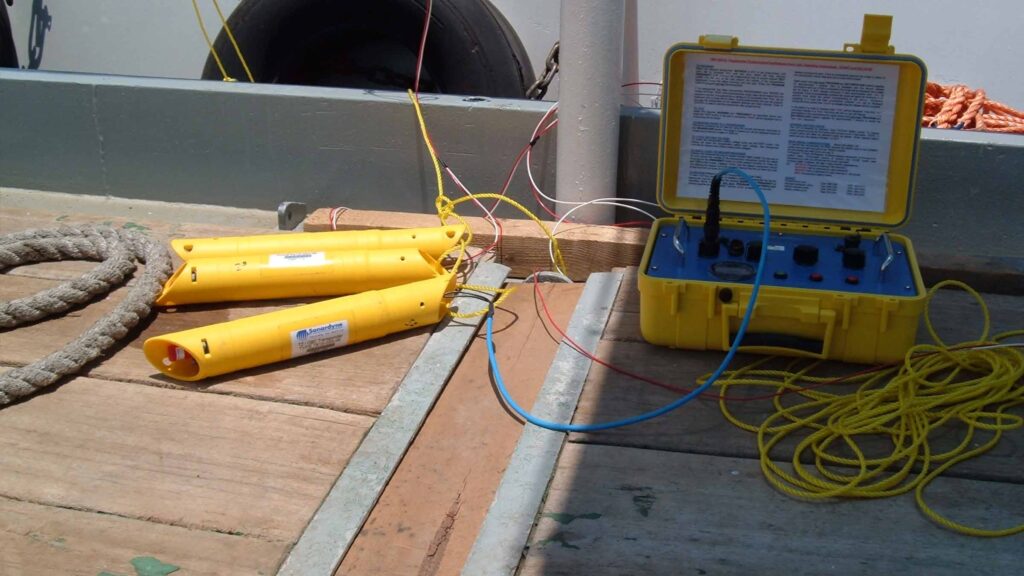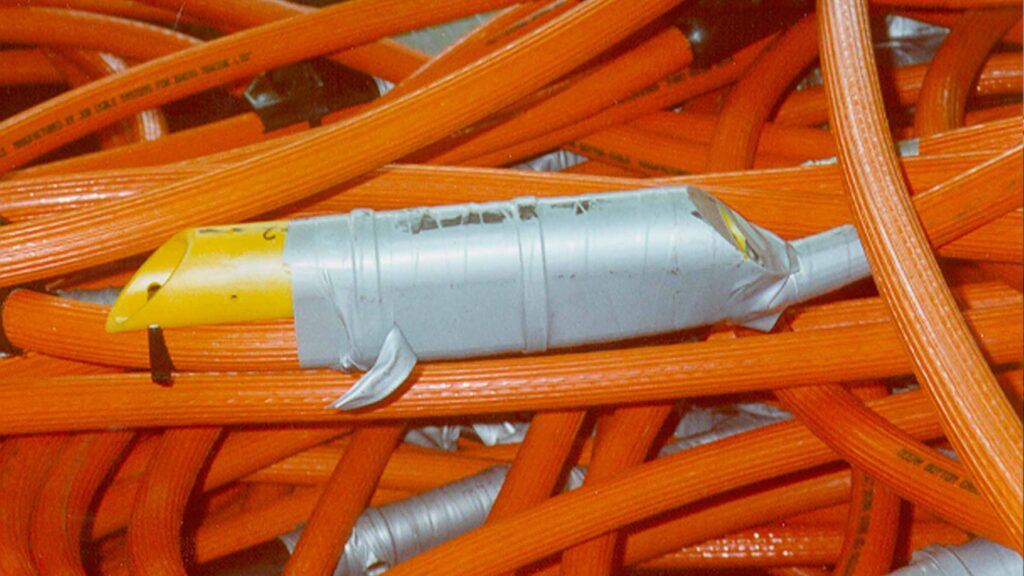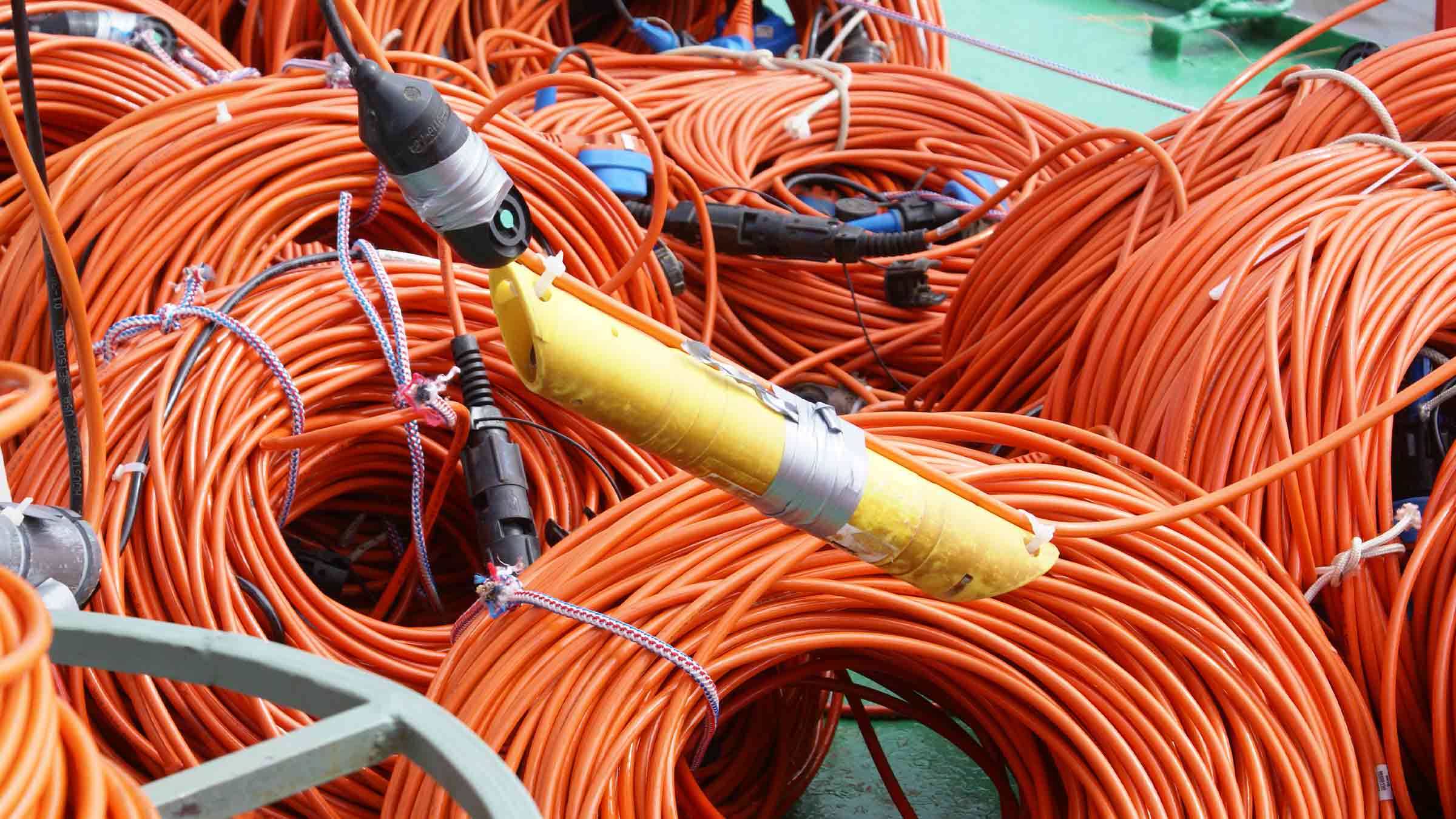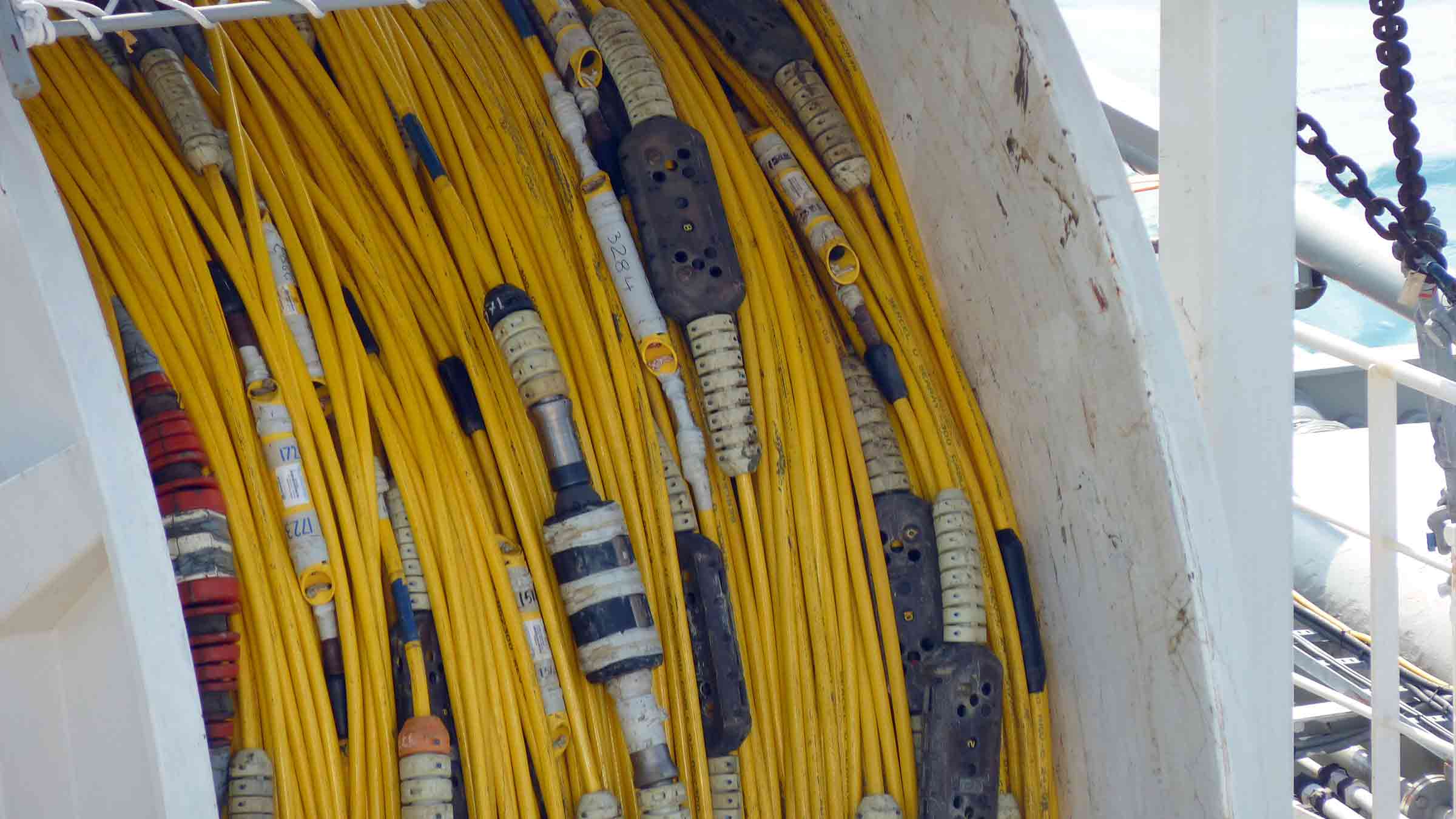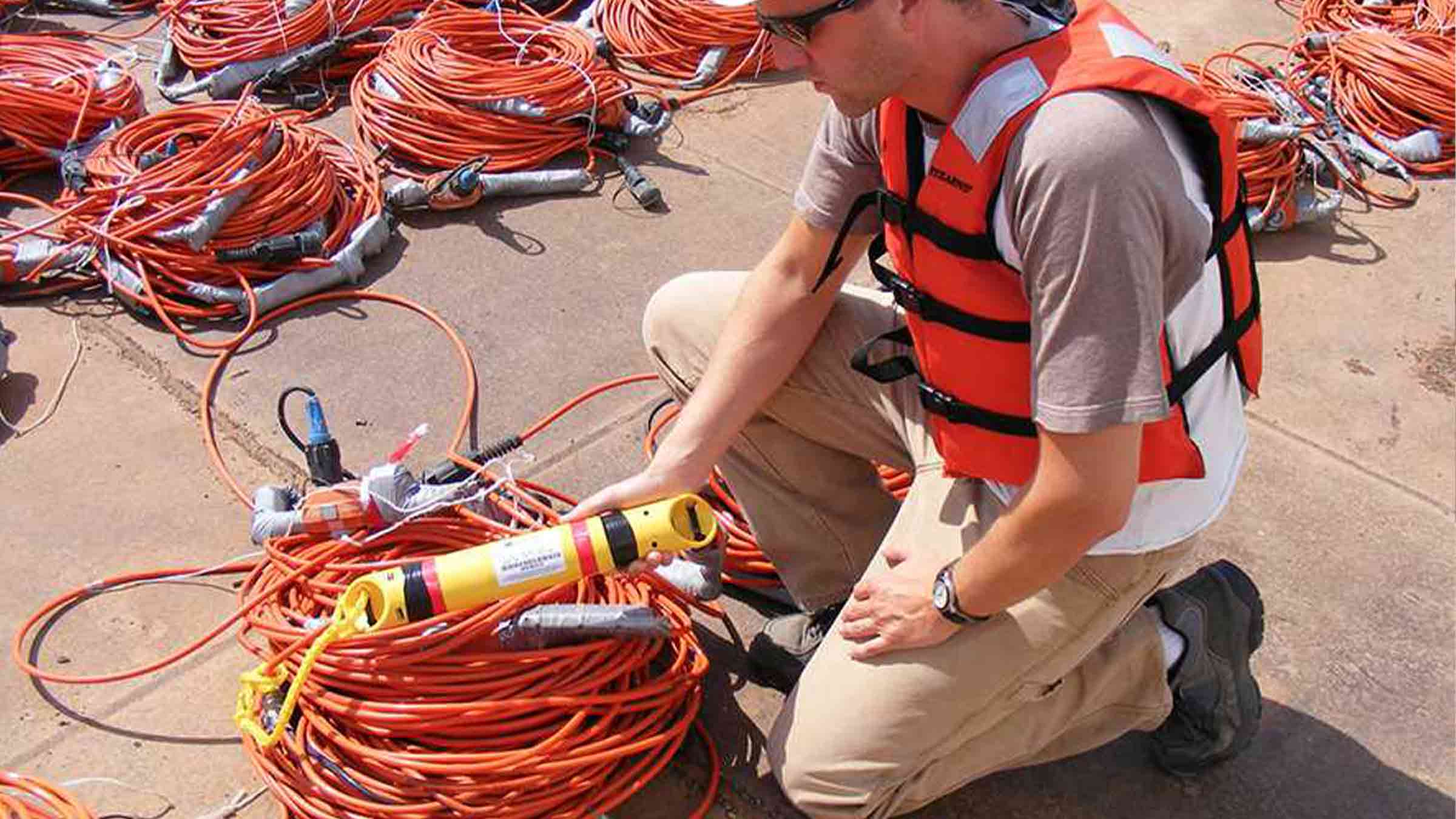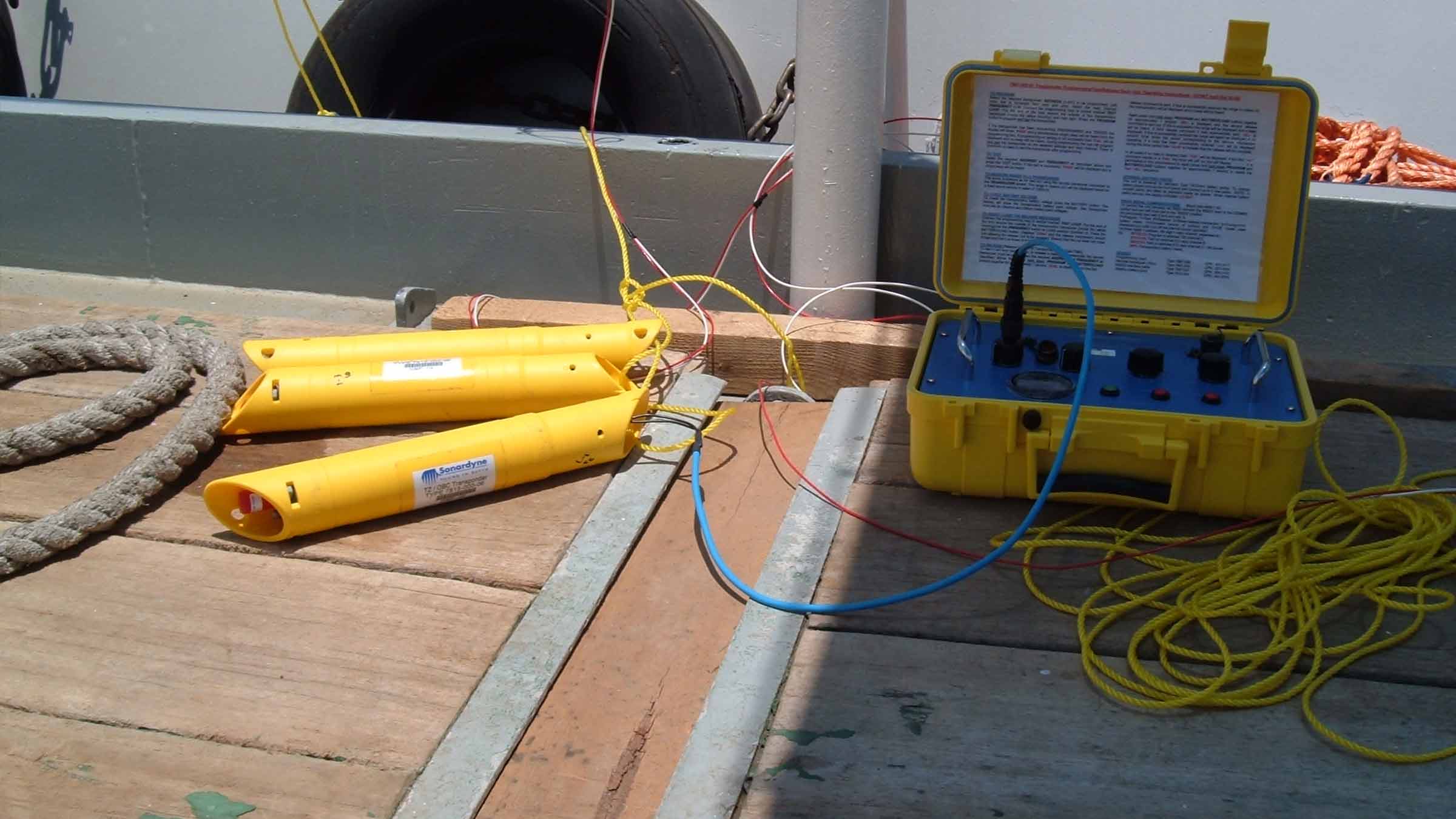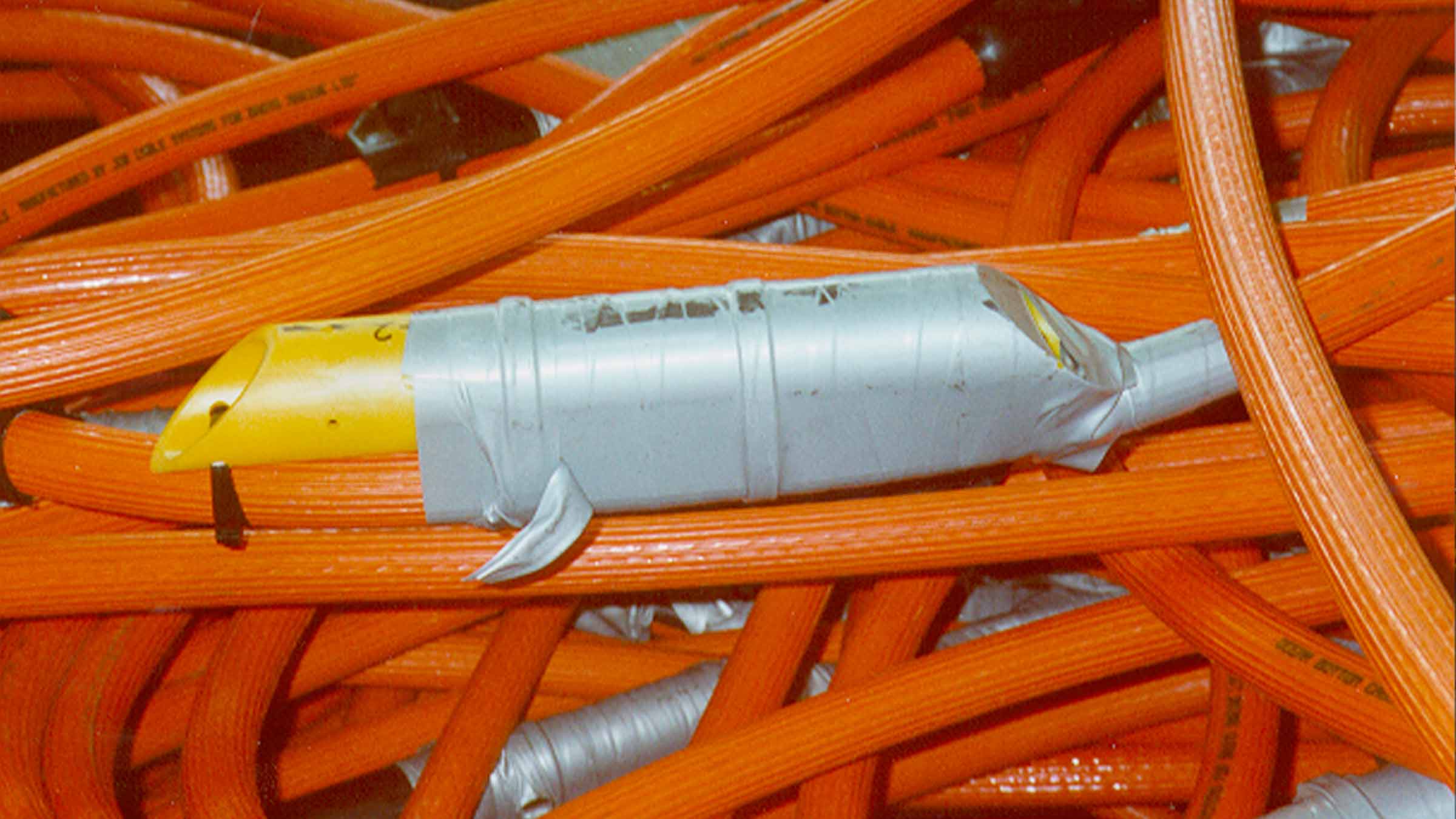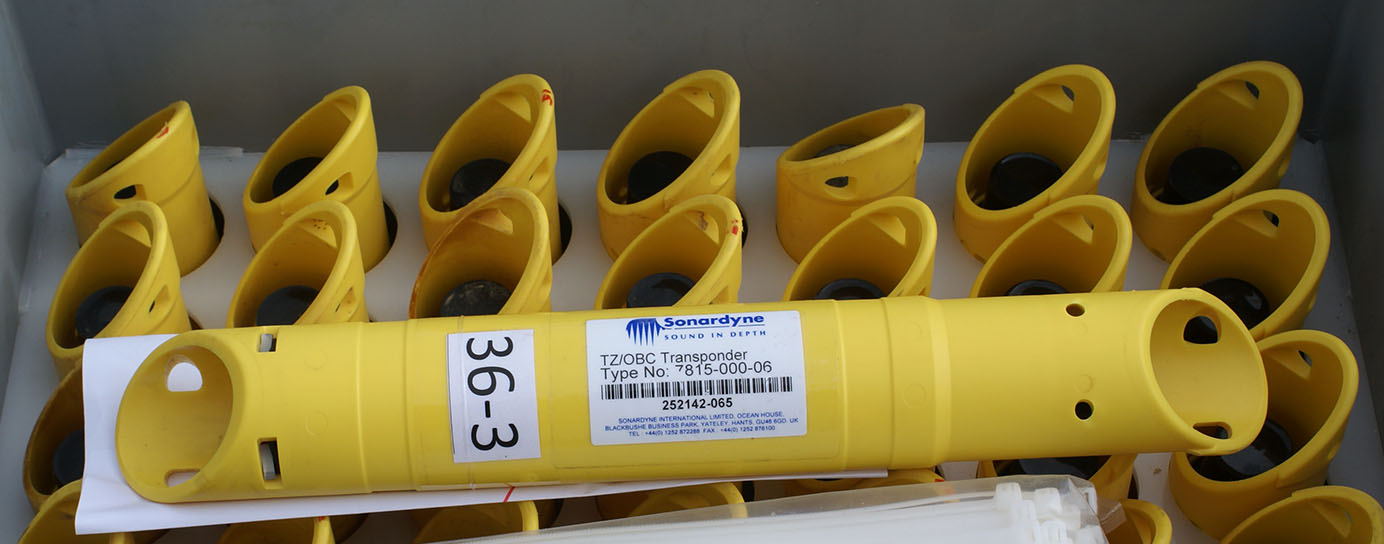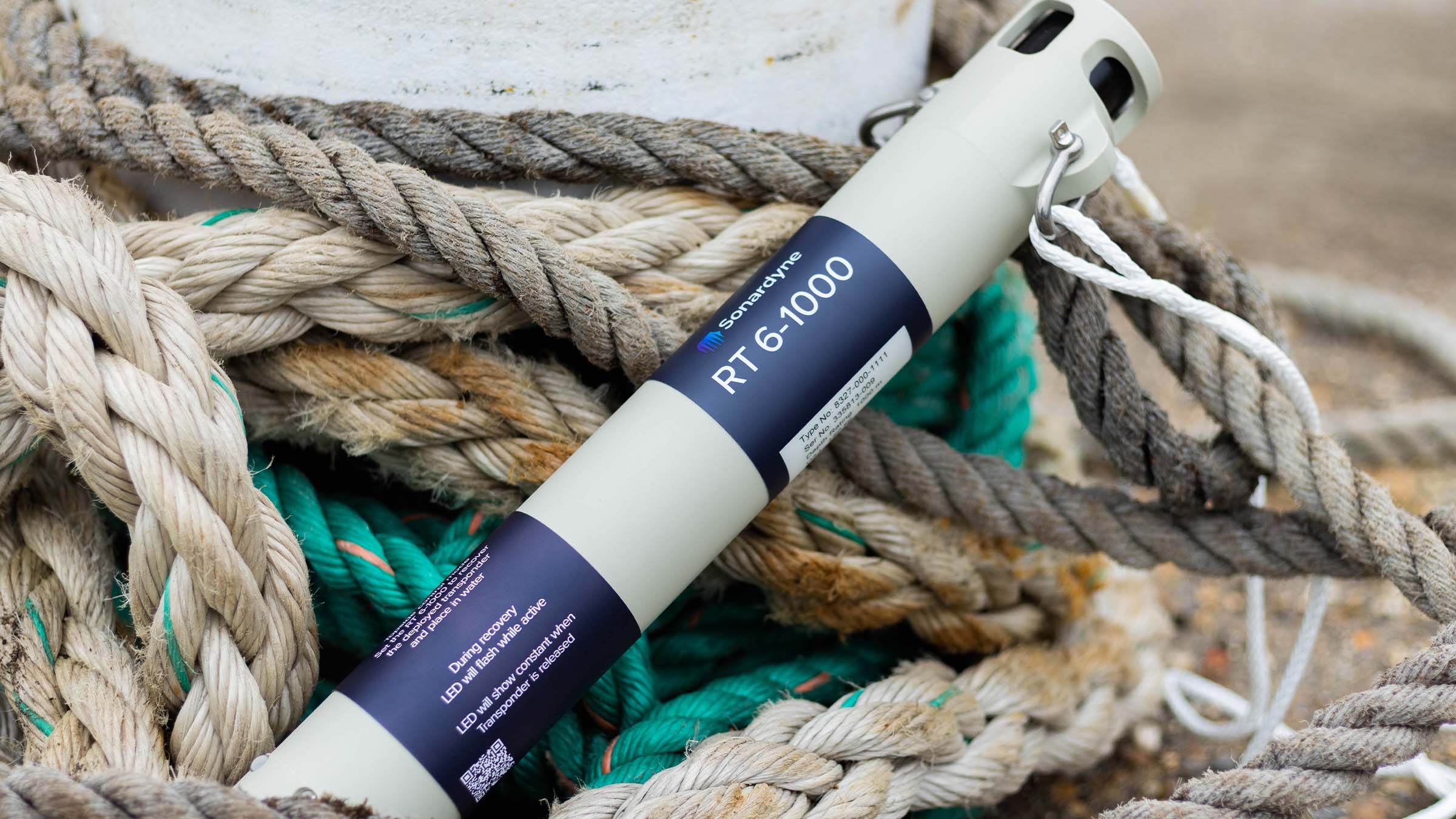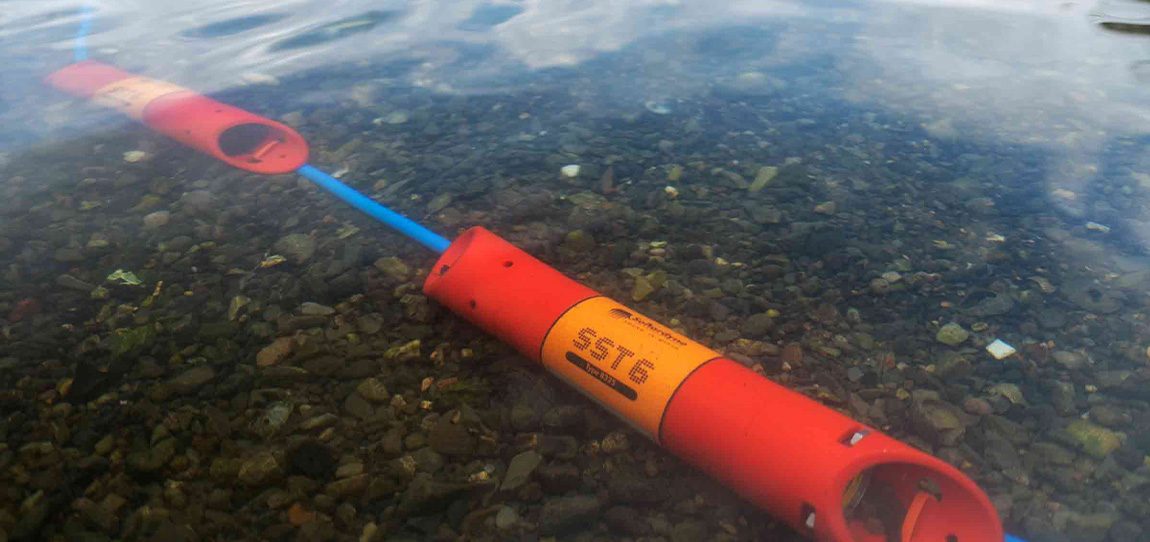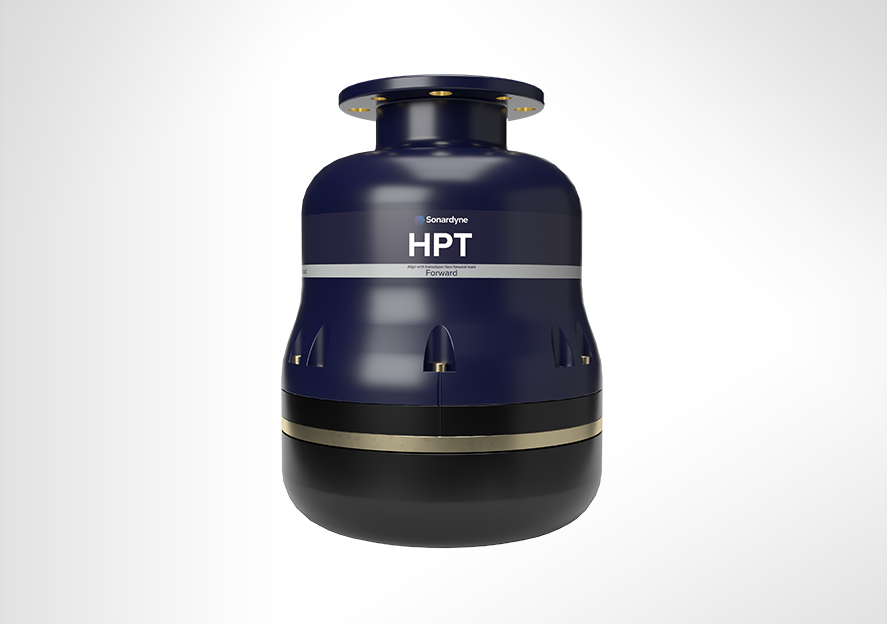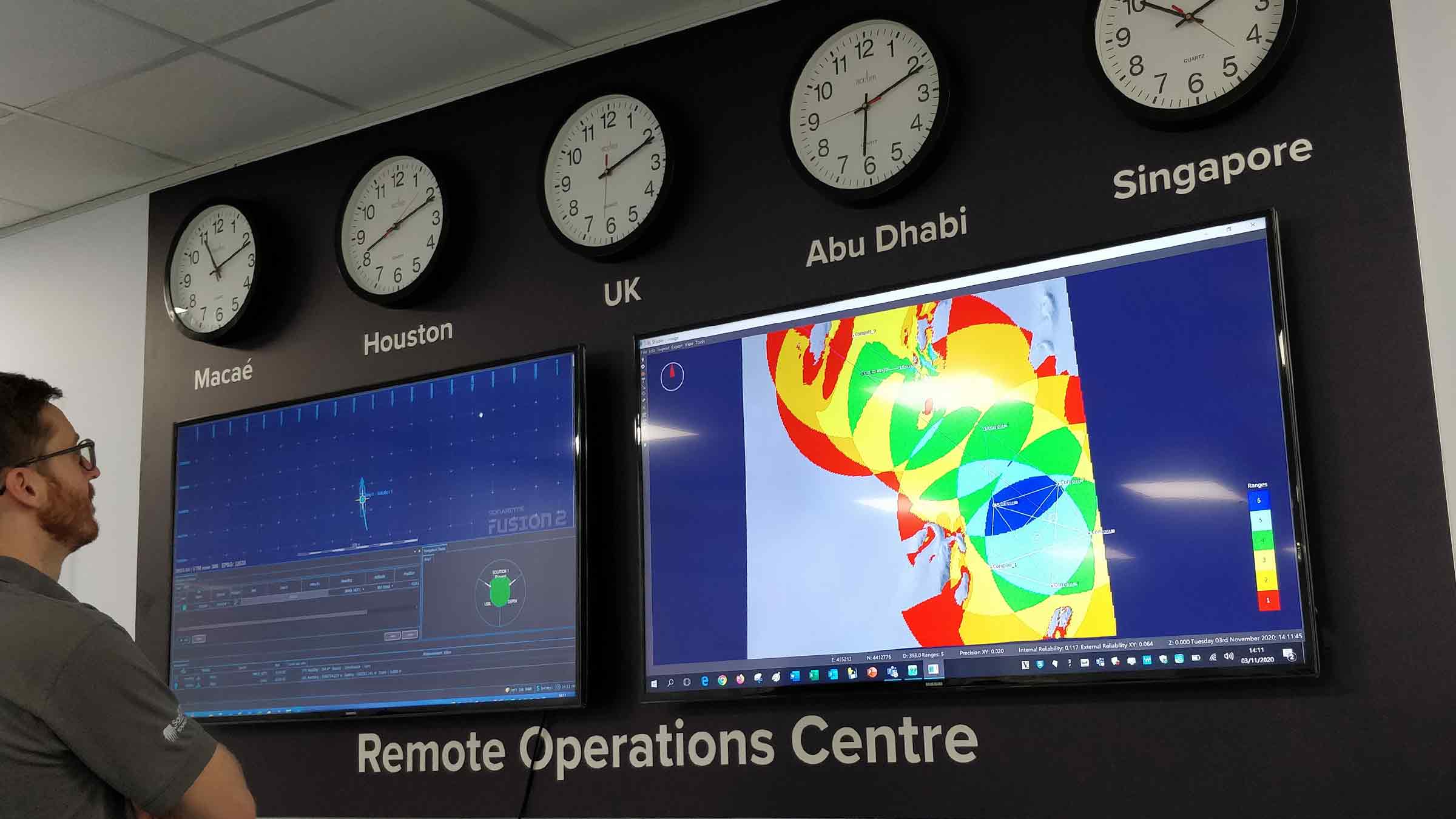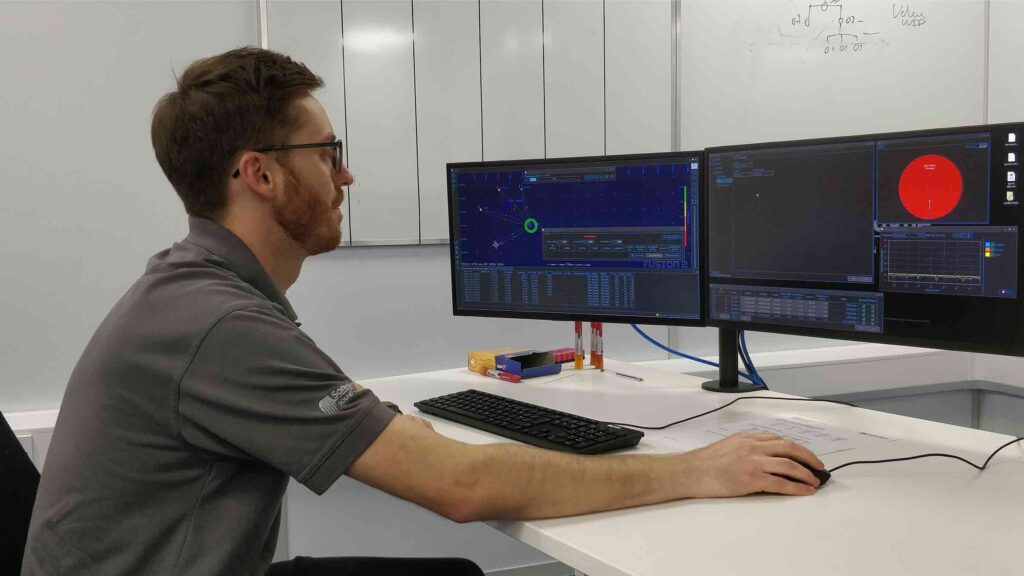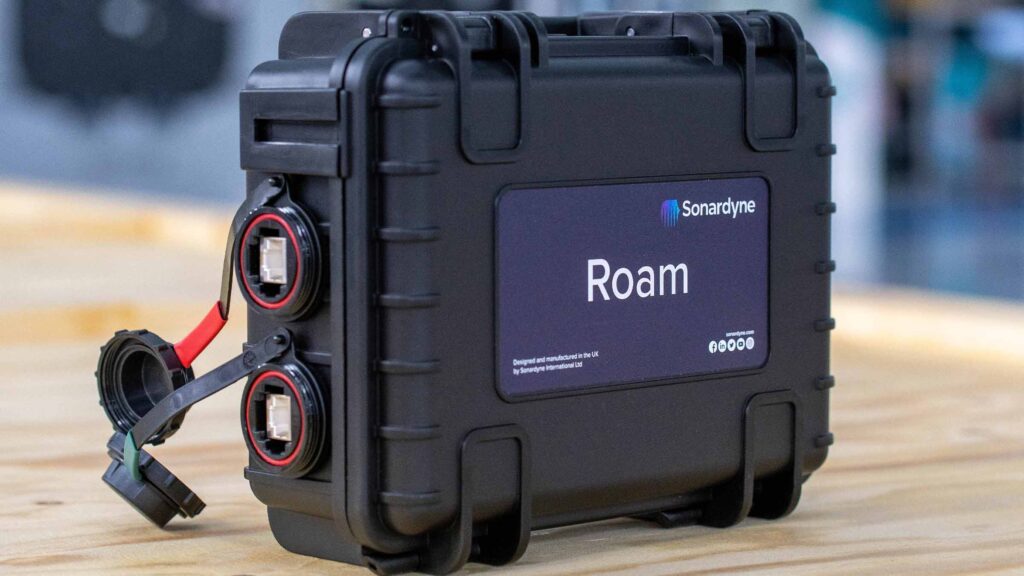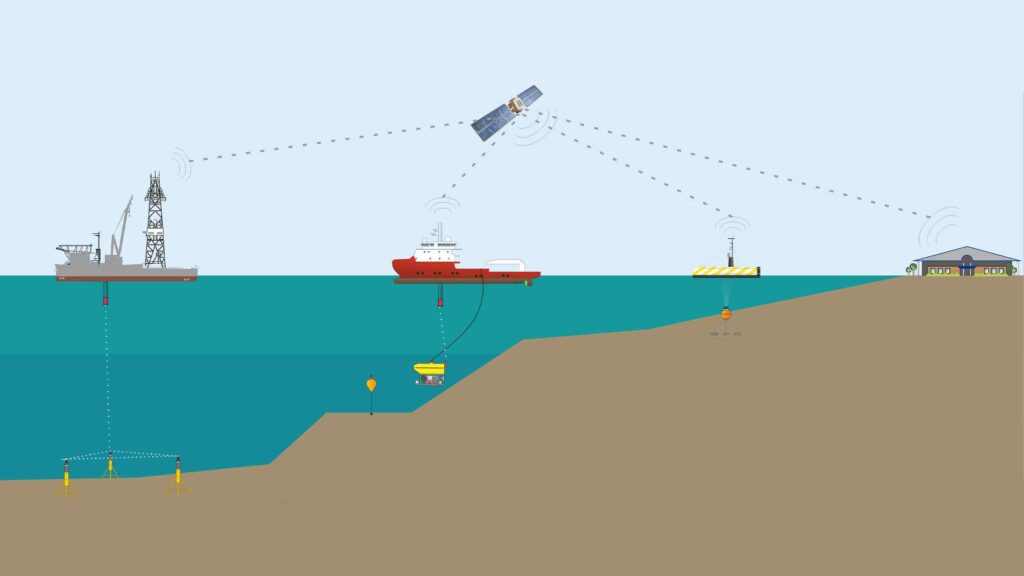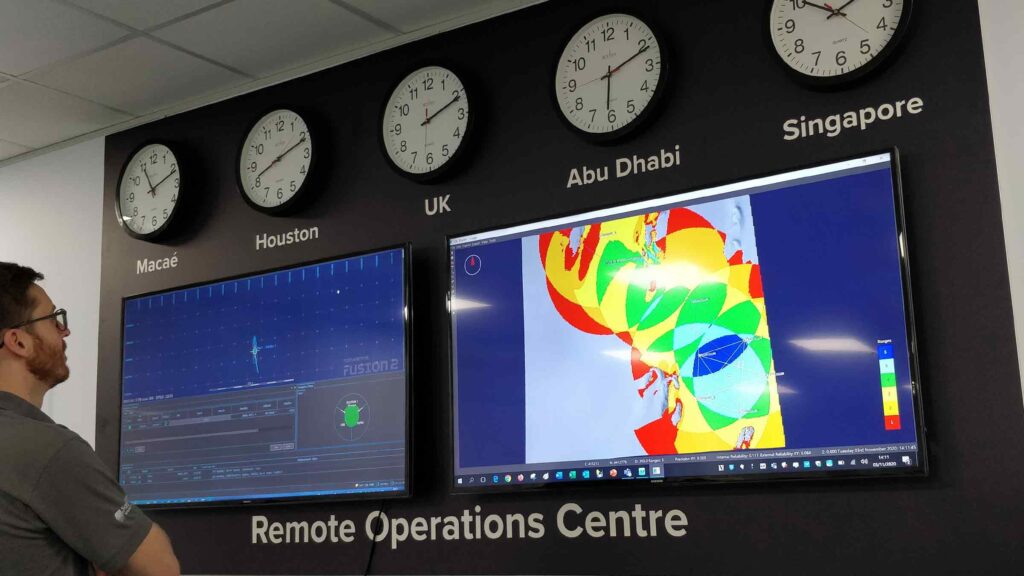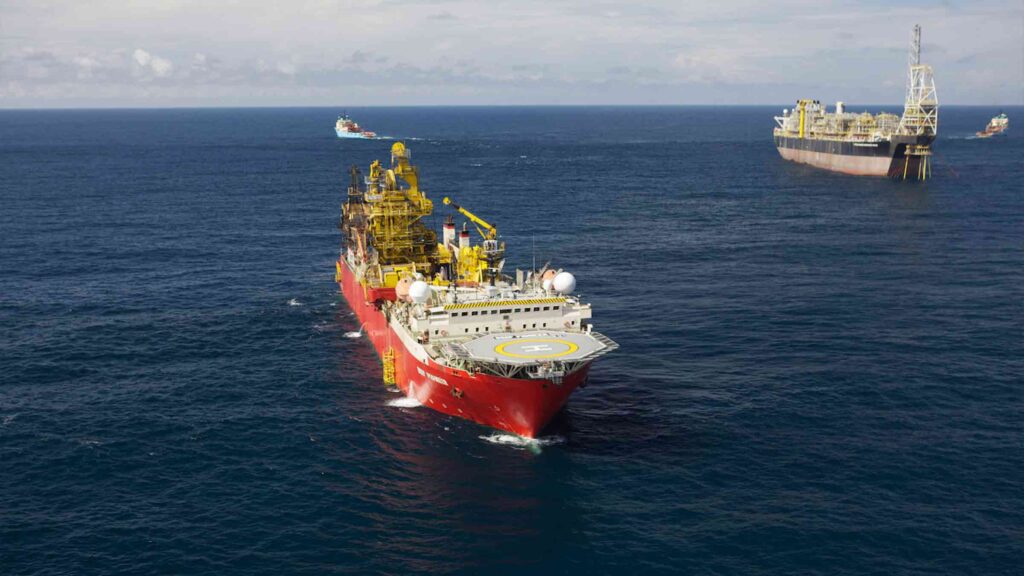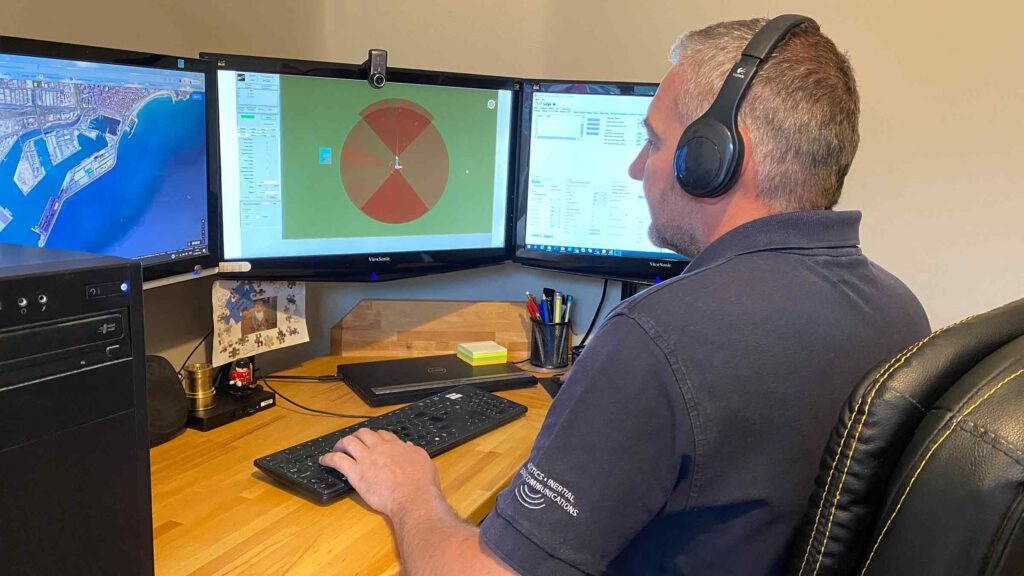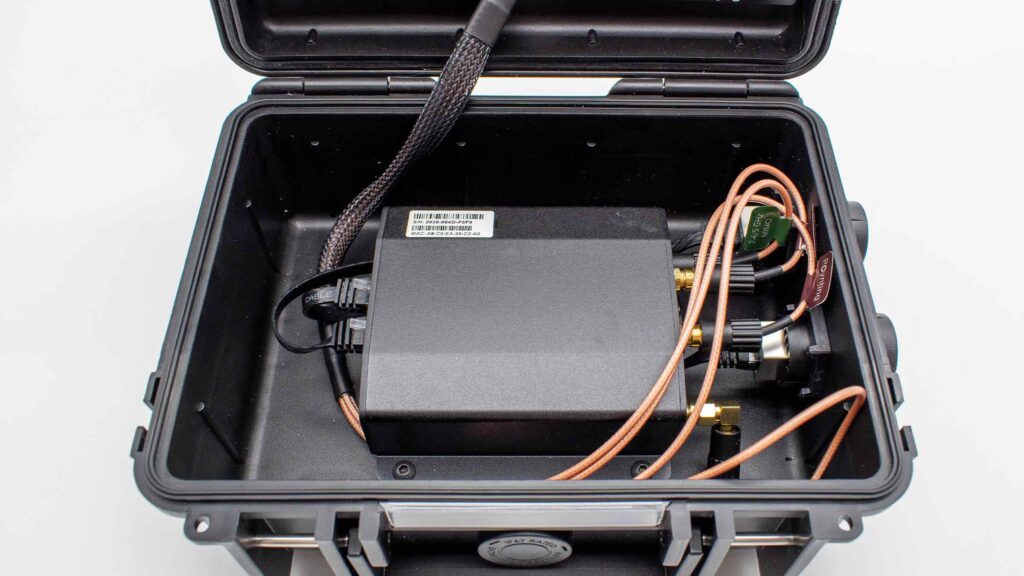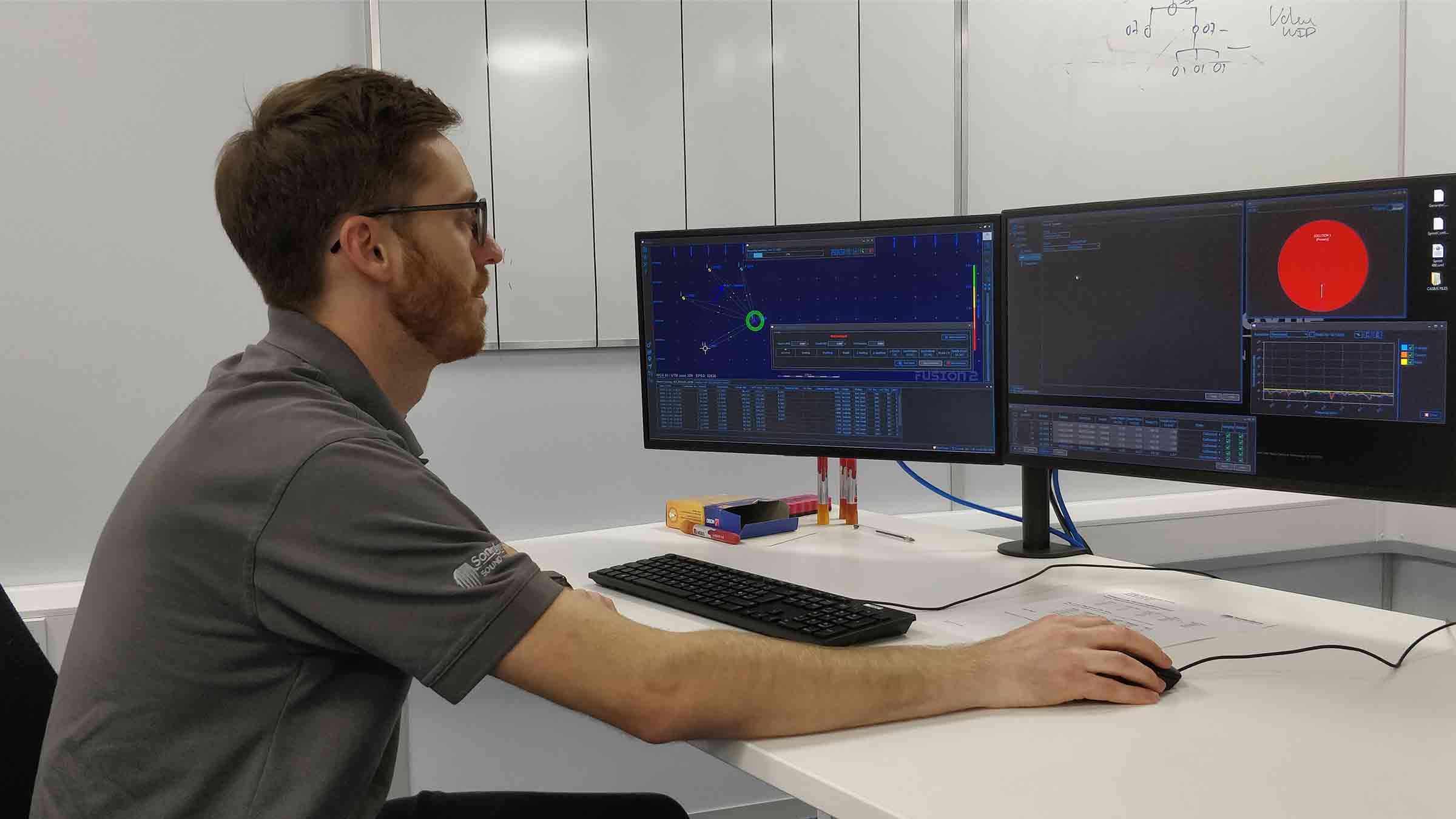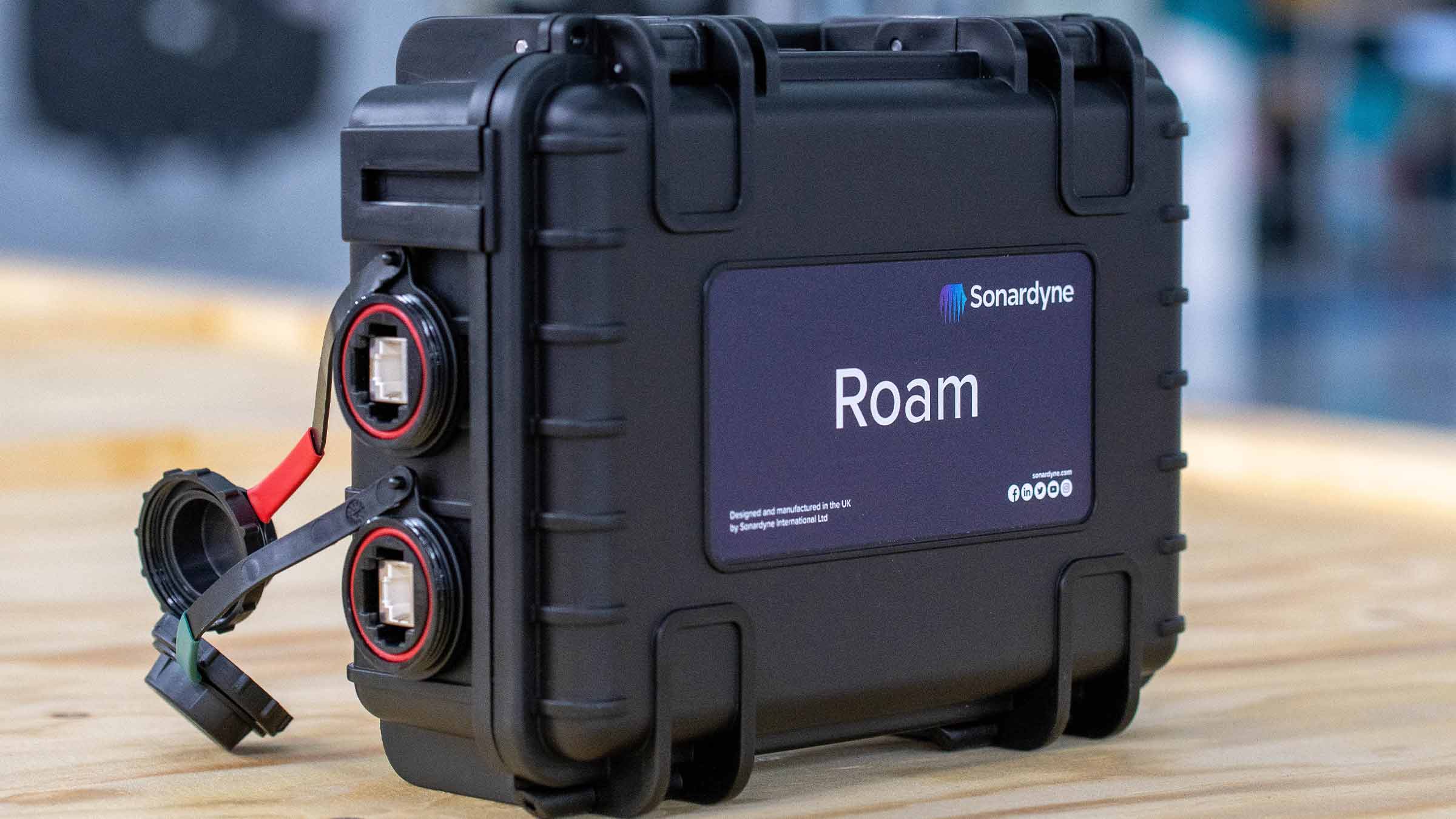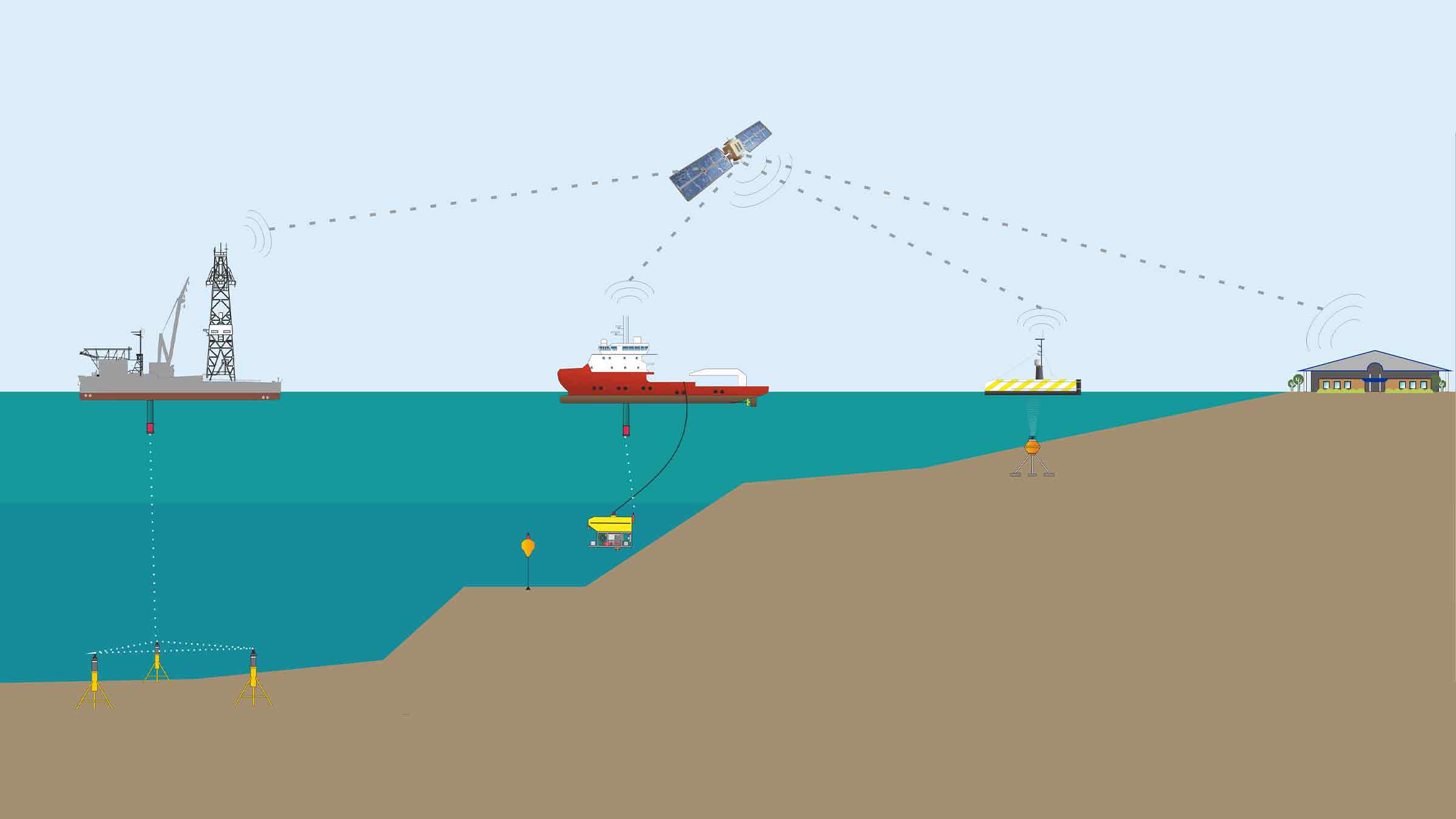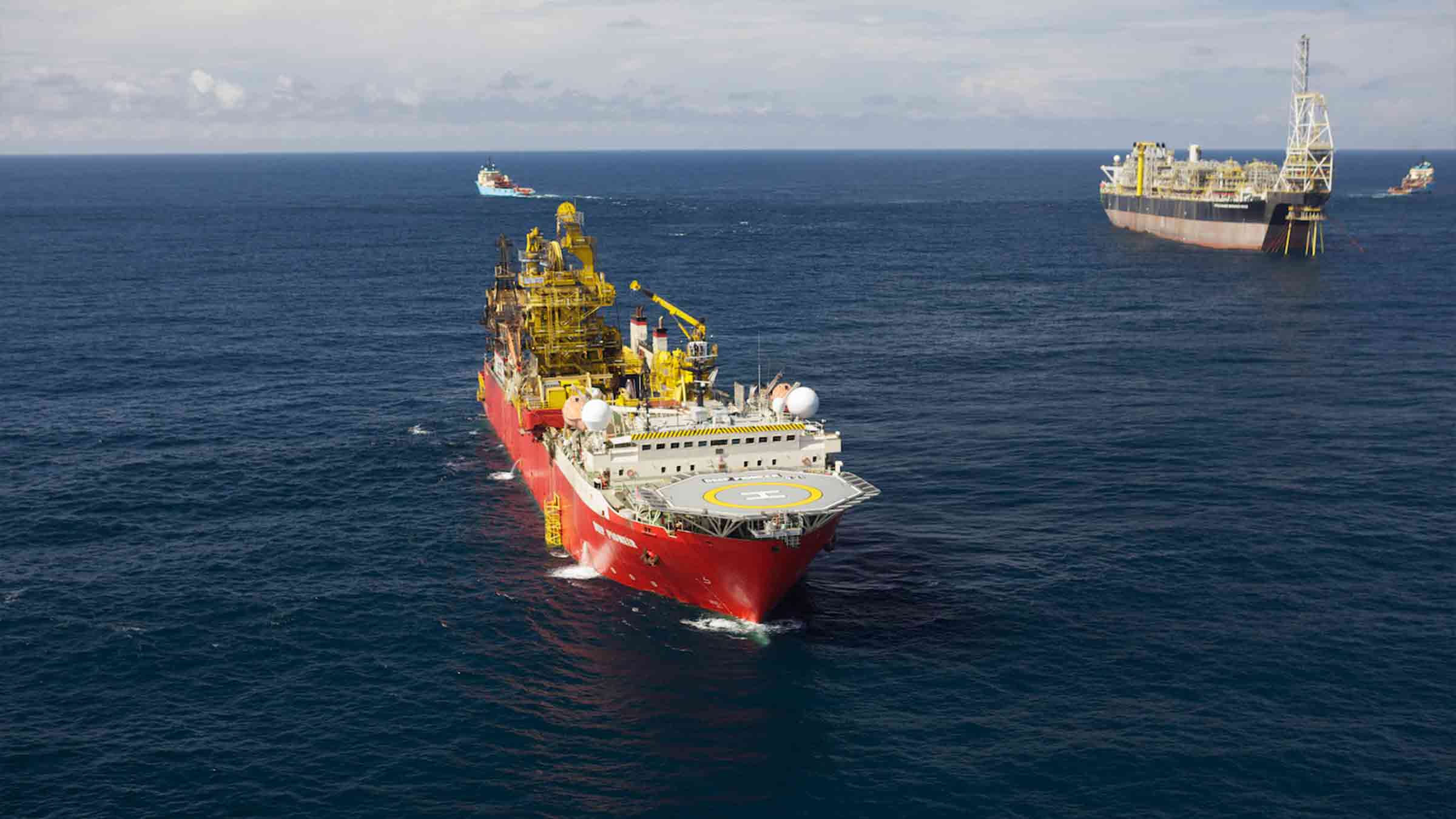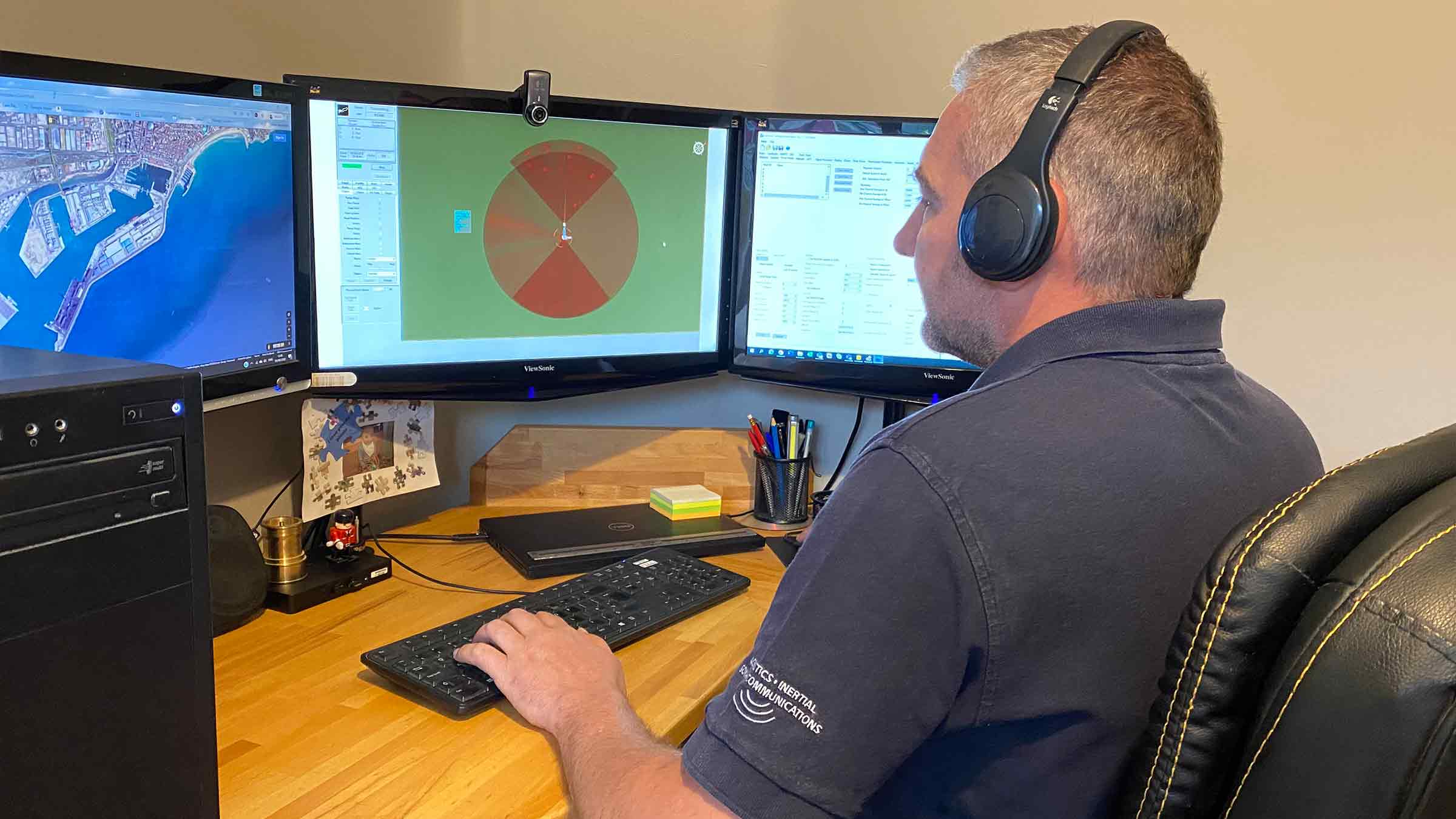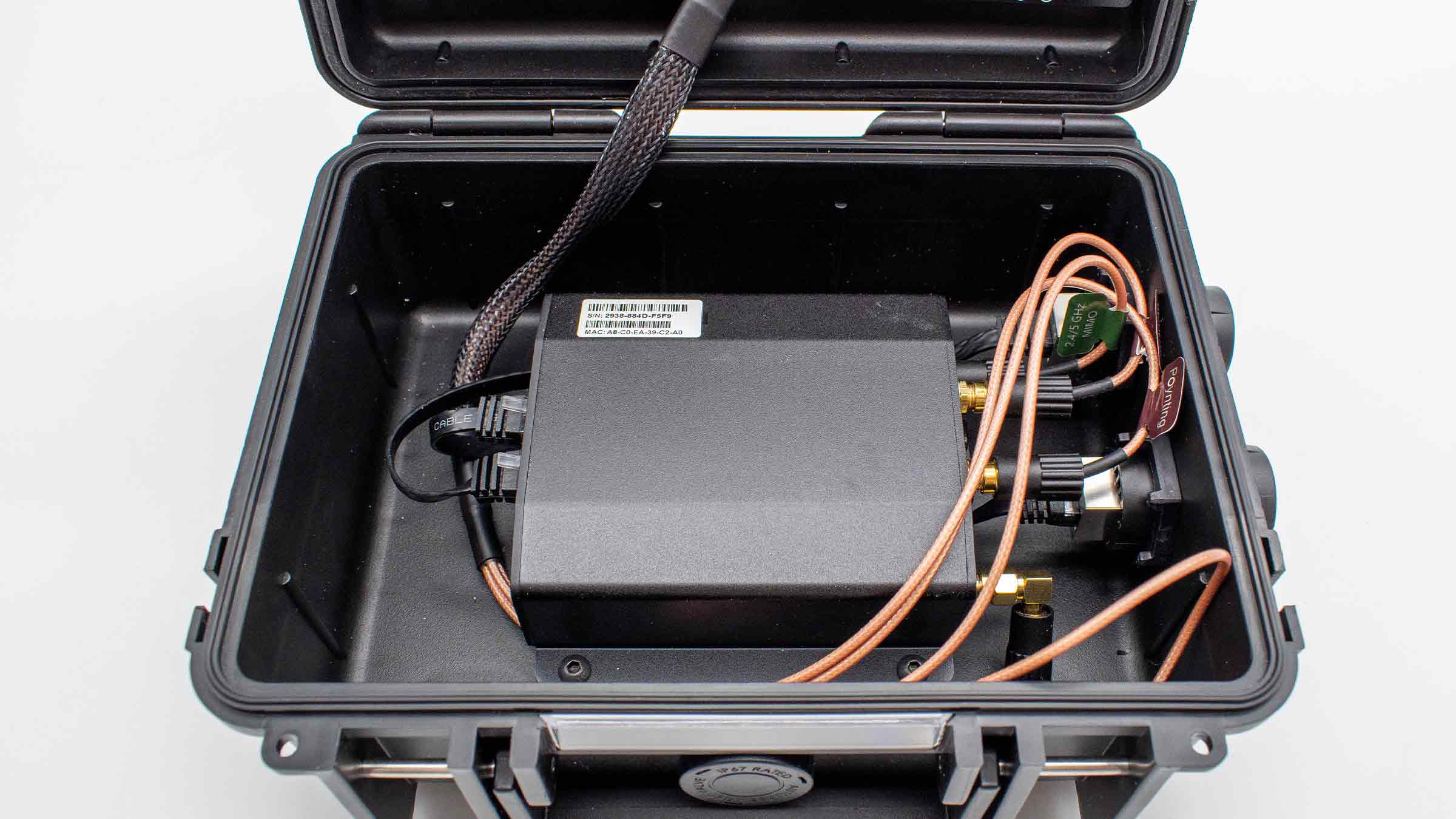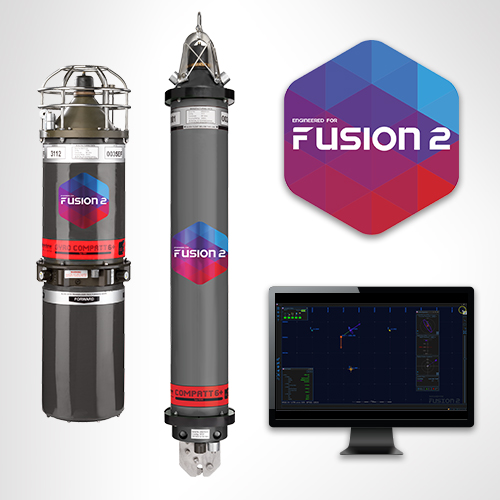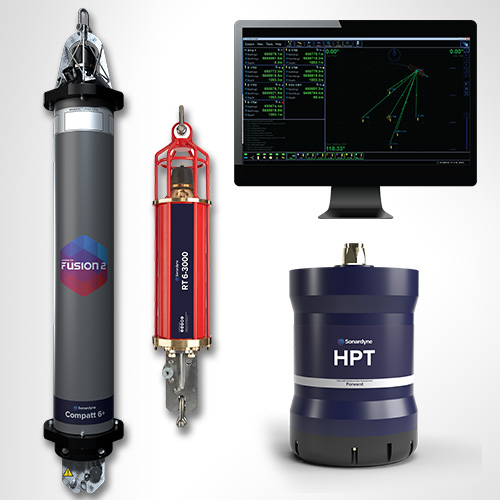Find out what's possible
As with all SPRINT-Nav products, SPRINT-Nav U fuses AHRS, DVL, INS and depth data. All of this is now available in a single, ultra-compact and lightweight instrument giving you fast, precise and robust navigation, guidance and control information.
SPRINT-Nav U surpasses expectations in every way. With fast alignment, one unit, one connector, one cable and all the true-north seeking capabilities found across the SPRINT-Nav Family.
Game changing new capabilities for small robotic operations
Measuring just 134 mm in height and 114 mm in diameter and weighing a mere 600 grams in water, SPRINT-Nav U packs full SPRINT-Nav capability into the space traditionally filled by just a DVL on small subsea robotic platforms. With its compact fibre optic gyro (FOG) Inertial Measurement Unit (IMU) SPRINT-Nav U is a game changer for small vehicle operations.
It’s powered by the same trusted hybrid acoustic-inertial navigation algorithm you’ll find across the whole SPRINT-Nav family. This combines the strengths of all its sensors to provide robust, precise and accurate outputs. SPRINT-Nav U continues to work even in ferrous environments where Micro-Electro-Mechanical Systems (MEMS) based navigation, with its magnetic heading, struggles. This means your operations are provided with a continuous stream of positions, orientation, velocities, depth and altitude even when operating in and around infrastructure.
Ready, set, go
Your SPRINT-Nav U arrives pre-calibrated, meaning there is no need to spend valuable time conducting in-field calibration manoeuvres every time a vehicle is mobilised. It’s the fastest aligning subsea navigator available in the market. Arrive on site, turn it on, give it a position and away you go.
SPRINT-Nav U uses the same, familiar and simple web user interface as the SPRINT-Nav Mini, meaning its already user tested, field proven and has ease of use built in. As is standard for SPRINT-Nav products, the output can be fed directly to your own (or a third party) user interface or vehicle control software.
Need to do an ROV inspection of your offshore energy structures or ports and harbour infrastructure without deploying a large-scale vessel? SPRINT-Nav U will ensure accurate and continuous survey grade navigational data that is unaffected by the materials in such structures.
Conducting a seabed survey with your small AUV, Towfish or USV? No longer worry about the quality of the data you’ll get back as SPRINT-Nav U provides unparalleled navigational inputs for GNSS denied small vehicles and their payload sensors for accurate data collection every time.
Carrying out multiple surveys across a wide area? SPRINT-Nav U’s compact size and weight make it easily man-portable, deployable and retrievable from the back deck of a larger vessel.
SPRINT-Nav U at a glance
- 134 mm tall by 114 mm in diameter; the industry’s smallest all-in-one hybrid acoustic-inertial subsea navigator
- Compact hybrid DVL-INS synergies dramatically improve both robustness and performance compared with standalone instruments.
- Fly higher – 500 kHz DVL maintains bottom lock at up to 100 m altitude
- Four instruments in one small package; AHRS, DVL, INS and pressure sensor – huge capability at optimised cost, size, weight and power (CSWaP)
- Easy to integrate, simple to operate, web UI for configuration
Discover SPRINT-Nav U in action
General
• Ideally suited for small subsea vehicle guidance, control and navigation
• Size, weight and power optimised
• Powered by our class-leading SPRINT hybrid navigation engine
• More compact and cost effective than the four separate sensors
• Gyrocompass simplicity with hybrid acoustic-inertial navigation performance
• Unaffected by proximity to ferrous objects
• Factory calibrated
Design
• Ultra-compact – 134 (H) x 114 (Dia) mm
• 1.98kg weight in air, 0.6kg weight in water
• Water-blocked cable
• Subconn micro circular connector (8-way female)
• Acetal copolymer 300m depth-rated housing
Performance
• True north seeking
• Provides 0.1% error for distance travelled (typical survey)
• Heading accuracy 0.15° secant latitude
• 0.02° pitch/roll accuracy
• 0.3/100 m min/max altitude
• Fast alignment
Ownership
• What’s in the box: SPRINT-Nav U
• Warranty: 1 year return to Sonardyne service centre
• ITAR controlled: No
• UK export licence: Yes
Specifications Table
| Performance | SPRINT-Nav U | |
|---|---|---|
| DVL aided | Typical survey | 0.1% |
| Distance from origin | 0.45% | |
| Altitude min/max | 0.3/100 m | |
| USBL and DVL aided | Precision improvement | Up to 4x |
| Heading (secant latitude) with GNSS or USBL, and DVL | 0.15 | |
| Heading (secant latitude) with GNSS or USBL or DVL | 0.2 | |
| Roll and pitch | 0.02 | |
| Angular rate range | ±450/s | |
| Velocity precision (<2 m/s at 50 m altitude) | <1.0 cm/s | |
| Depth accuracy | 0.01% FS | |
| Power | ||
| Power requirements | 24 V dc ±10%, 8 W nominal | |
| Physical/Comms | ||
| Data storage | 32 GB internal memory | |
| Serial ports/protocol | 1 RS232 (available on cable but not Subconn MCIL8F) | |
| Interfaces | Ethernet, UDP/TCP, WebUI, 1 x trigger inputs/output (1PPS in/out or DVL trigger), NTP, ZDA out | |
| Mechanical construction | POM-C, titanium | |
| Dimensions (diameter x height) | 134 x 114 mm (excluding penetrator) | |
| Weight air/water | 1.98/0.60kg | |
| Environmental | ||
| Depth rating | 300 m | |
| Operating temperature | -5 to 40 degrees Celsius | |
| Storage temperature | -25 to 70 degrees Celcius |
Frequently asked questions
Deployment
STP files
Software and firmware
Datasheets
What's possible
GNSS is your trusted DP reference input. But what if that signal vanishes? Don't let a dropped connection halt your operations Introducing SPRINT-Nav DP – your ultimate second dynamic positioning system.
Forged from a decade of proven excellence with our SPRINT family, this cutting-edge system seamlessly integrates INS and DVL technology, delivering an unshakeable DP reference, especially in GNSS-denied environments. SPRINT-Nav DP is crucial for the growing demands of shallow water operations, ensuring pinpoint accuracy and rock-solid reliability, keeping you on course no matter what. Like all our SPRINT-Nav product family, it’s pre-calibrated, so you can start working right away.
Built for DP class 2, and above operations, its Inertial Measurement Unit (IMU), featuring Honeywell ring laser gyros and accelerometers, works closely with the Syrinx DVL and the pressure sensor. This integration ensures unparalleled accuracy and reliability when dynamically positioning your vessel.
SPRINT-Nav DP saves time and costs while offering unmatched performance and reliability for a range of applications. With SPRINT-Nav DP, you don’t need to deploy other equipment such as transponders or reflectors as the Syrinx DVL locks onto the seabed for its positioning reference. This also increases the operational footprint of your vessel, which is otherwise limited in range or by weather conditions when using sensors.
Using bottom lock on the seabed, alongside pre-calibration, means that SPRINT-Nav DP is operational and can provide your position references as soon as it arrives on site. This makes it ideal for a wide range of shallow water and nearshore operations where GNSS signals are often spoofed, blocked or distorted by nearby structures such as turbines and risers or coastal geography.
Why choose SPRINT-Nav for your DP operations?
Realising the value from tightly integrating high grade INS with other aiding sensors, Sonardyne was the first company to market a hybrid acoustic-inertial family of products for subsea and surface applications – SPRINT-Nav.
The SPRINT-Nav family of instruments has been providing reliable navigation for ROV’s, AUV’s, and USV’s for more than a decade in the harshest of subsea environments, where precision, accuracy and reliability is paramount, and where there is no GNSS signal to depend on.
Renowned for dependable performance, they are the standard fit on hundreds of vehicles operating in the subsea domain. This experience, technology and expertise have led to the development of SPRINT-Nav DP for vessels operating in shallow water where a GNSS signal can’t be relied on.
By law, ships using dynamic positioning must have a number of independent position reference sensors, using different principles, to safely determine and maintain their position. This is known as “meeting class” and the number of independent references required depends on the type of class vessel. Most DP vessels operating in shallow water are class 2.
In shallow water operations, it can be a challenge to meet the requirements for independence and diversity of reference sensors. This can lead to an over reliance on multiple GNSS systems with their common vulnerabilities and failure points.
Removing the need for GNSS to give a DP reference by introducing SPRINT-Nav DP provides you with assurance that your positioning isn’t entirely reliant on a GNSS signal and will therefore still “meet class” in GNSS denied areas. Enabling you to operate safely and within the law.
Performance
• Heading accuracy 0.04° (secant latitude)
• 0.01° Pitch/Roll accuracy
• 0.02% Typical survey accuracy
• Station keeping <2m over 24 hours
• Provides bottom lock up to 230 m
Ownership
• What’s in the box: SPRINT-Nav and test lead
• Warranty: 1 year return to Sonardyne service centre
• ITAR Controlled: No
• UK Export License: Yes
Design
• 240 x 395 mm, 13.1 kg weight in water (100 m depth rating)
• Titanium housing construction
• Onboard data storage and battery backup to ride through brown outs
• Individually water blocked and replaceable DVL transducers
• In field remote performance upgrades: Yes
Applications
• Subsea structure installation
• Nearshore construction
• Station keeping
• Dynamic positioning in GNSS-denied environments
• Offshore windfarm development
• Coastal and nearshore operations
Specifications table
| Performance | SPRINT-Nav DP | |
|---|---|---|
| DVL aided | Typical survey | 0.04% |
| Distance from origin | 0.12% | |
| High Altitude (HA) option | 0.12% | |
| Unaided | 1.2 m in 60 s | |
| Altitude min/max | Standard | 0.4/230 m |
| GNSS aided | Precision improvement | Up to 7x better |
| Station keeping | <2 m over 24 hours | |
| INS/AHRS heading (Secant latitude) (1DRMS) | 0.05º | |
| Roll and pitch (1DRMS) | 0.01º | |
| Pressure sensor | 0.01% | |
| ADCP | Profiling range | 0.4–120 m |
| Velocity range & RMS (along beam) | Up to ±8.4 m/s ±0.4% of measured value | |
| Maximum number of cells | 2557 | |
| Maximum ping rate | 1 Hz (ADCP) | |
| Power | ||
| Power requirements | DVL on and battery fully charged | 24 V ± 10% dc, 15 W nominal, 35 W maximum |
| Internal battery backup | Li-ion/5 minutes | |
| Physical/comms | ||
| Data storage | >1 week of data logging | |
| Ports/protocol | 1x RS485 full duplex, Web UI, TCP/UDP | |
| Other ports | 2 triggers for PPS from GNSS | |
| Mechanical construction | Titanium | |
| Dimensions (diameter x height) (excluding deployment pole mount) |
240 x 395 mm | |
| Weight air/water | 23.9/13.1 kg | |
| Environmental and EMC | ||
| Depth rating | 100 m | |
| Operating temperature | -5 to 50°C | |
| Storage temperature | -25 to 55°C | |
| Standards | EN60945, CE, UKCA |
Frequently asked questions
Combined excellence
Overview
Equinox is a true example of how Covelya Group technologies combine to provide ground-breaking products. Designed around the Solstice MAS from Wavefront Systems, it is commercialised by Sonardyne and features our state-of-the-art SPRINT INS and Mini-Ranger 2 USBL for state-of-the-art navigation and positioning.
The Sonardyne and Wavefront Systems payloads are all mounted on EIVA’s renowned ScanFish 3D, a steerable remotely operated towed vehicle (ROTV). EIVA’s NaviSuite Kuda user interface is used to plan, autopilot and display the gathered data in real-time.
Producing stunningly accurate pictures, it’s ideal for vessels of opportunity or unmanned surface vessels delivering hydrographic, archaeological, search, salvage, unexploded ordnance, and mine countermeasure missions.
At a glance
- Mission ready; designed to support search, classify and map (SCM) and hydrographic operations
- Survey more ground in a single pass; effective area coverage rate (ACR) of up to 1.6 km2/hr
- Along track resolution of 0.15°; best in class delivering maximum detection rates
- Co-located side-scan image and bathy improves your situational awareness
- Real-time motion compensation and positioning accuracies better than 1 m DRMS
- Automatically follows terrain and avoids obstacles
- Suitable for site survey and characterisation and high tempo MCM missions
Why Equinox is perfect for your operations
The ScanFish 3D is a trusted ROTV and, thanks to its inherent stability, the ideal platform to operate Solstice from. At a total weight of 220 kg in air, Equinox can be easily mobilised.
Unlike towed Synthetic Aperture Sonar (SAS) systems, Equinox offers you an affordable, lower-logistics alternative still capable of providing high area coverage rates. By combining leading navigation and positioning from Mini-Ranger 2 USBL and SPRINT INS, imaging data is geo-referenced with an accuracy that’s unrivalled for these types of applications at this price.
Planning a mission is easy. Using NaviSuite Kuda software, you can define your sailing route and run-lines by simply selecting the area you would like to cover. During the mission, NaviSuite Kuda continuously updates the vessel and ScanFish 3D position in real-time.
Equinox also provides real-time geo-rectified waterfall, mosaics and DTM maps and the user interface tools that enable an operator to mark and process objects, including automatic target recognition using AI.
That’s not all; ScanFish 3D can carry heavier payloads and there is room in the fibre cable to include additional payload sensors such as gap fillers. Equinox users can count on improved probability of detection and decreased probability of false alarms, improving the efficiency of your mine countermeasures, archaeological, search and salvage missions.

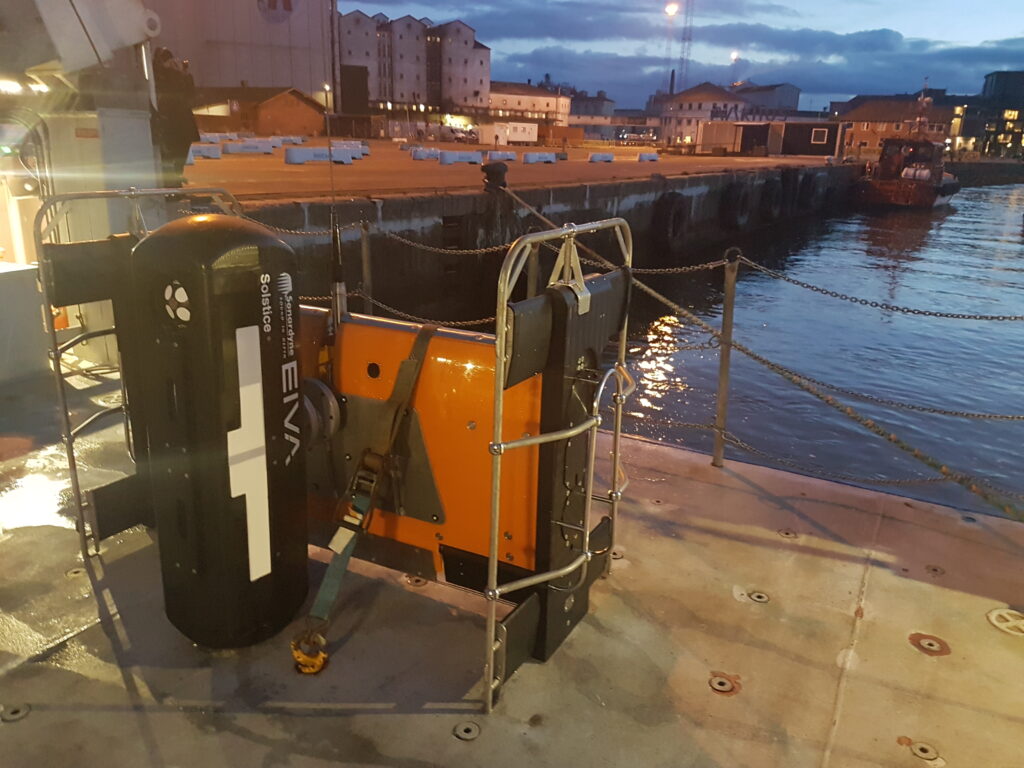
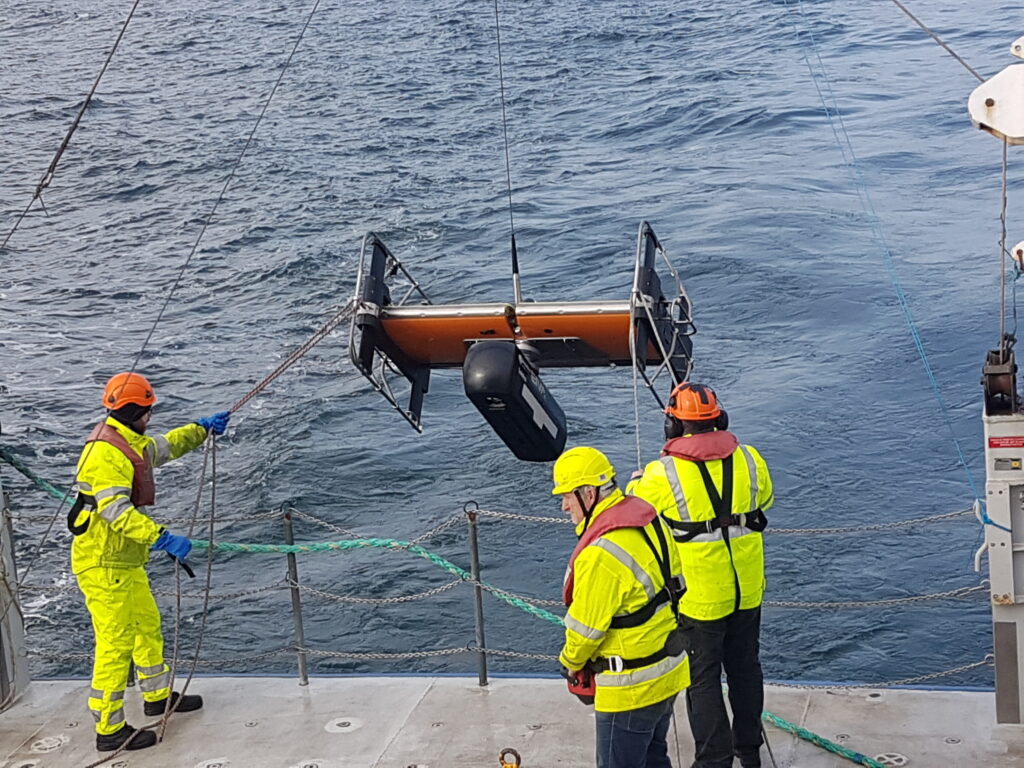
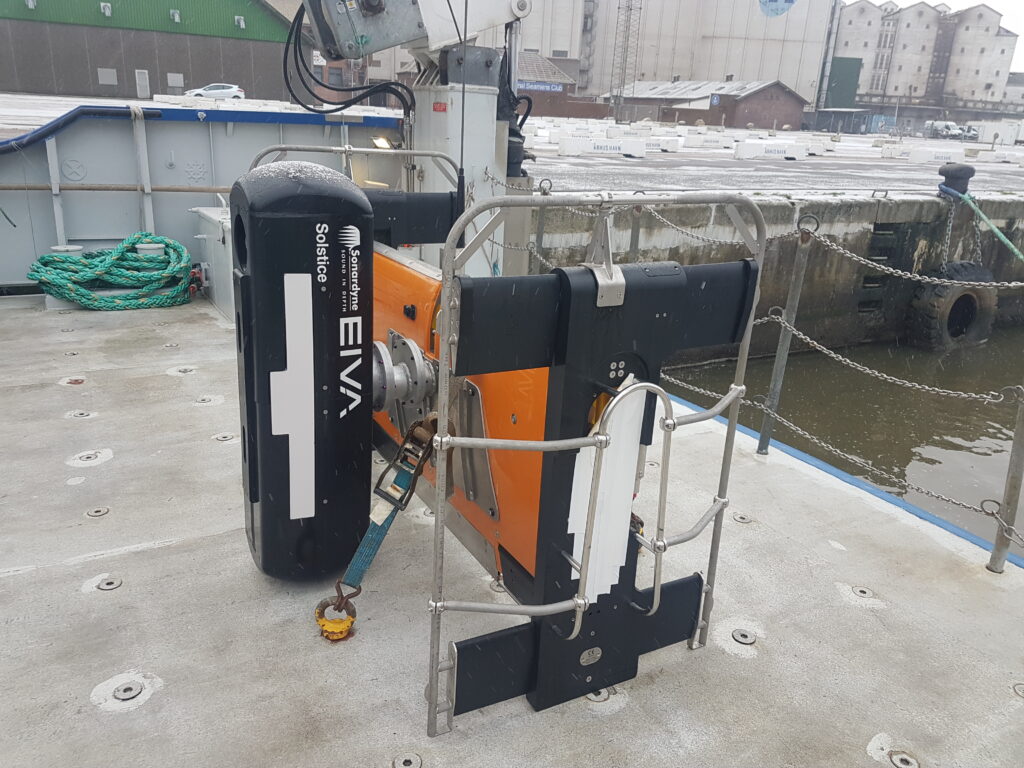
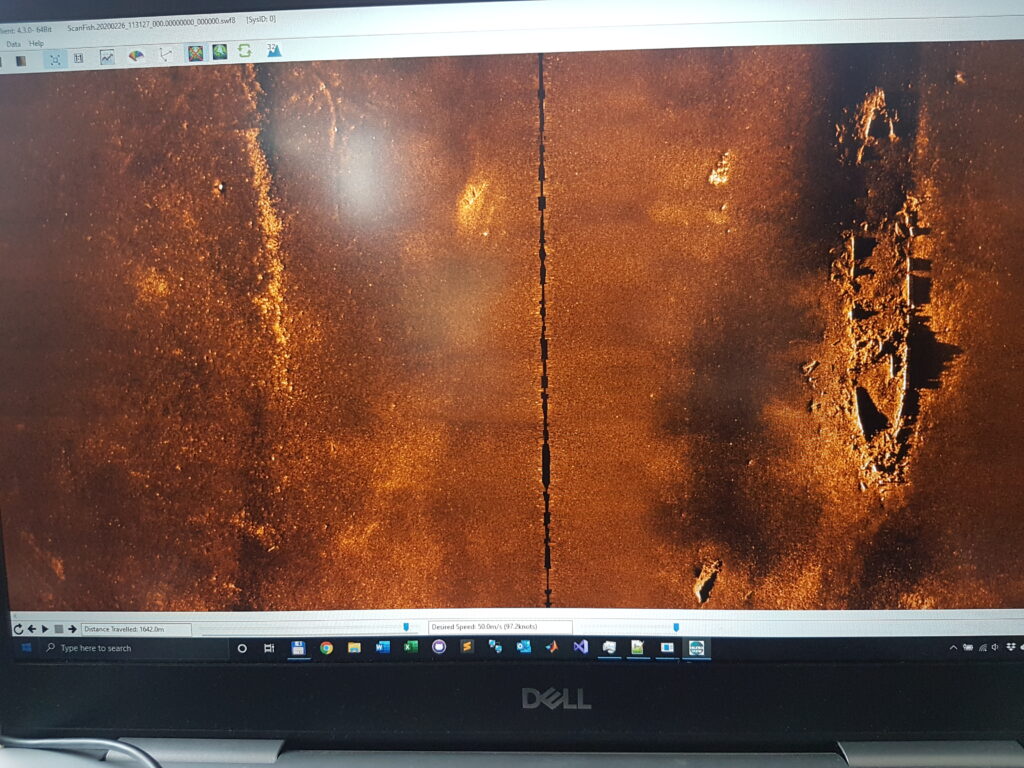
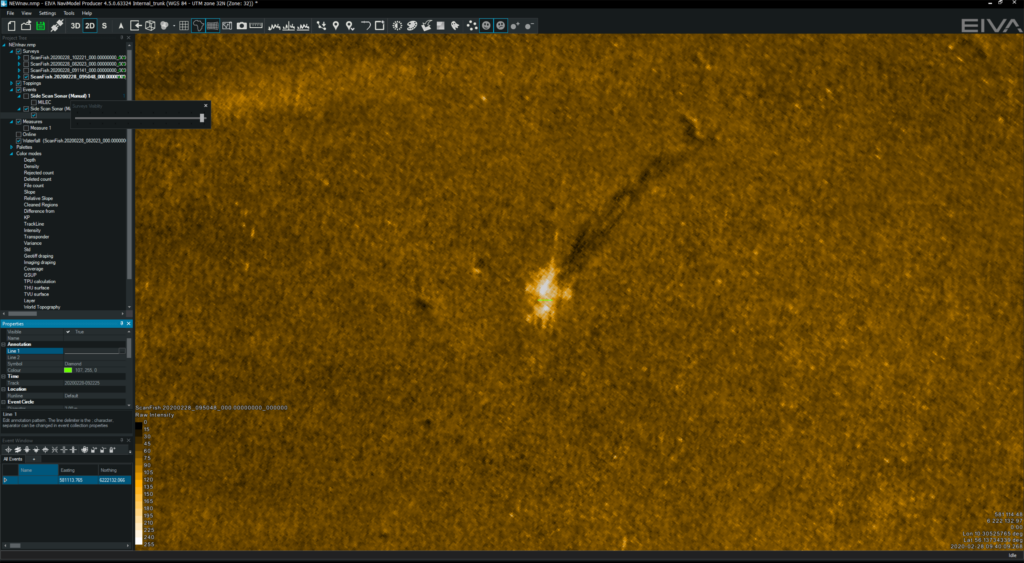
Equinox case studies
General
• All-in-one, rapidly mobilised solution for MCM, SCM and hydrography
• High stability platform with automatic terrain following
• NaviSuite Kuda software reduces planning times and improves processing times
• Everything supplied, including winch and 1Gbps cable
Performance
• Depth rated to 300 m
• Across track resolution 37.5 mm
• Along-track resolution 0.15°
• Geo-rectified waterfall display
• Image resolution 30 mm x 30 mm
• Co-located 200m swath side-scan and bathy
• Real-time CAD/CAC option
Design (SCANFISH)
• 1210 mm x 1858 mm x 1049 mm, 220 kg in air (73 kg in water)
• Survey speeds 3 to 6 knots
• Pitch and roll stabilised
• Automatic altitude following
Ownership
• What’s in the box: ScanFish 3D, NaviSuite Kuda software, cable and winch, Solstice MAS, Mini-Ranger 2 USBL, WSM 6+, SPRINT 500 INS, DVL
• Warranty: 1 year return to Sonardyne/EIVA service centre
• ITAR Controlled: No
• UK Export License: TBD
Datasheets
Navigating the unknown
Key benefits:
- Real-time 3D terrain mapping of seabed and water column
- Extended detection range up to 1.5 km with a 120-degree field of view
- Automated collision hazard warnings
- Compatibility with autonomous vessel systems
- Depth mapping capabilities to 100 metres
- Two operational modes: 3D mode and Sonar mode
Engineered for versatility, Vigilant offers unrivalled underwater situational awareness with a cutting-edge long-range detection system. This compact, powerful system provides unprecedented underwater detection and mapping capabilities for energy, defence, scientific, and autonomous marine operations. Designed by Wavefront Systems and commercialised by Sonardyne, Vigilant forward-looking sonar revolutionises maritime navigation and safety across multiple sectors. Its compact 31 cm-wide design weighing just 14 kg allows for easy installation on vessels ranging from exploration cruises and private yachts to naval ships and research vessels. The system can be seamlessly retrofitted to existing vessels or integrated into new builds.
How it works
The system consists of a sophisticated sonar projector and receiver array mounted at the vessel’s bow, complemented by advanced bridge software. Its proprietary Altitude Confidence Filter (ACF) generates precise, colour-coded depth imagery, enabling crews to navigate challenging environments with confidence.
Seaborne collision avoidance is also a vital consideration for autonomous ships and an ever-increasing number of unmanned surface and underwater vessels in the offshore energy, ocean science and naval market sectors. Vigilant can be integrated into these autonomous platforms to provide essential information to autopilots and command and control systems, to aid safe navigation and manoeuvres around hazardous obstacles.
Vigilant has two principal operating modes, 3D mode and Sonar mode. 3D mode produces stunning 3D bathymetry and colour coded depth imagery using our proprietary Altitude Confidence Filter (ACF), out to 600 m and down to 100 m. Sonar mode processes the intensity of the acoustic data to extract long-range positional data out to 1.5 km and over a 120 degree field of view. In this mode, the sonar returns are used to generate alerts to the operator (or a third-party system) to the presence of a navigationally relevant obstacle.
For naval and security applications, Vigilant can be combined with Sentinel intruder detection systems, providing comprehensive underwater threat protection. Whether exploring secluded bays, navigating busy shipping lanes, or venturing into polar regions, Vigilant delivers unparalleled maritime intelligence and safety.
Comprehensive engineering support is available to ensure seamless installation and commissioning, making Vigilant your essential tool for modern marine operations.
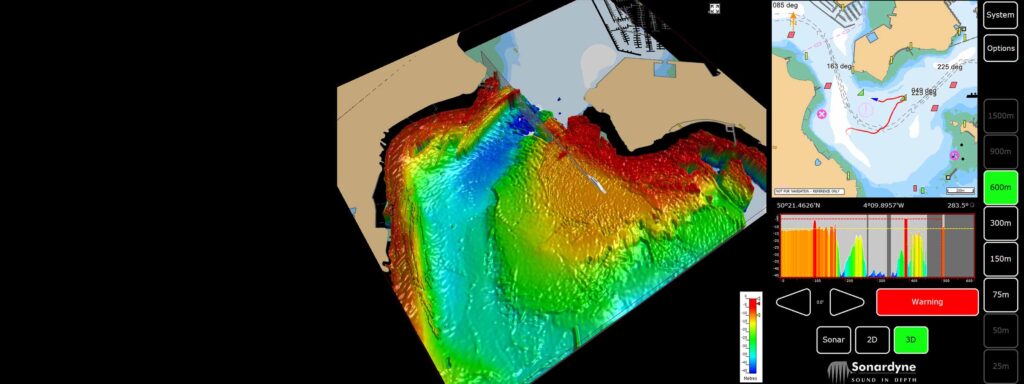

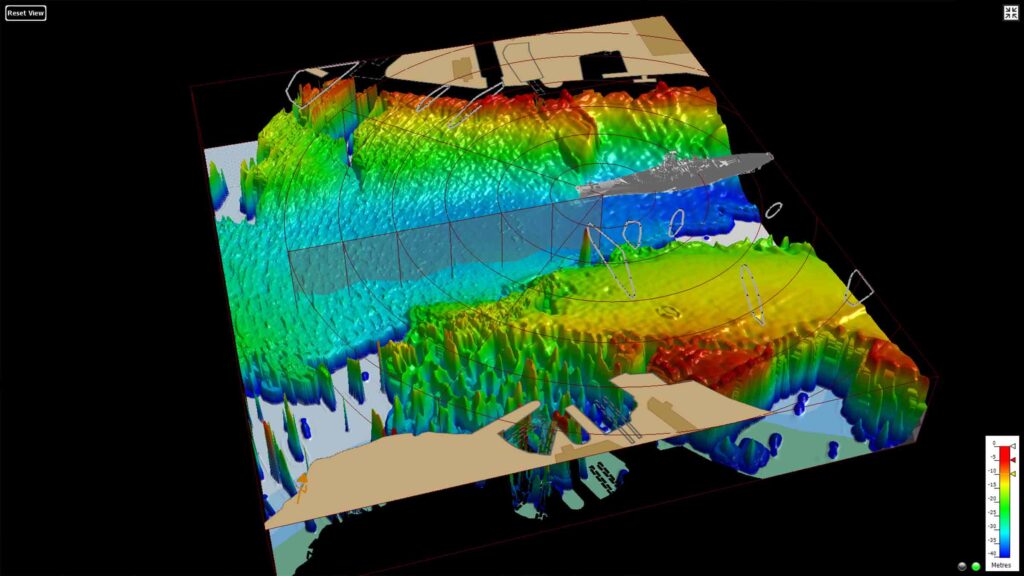
Over 2km coverage from one unit
Key benefits
- Up to 2,400 m diameter protection zone using a single sonar head
- Detects divers up to 900 m away and UUVs up to 1,200 m away
- Up 10 targets tracked and classified simultaneously
- Helps protect ports, harbours, naval bases, private yachts, residences, power stations, offshore platforms
- Rapidly deployed for instant protection
- Low false alarm rate
- In service globally since 2007
- One of the smallest IDS solutions on the market; take it and deploy it anywhere
- Commercial-off-the-shelf technology that integrates seamlessly with your existing security systems
- No specialist sonar experience needed; software automates most of the heavy lifting
- Can be remotely monitored from anywhere in the world
Discover Sentinel, the cutting-edge maritime security system designed to revolutionise your underwater threat detection and protection. Our innovative technology combines unparalleled flexibility with intelligent threat assessment, offering you comprehensive security solutions for diverse maritime environments. From compact deployments on patrol vessels to extensive networked systems protecting expansive naval bases and container ports, Sentinel adapts seamlessly to your operational requirements. With its lightweight design, advanced algorithmic discrimination, and seamless C2 system integration, Sentinel empowers security personnel to monitor critical areas with unprecedented precision and efficiency, dramatically reducing false alarms while ensuring comprehensive threat detection. It is suitable for:
- Vessel security
- Naval ship protection
- Port and harbour security
- Naval base protection
- Protecting your maritime assets from underwater threats
How it works
Sentinel is your cutting-edge underwater security system designed to detect and track potential underwater threats across a wide range of environments. Designed by Wavefront Systems and commercialised by Sonardyne, this innovative technology provides comprehensive protection for your critical infrastructure, naval vessels, ports, and private properties.
With remarkable detection capabilities, Sentinel can identify divers up to 900 metres away and uncrewed underwater vehicles (UUVs) at distances of 1,200 metres. The system is versatile and easy to deploy, whether protecting a commercial harbour, critical national infrastructure, or a private yacht. Its advanced sonar technology can be quickly installed on boats, ports, or coastlines, creating an instant underwater security shield that operates autonomously.
Its user-friendly design sets Sentinel apart. The complex sonar technology is packaged into intuitive software, allowing security personnel without specialised technical expertise to operate the system effectively. For enhanced threat response, an optional accessory called Scylla can broadcast pre-recorded or live audio messages to divers up to 600 metres away, providing an additional layer of deterrence. Whether dealing with busy harbours, shallow waters, or strategic infrastructure sites, Sentinel offers you reliable, real-time monitoring and threat tracking in virtually any marine environment.
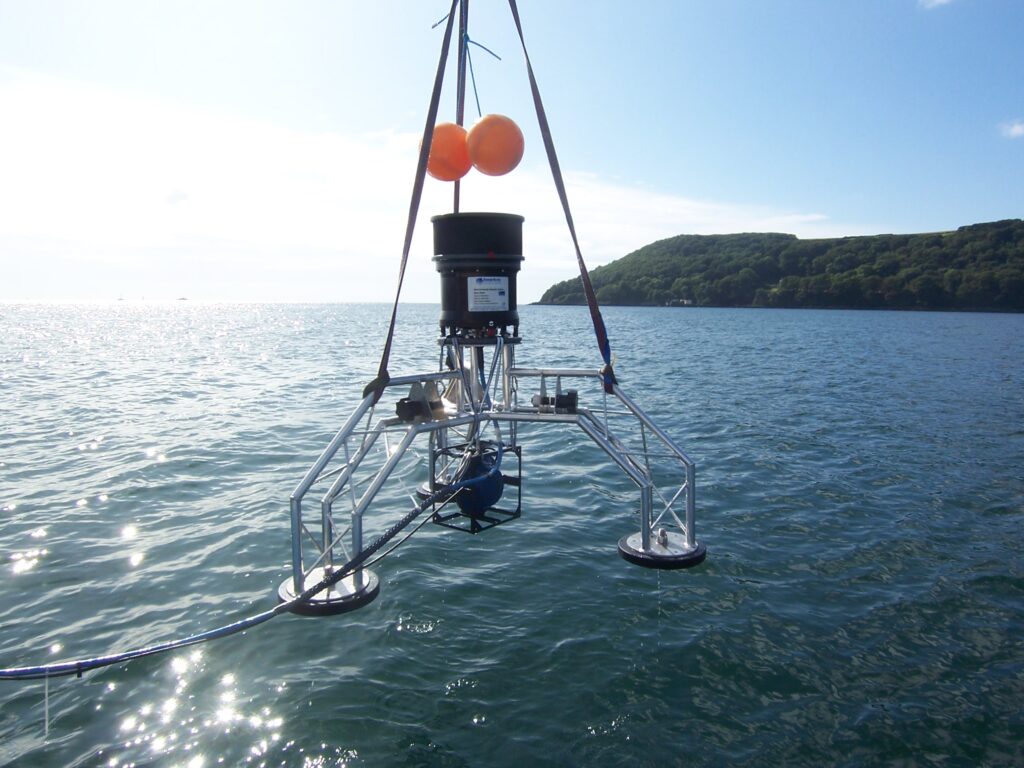
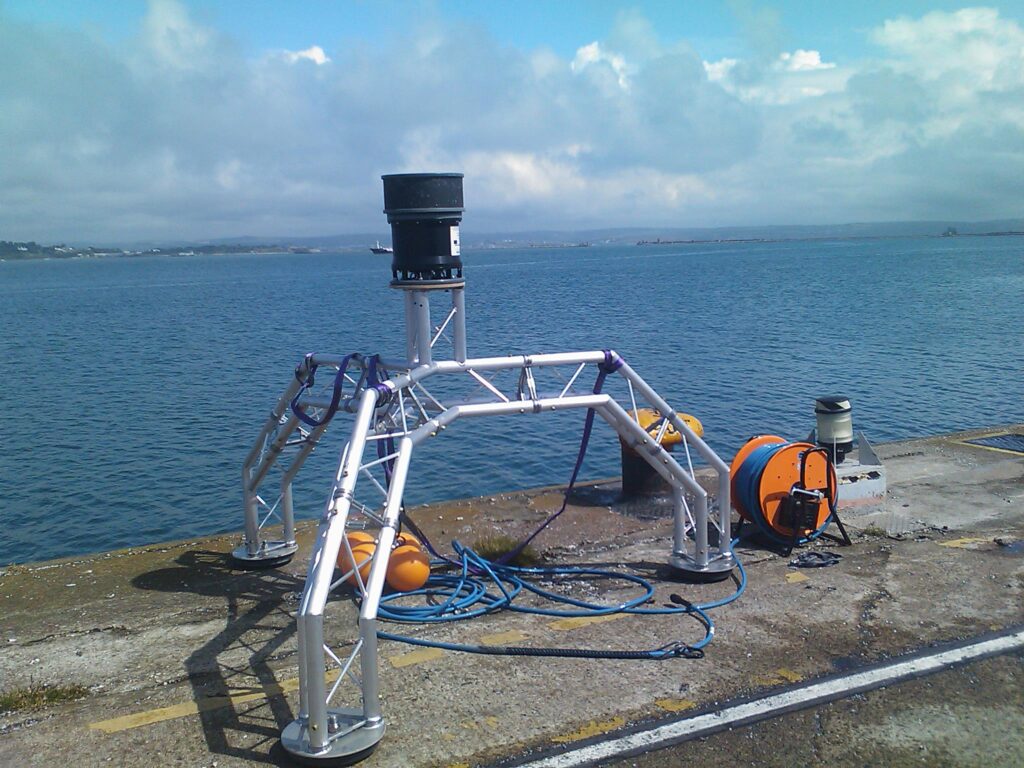
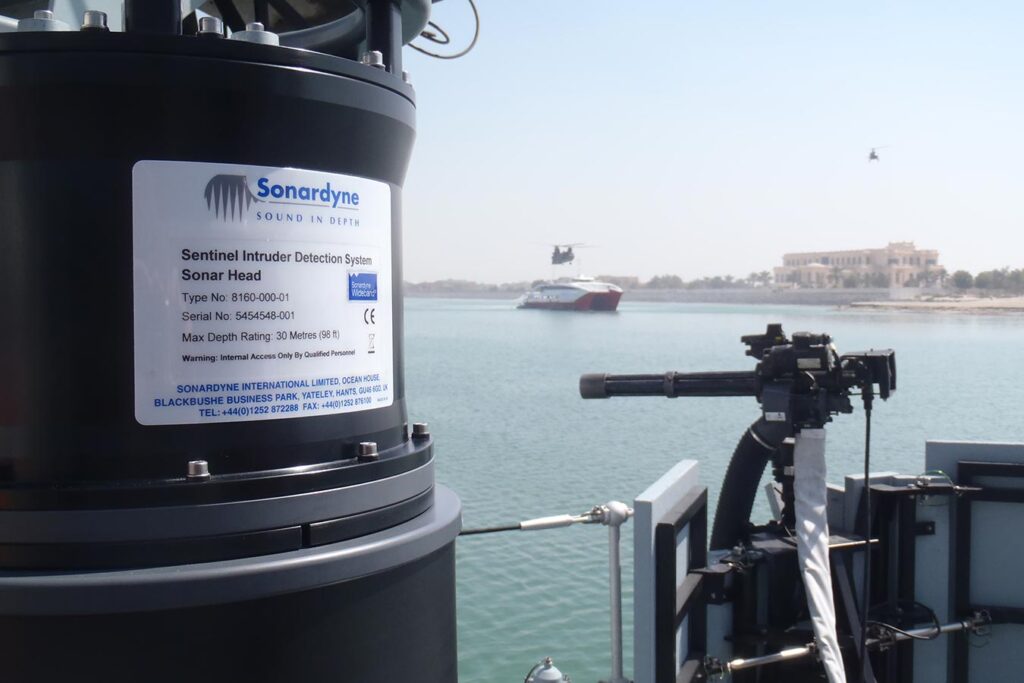
Capture every feature and every detail in ultra-high resolution.
Key benefits
- Mission ready; designed to support search, classify and map (SCM) and hydrographic operations
- Small and compact arrays; optimised for low-logistic AUVs and towed bodies
- Survey more ground in a single pass; 200 m-wide swath ensures high coverage rates
- Along track resolution of 0.15°; best in class delivering maximum detection rates
- Collocated side scan image and bathy improves your situational awareness
- Consumes only 18 W power: budget friendly and increases your AUV’s endurance
- Depth rated to 300 or 600 m
Solstice offers enhanced underwater detection capabilities for various missions, including mine countermeasures, archaeological, search, and salvage operations. The system provides high-performance coverage with large 200m swaths on each side, enabling efficient site characterisation without sacrificing detail. Its class-leading imagery allows you to make confident classification decisions more quickly, with the added versatility of deployment on both autonomous underwater vehicles (AUVs) and towfish platforms. By improving probability of detection and decreasing false alarms, Solstice significantly increases the overall efficiency and reliability of underwater exploration and survey missions. It is suitable for:
- Autonomous underwater vehicles (AUV)
- Site survey and characterisation
- Mine countermeasures (MCM)
- Remotely operated vehicles (ROV)
- Delivering pixel perfect imaging
Exceptional high-contrast seafloor imagery across diverse water depths
How it works
Solstice, designed by Wavefront Systems and commercialised by Sonardyne, is a world-leading side scan sonar for autonomous underwater vehicles (AUVs) and towed bodies. Its advanced technology delivers exceptional seafloor imagery through multiple aperture arrays with 32 multibeam elements, enabling superior signal-to-noise ratio performance and stunning imagery at extended ranges. The sonar’s unique back-projection beam-forming technique ensures focused imaging for every pixel, eliminating distortions caused by platform motion and guaranteeing 100% ground coverage across diverse water depths.
Designed for a wide range of marine missions including hydrographic, archaeological, search, salvage, and mine countermeasure operations, Solstice stands out through its innovative features. Its real-time array calibration dynamically recalibrates hydrophone elements multiple times per second, compensating for dynamic strains and maintaining linear element alignment. The system produces high-contrast imagery in environments ranging from 600-metre depths to very shallow littoral waters, utilising a specialised array technology that provides wide swath coverage with exceptional shadow contrast.

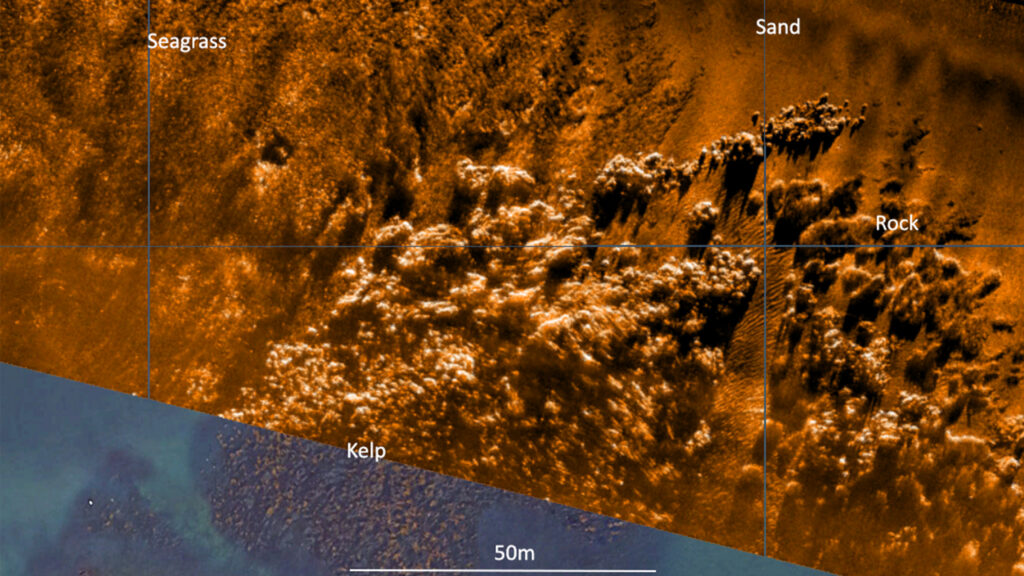
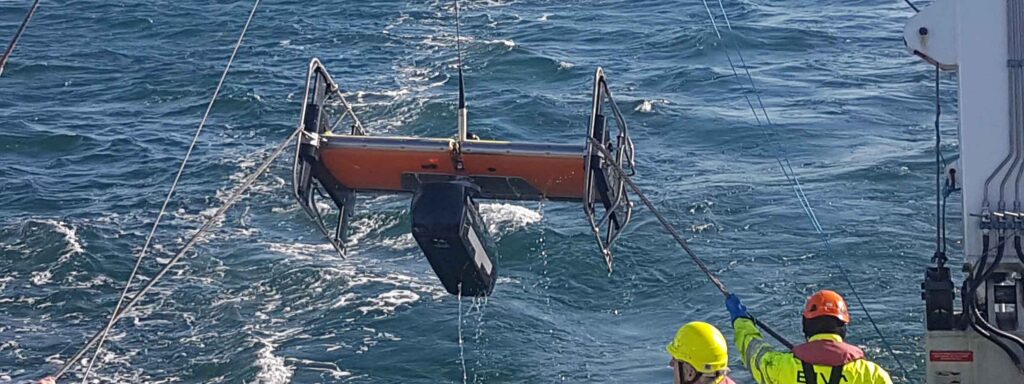
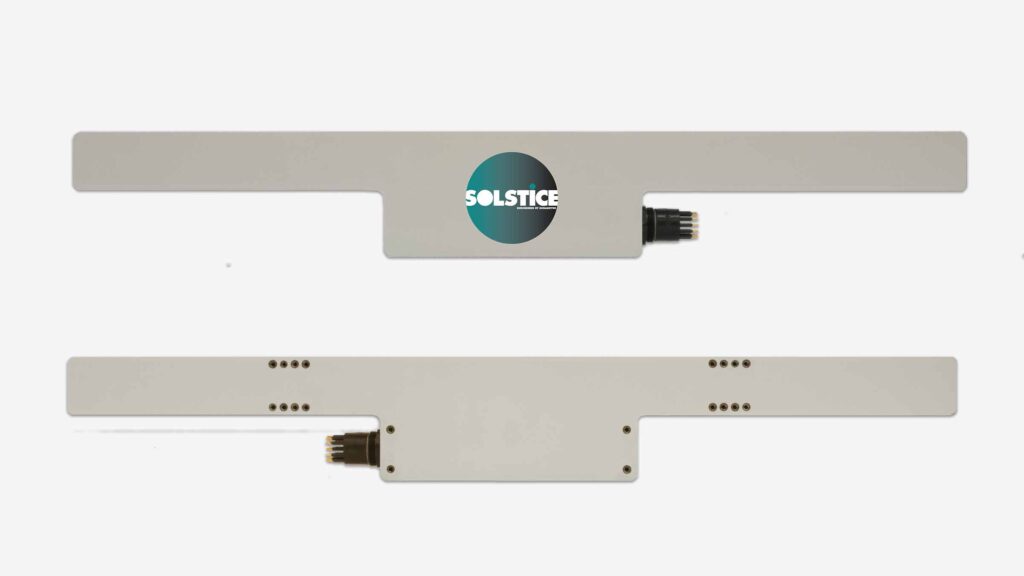
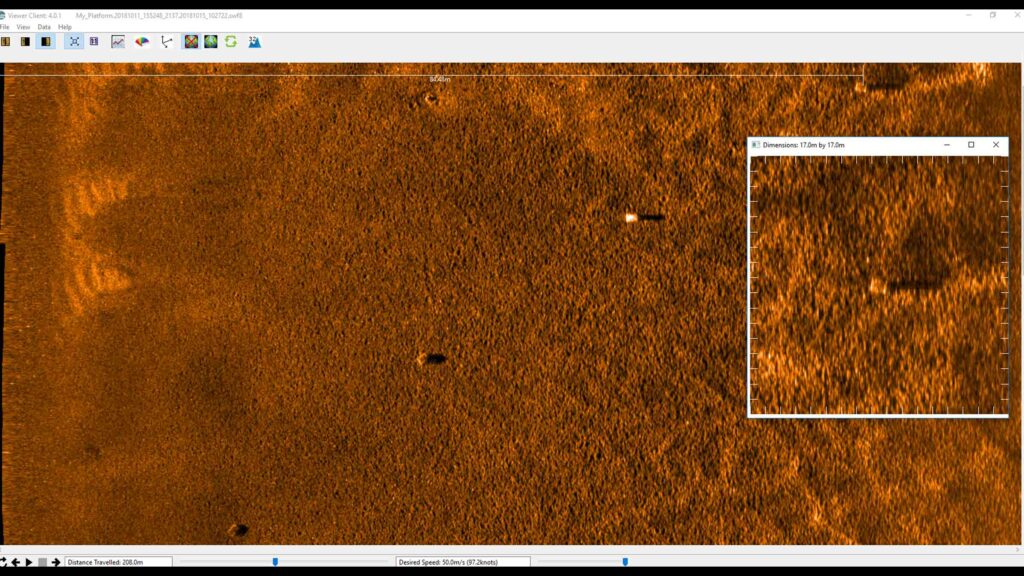
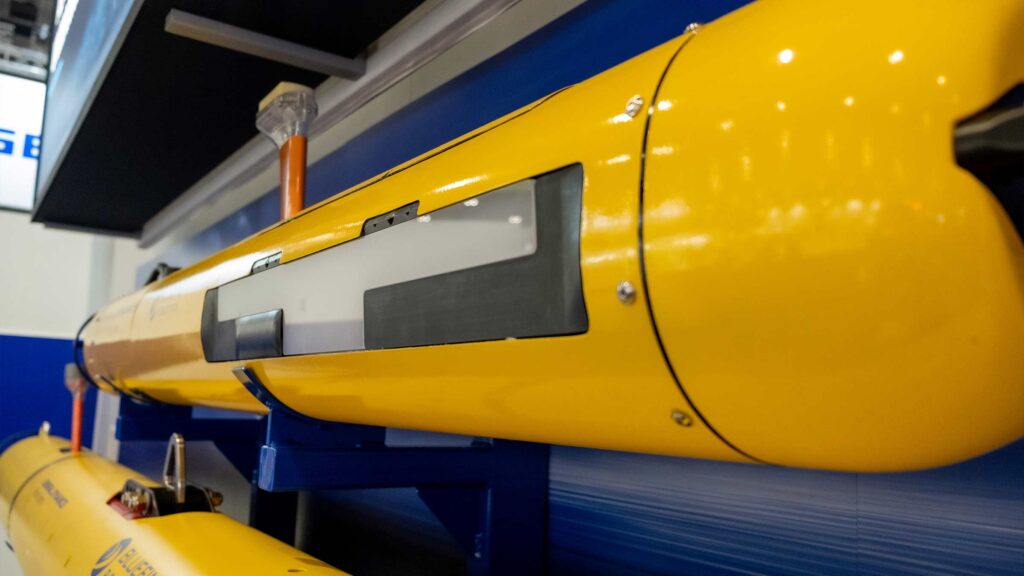
Solstice case studies
Overview
Our range of heavy duty acoustic release frames increase the Working Load Limit (WLL) of RT 6-3000 and RT-6000 acoustic release transponders, enabling you to lift, lower and release heavy loads onto the seabed, including structures and specialist equipment.
The Type 7869-000-01 release frame increases the WLL of a standard RT 6-3000 or RT 6-6000 to 7,500 kg (at 4:1 safety factor) with a breaking load of 30,000 kg. The type 7869-000-05 release frame increases the WLL of a standard RT 6-3000 or RT 6-6000 to 15,000 kg (at a 4:1 safety factor) with a breaking load limit of 60,000 kg.
The Type 7988 release frame has a WLL of 25,000 kg and breaking load of 100,000 kg.
In most cases, both types of release frame can be fitted without any modification to the acoustic release itself and are easily assembled in the field. Manufactured from high-strength steel which is galvanised and powder coated, the releases offer excellent corrosion resistance for long-term deployment.
Applications for which the acoustic releases have been developed include civil engineering, offshore construction, offshore renewables, marine salvage, defence and ocean science.
At a glance
- Working Load Limit of 7,500, 15,000 or 25,000 kg
- Breaking load of up to 100,000 kg
- Choice of depth rating: 4,000 or 12,000 m
- Compact size; just over 1 metre long
- Industry standard lifting rings
Suitable for
- Subsea structure installation
- Research vessels
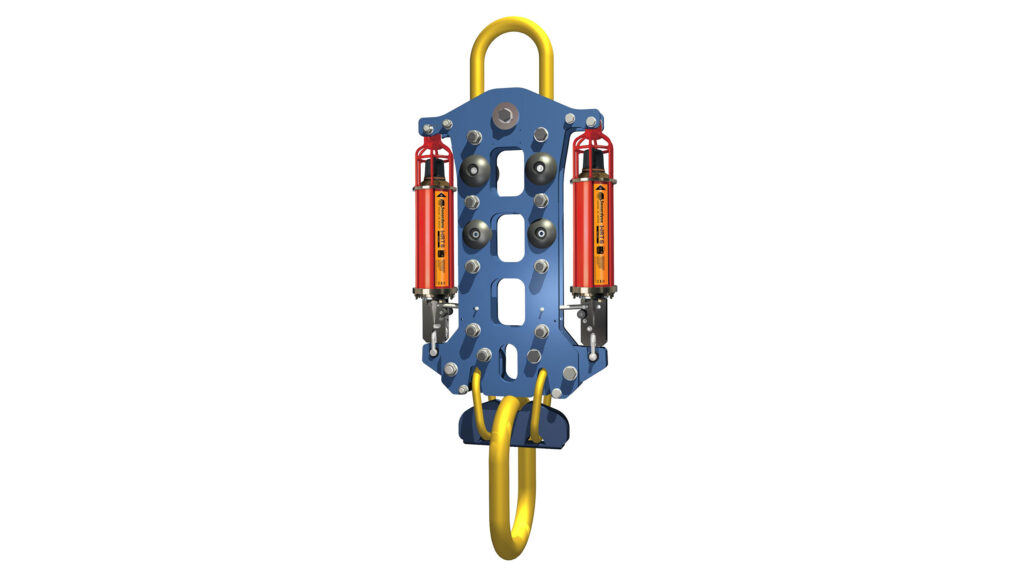
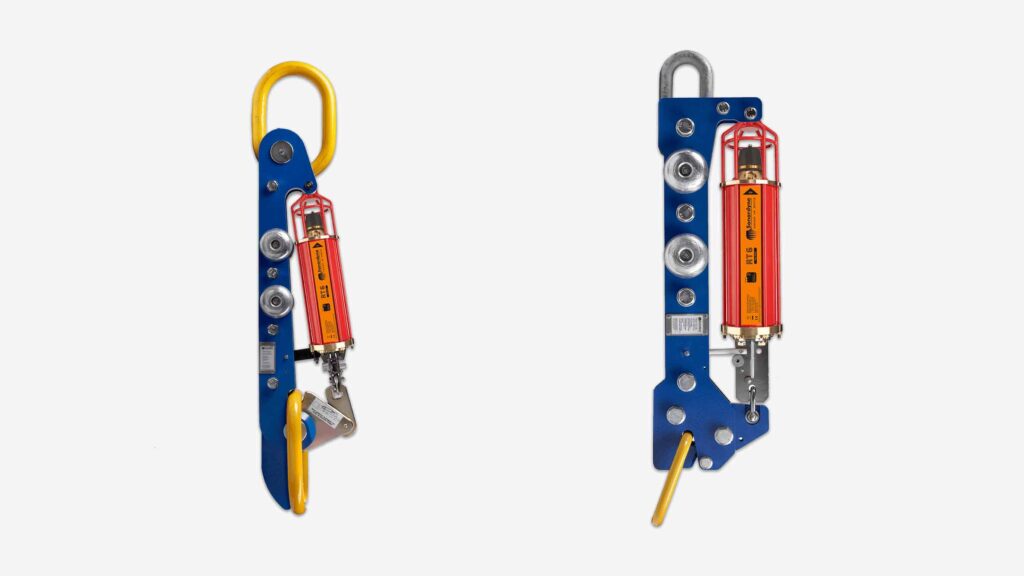
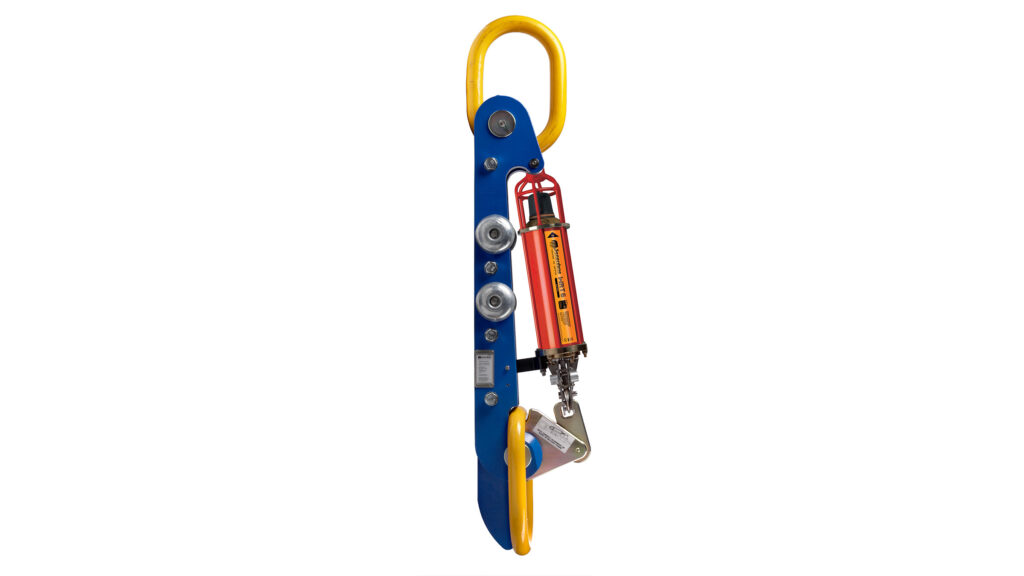
Did you know?
You can use Ranger 2 and Mini-Ranger 2 to release our RT 6 family?
Frequently asked questions
Datasheets
Manuals and quick start guides
Overview
Gyro Compatt 6+ is our combined LBL transponder and AHRS, supporting every stage of your structure installation project. The instrument provides wireless high update rates of attitude, heading, heave, surge, sway, temperature, pressure, SV and acoustic positioning of any subsea object. Deep water structure installation – made easy.
Gyro Compatt 6+ is no longer available for purchase. However, is still available through our hire pool. Contact [email protected] for more information.
At a glance
- Combined LBL transponder and Lodestar AHRS instrument; rugged, ROV deployable design
- Calculates motion and position of any subsea object; use it for structure installation and metrology
- Rechargeable internal battery provides more than a day of continuous use
- Wideband 3 inside; our latest signal protocols delivering fast, efficient operations
- LBL and USBL modes; optimised for Fusion 2 and Ranger 2
- Built to support subsea construction
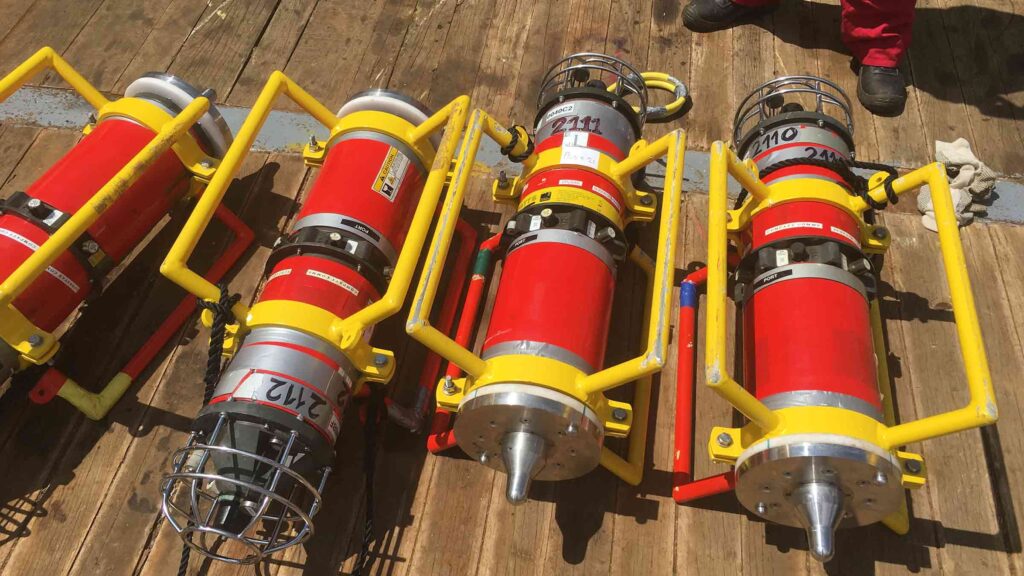
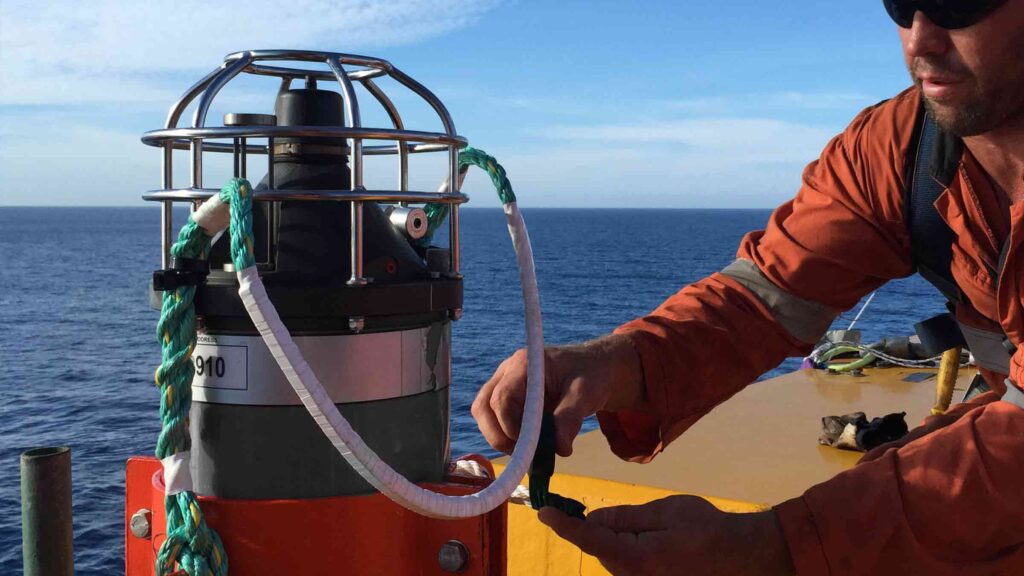
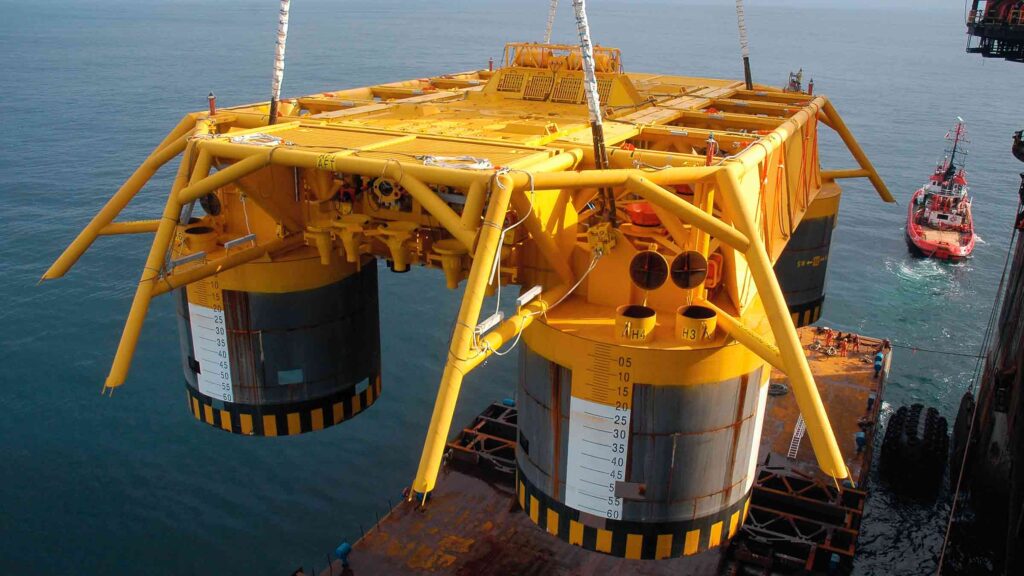
Performance
• Heading accuracy 0.04 to 0.1º Secant latitude
• Ranging precision better than 15mm
• Rechargeable 28 hr internal battery pack
• Simultaneous ranging and sensor data telemetry; requires Fusion 2
• Real time diagnostics on range measurements for quality control
• Autonomous data logging mode
Acoustic, AHRS and Sensors
• MF frequency (19–34 kHz)
• Supports Wideband 3 and Wideband 2 telemetry protocols
• Integrated Sonardyne Lodestar AHRS, factory aligned
• Integrated SV and depth sensors
Design
• Dimensions 918 x 248 mm
• 45/17 kg weight in water/air
• Deploy and recover using ROV
• External AHRS On/Off switch
• Plastic, super duplex stainless steel and anodised aluminium construction. ROHS compliant
Ownership
• What’s in the box: Gyro Compatt 6+, manual
• Warranty: 1 year return to Sonardyne service centre
• ITAR Controlled: No
• UK Export Licence: required; US Export License: covered under de minimis
Specifications table
| Feature | Type 8084 | ||
|---|---|---|---|
| Depth Rating | 3,000 m | ||
| Operating Temperature | -5 to +40°C | ||
| Storage Temperature | -20 to +55°C | ||
| Operational Shock Rating | 22 g, 11 ms half sine | ||
| External Battery Pack / ROV Supply | 24 V (20–50 V) | ||
| Battery Life | Acoustic Navigation Standby | 3 months | |
| Lodestar Permanently Powered On | 28 hours | ||
| Acoustic | Compatt 6+ | Operating Frequency | MF (20–34 kHz) Sonardyne Wideband 3 |
| Transmit Source Level (dB re 1 µPa @ 1m) |
185–192 dB (5 Levels) | ||
| Ranging Precision | Better than 15 mm | ||
| Telemetry Protocol | Sonardyne SMS and modem | ||
| Ranges Tracked | 14 simultaneous replies | ||
| Lodestar AHRS | Heading | Range | 0–360° |
| Accuracy | 0.04 to 0.1° secant latitude | ||
| Settle Time | <5 minutes | ||
| Follow Up Speed | 500° / second | ||
| Resolution | 0.01° | ||
| Roll and Pitch | Range | ±180° (no physical limit) | |
| Accuracy | 0.01° | ||
| Resolution | 0.01° | ||
| Heave | Range | ±99 m | |
| Accuracy (Real Time) | 5 cm or 5% (whichever is the greater) | ||
| Bandwidth | User selectable | ||
| Resolution | 0.01 m | ||
| Digital Output – Output Telegram (e.g. for ROV LED display) | Yes | ||
| ROV Switch – Contact Closure | Yes | ||
| Data Back-up – Data Logger | 8 GB (expandable to 32 GB) internal memory to allow post processing | ||
| Remote Transducer – For ROV Applications, a Remote Transducer is Available | |||
| Sensors | Sound Speed Sensor | ±0.03 m/s | |
| Pressure – Strain Gauge or Digiquartz | 0.01% FS | ||
| Physical | Size (Diameter x Length) | 248 x 918 mm | |
| Weight in Air/Water | 45/17 kg |
Frequently asked questions
How to set the latitude on a Gyro Compatt 6
Why am I getting old / incorrect data from my GyroCompatt 6+?
How to turn on a Lodestar Gyro Compatt using Ranger 2 or Fusion 2
I’m outputting a GGA from Fusion 2 / Ranger 2 to NaviPac but the position isn’t appearing in the correct location?
If I’m using Fusion 2, can I choose to use Wideband 2 or Wideband 3 telemetry?
How to plan my sparse LBL array (guidance note)
How do I perform a SLAM calibration in Fusion 2?
How do I perform an LBL calibration in Fusion 2?
Software and firmware
Software and control hardware
Datasheets
Manuals and quick start guides
Designed to work in any depth
From less than 1 m in the transition and surf zones to 3000 m for ultra-deep-water seismic applications.
Our shallow and deep rated acoustic positioning systems improve the speed, accuracy and efficiency of positioning seabed marine seismic nodes and cables, enabling the positioning of thousands of transponders in parallel with deployment and shooting operations.
The system uses a network of low cost, rugged transponders that can withstand fast deployment through mechanical ‘squirters’ to provide users with an efficient method of collecting the positions of thousands of seabed nodes in real-time.
A typical system comprises of acoustic positioning transponders attached to the seismic node or cable and a vessel or USV based acoustic range only or full USBL transceiver interfaced to a PC running our HydroPos seismic positioning control software application. Third party software applications that incorporate an acoustic control module can also be used with the system.
Once the nodes are deployed on the seabed, the system precisely measures the acoustic range (distance) or 3D position (USBL) from a surface transceiver on the pinging vessel to each transponder to enable its exact position to be established. The range and USBL positioning processes are more accurate than traditional first break techniques, 1-2 m absolute, and can either be conducted during node or cable deployment operations or later whilst shooting.
Configurations
Shallow water (range only or full USBL)
Uses HF band vessel or USV-mounted TZT or HPT2000 USBL system with Transition Zone Transponders and LRTs attached to seismic nodes or ocean bottom cable receivers. Offers ranging precision of better than 50 mm in up to 500 m water depth.
Deep water (range only or full USBL)
Uses MF band vessel or USV-mounted TZT or HPT 5000 USBL system with SST 6 and RT6-1000 transponders. Offers ranging precision of better than 15 mm in up to 3,000 m water depth.
OEM integration
Get all the benefits of of our deep water system but with an OEM version of our SST 6 integrated in to your seismic node.
At a glance
- Enables you to position thousands of nodes or cabled seismic receivers in real-time
- Operational in 1 to 3,000 m of water
- Uses low cost acoustic transponders and acoustic releases
- Scalable for both small and large surveys
- Scalable for both small and large surveys
Transponders
The transponders developed for the system are small and lightweight and are proven to withstand the demanding and varied operational environment of surveys.
Standard features of the popular Type 7815 TZ Transponder include a depth rating of 500 metres, a unique acoustic ‘address’ enabling thousands of units to be laid in a single deployment and battery voltage monitoring to allow users to better plan their maintenance schedules. TZ Transponders operate in the HF band.
The LRT is a release transponder option for this system. It incorporates an acoustic release mechanism and is typically used at rope or cable ends to aid recovery of seabed seismic equipment after shooting is complete.
SST 6 incorporates our Wideband 2 digital acoustic signal processing architecture ensures robust positioning performance with high levels of ranging precision. It can be provided in 1,000m and 3,000m depth rated housings and is fitted with a handy Near Field Communications (NFC) link as standard for programming and battery status checking.
RT 6-1000 is a release transponder option for this system. It incorporates an acoustic release mechanism and is typically used at rope or cable ends to aid recovery of seabed seismic equipment after shooting is complete.
Both SST 6 and RT 6-1000 are MF band transponders, compatible with our family of Ranger USBL acoustic positioning systems.
Transceivers
Two surface transceiver options are available for this system. TZ Transceiver (TZT) is small and lightweight making it perfect for use vessels-of-opportunity and uncrewed surface vessels which are increasingly being used in support of offshore seismic operations. It can operate in the HF or MF frequency band.
TZT is able to interrogate and calculate acoustic ranges to nine TZ Transponders or 95 SST 6 transponders at a time.
HPT 2000 (HF) and HPT 5000 (MF) are USBL transceivers configured to measure range and bearing to TZ Transponders and SST 6 transponders respectively. They are particularly well suited to high elevation tracking scenarios and offers true simultaneous tracking of multiple transponders providing superior position update rates.
Our team is here to advise you which configuration of transponders and transceivers your offshore seismic positioning system should be configured with to meet to operational requirements.
Design
• Incorporates almost three decades of operational and client feedback
• Supports new generation (6G) and legacy hardware transponders inventories – thousands in service globally
• Suitable for small survey vessel or USV operations; safer, greener, lower cost
• Works with all major seismic software platforms
• Optional asset tracking with transponder RFID technology
Performance
• Operate in <1 m to 500 m water depth • Operates in with Sonardyne HF (35-55 kHz) or MF (19-34 kHz) bands • Up to 18 month battery life for TZ/OBC transponders • Position 3,600 transponders in real time • Range-range or range-bearing (USBL) operating configurations available
Datasheets
Manuals and quick start guides
Support is just a click away
Remote Offshore Access Module (ROAM) delivers you a suite of Sonardyne operational survey services without us physically attending your worksite.
Our experienced engineers can provide help with your calibrations, box-ins, system health checks and more at the click of a button. Using ROAM, Sonardyne engineers located anywhere in the world can provide you with expert, pre-arranged technical guidance during live marine operations, simplifying travel logistics, decreasing environmental impact and reducing your operational costs.
This one-box, pay-as-you-go solution can be used to access a range of Sonardyne systems used within the offshore energy, science and defence sectors. Depending on the services required, ROAM can interface to Fusion 2 LBL, Fusion 2 INS, Ranger 2 USBL, Sentinel IDS, Vigilant FLS and other Sonardyne systems.
At a glance
- Less people offshore reduces risk, costs and logistics
- Connects your offshore team to our experts onshore
- No need to pay for engineers waiting offshore; remote engineers can stand down during non-operational periods
- Safe and secure: you’re in control of our access to your Sonardyne system
- Adaptive communications; automatically switches between communication links
- ROAM operates on a monthly charge enabling for easy OpEx accounting
- PAYG remote operational support
PAYG remote operational support
ROAM allows our engineers to take control and operate your Sonardyne system as though they were in the control room with you.
ROAM achieves the remote connections by setting up an online portal through a secure VPN connection. The hardware then connects via either cellular data connections, Wi-Fi or your satellite communications, and can be configured to automatically switch between these connections, minimising the risk of disruption in the sea-to-shore link, and ensuring the most effective service is being used. All access is logged, and remote sessions are tracked allowing for a full audit trail.
Sonardyne engineer access via ROAM to your equipment can be restricted or removed by you at any time providing you with full control. If required, we can also arrange a portal for your engineers to access your systems on the vessel via the ROAM box.
By not having to travel to support your operations, we’re all helping to cut down the emissions footprint associated with working offshore, less flights, car journeys, boat and helicopter transfers. There’s also no delays or costs in arranging travel, security or visas
Specifications
| Feature | Specification |
|---|---|
| Dimensions | 240 x 180 x 90 mm (9.4 x 7.1 x 3.5”) |
| Cable length (Ethernet) | 2 x 5 m |
| Weight | 1.3 kg (2.9 lbs) |
| Power | 240 V ac |
| Supported Communication Networks | Customer satellite system via vessel network, 3G, 4G or Wi-Fi |
| Service and Pricing Structure | ROAM is rented on a 30-day basis. Engineers work 12-hour shifts. The 30-day rental includes 2 free of charge engineer shifts, additional shifts will be charged extra |
Frequently asked questions
Datasheets
Design
• Supplied in rugged, splash-proof carry case
• Integrated router, antennas, glanded ethernet cables
Communications
• Supports 3G, 4G, LTE, WiFi and your satellite via LAN
• Requires client-supplied service if connecting via satellite
• Extra data charges apply when using 3G, 4G, LTE
• Cloud portal offering secure sea-to-shore access
Ownership
• ROAM hardware remains property of Sonardyne
• Flight carry-on: Yes
• ITAR Controlled: No
• UK Export Licence: Not required
• What’s included (charged per month): rental of ROAM hardware, secure customer portal account, 2 x 12 hour shifts per month (additional shifts pay-as-you-go), user documentation
Example operations
• Compatt box-in
• Baseline calibration
• SLAM calibration
• Ranger 2 USBL calibration
• Fusion 2 LBL and SPRINT INS operational services
• System optimisation
